October 18 - 24, 2020: Issue 470
Harry Wolstenholme
June 21, 1868 - October 14, 1930
Ornithologist Of Palm Beach, Bird Man Of Wahroonga
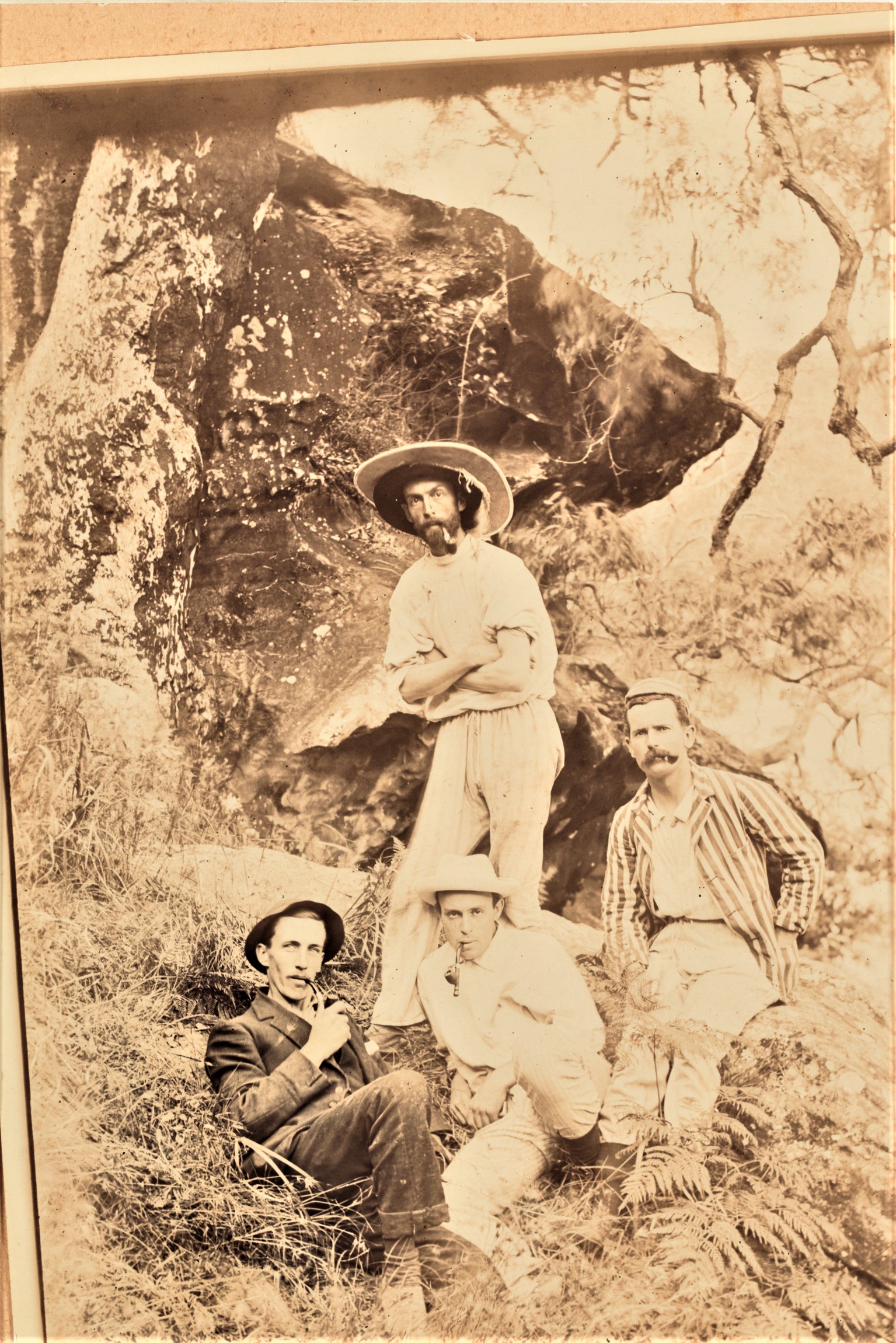
17. [Four men posing in bush, Harry Wolstenholme standing] Kuring-Gai Chase National Park, 'Xmas of 1893 - Item: c051620023, from ''Album of photographs of Ku-ring-gai Chase National Park and Wolstenholme family, 1893-1896 / probably compiled by Harry Wolstenholme'', courtesy Mitchell Library, State Library of New South Wales
It is important to remember this as residents contribute to the 2020 Australian Back Yard Bird Count - that it is those who live here and regularly photograph or note the return of annual birds along international flyways, as well as observing those that are permanent year-round residents on our shores, in our bush reserves, and in their own back yards, that help those seeking to protect these species. The ongoing work of the Powerful Owl Project, which had its origin in our area, serves as one example, while ANTSO and UNSW scientist Dr Kate Brandis calling for bird feathers to be sent in to collate data on estuarine and wetlands birds, provides another.
The presence or sudden absence of birds in habitats where they once were, and reporting this, is one sure method of ensuring where there is a problem, what is causing the problem, and how that may be addressed. In this we are all custodians and can help look after this years chicks and fledglings to ensure the survival of the gene pools of these birds that live here, in Pittwater.
Under NSW State Law all species of wildlife are protected. In notifying local and state authorities where and when a bird has been put at risk, attacked, or even driven from its home, you provide an opportunity for that birds' others to not experience the same. In looking after all the wildlife that makes an environment healthy, we are not only ensuring the survival of species, including our own, we are staking a claim for yet to be born generations getting to experience first-hand the wonders we are now enriched by.
For the 2020 Aussie Back Yard Bird Count (October 19-25) and National Bird Week 2020 insight into local birds and those who worked to protect them, simply through celebrating them, another local connection in Palm Beach resident, and one of the original Directors of the Barranjoey Land Company, the first-born son of Maybanke Selfe-Wolstenholme-Anderson features this year.
Harry Wolstenholme was born in 1868 to Edmund Kay Wolstenholme and Maybanke (nee Selfe). Maybanke's Marriage Notice:
Sept. 3rd, at St. Philip's Church, Sydney, by the Very Rev. the Dean, Edmund Kay, eldest son of James Wolstenholme, of West Maitland, to Maybank Susannah, only daughter of the late Henry Selfe, of Warragamba, and Lower Fort-street, Sydney. Family Notices (1867, September 7). The Maitland Mercury and Hunter River General Advertiser (NSW : 1843 - 1893), p. 1. Retrieved from http://nla.gov.au/nla.news-article18726451
The children of the marriage;
WOLSTENHOLME HARRY 11578/1868 EDMUND K MAYBANKS S MAITLAND
WOLSTENHOLME JAMES HERBERT 2993/1870 EDMUND K MAYBANK S BALMAIN
WOLSTENHOLME ARTHUR BARON 3286/1871 EDMUND K SUSANNAH M BALMAIN
WOLSTENHOLME HILDA 3166/1874 EDMUND K MAYBANK S BALMAIN
WOLSTENHOLME NORMAN SELFE 6006/1876 EDMUND K MARYBANK S ST GEORGE
WOLSTENHOLME BERTHA 6620/1878 EDMUND KAY MAYBANK SUSANNAH ST GEORGE
WOLSTENHOLME EDMUND KAY 7515/1879 EDMUND KAY MAYBANK SUSANNAH ST GEORGE
Only Harry, Arthur and Edmund survived to adulthood. James, Hilda, Norman and Bertha died very young, some sources stating from diseases relating to T.B. that impacted on their hearts:
WOLSTENHOLME—June 21st, at Hannan-street, West Maitland, Mrs. E. K. Wolstenholme, of a son. Family Notices (1868, July 15). The Sydney Morning Herald (NSW : 1842 - 1954), p. 8. Retrieved from http://nla.gov.au/nla.news-article13169432
On the 26th March, at Fairlea, Balmain, Mrs. E. K. WOLSTENHOLME, of a son. Family Notices (1870, April 6). The Sydney Morning Herald (NSW : 1842 - 1954), p. 1. Retrieved from http://nla.gov.au/nla.news-article13203203
His mother worked as a teacher while his father, after leaving his family, returned to his place of origin near Cowra. He became a pupil at Newington College (1881–1885) with many accolades - in 1883, 1884 and 1885 he was awarded the Wigram Allen Scholarship, awarded by Sir George Wigram Allen, sharing it in 1885 with Herbert Curlewis. At the end of 1885 he was named Dux of the College and received the Schofield Scholarship:
HARRY WOLSTENHOLME, who has achieved such conspicuous success at the recent senior examination, is the eldest son of Mrs. Wolstenholme, of Maybanke School, Petersham, and was educated at Newington College. He is 18 years of age, having entered the college in July, 1882. He passed the junior examination in 1888, with five A's. and two B's., and won the silver medal for geometry. He gained the Wigram Allen scholarship at Newington College in 1883 and 1884, and the Schofield scholarship in 1885, in addition to numerous medals and books at the various college examinations. His record in the Senior is probably unprecedented, as he has passed in 11 subjects, being marked A in all but one, in which he has B. He also takes the medals in Greek, Algebra, trigonometry, chemistry, and French, as well as the John West gold medal, and the University prize of £20 for general proficiency. It is hoped that this brilliant success is the Prelude to an equally distinguished University career, and a life of usefulness to the colony of which he is a native. NEWS OF THE DAY. (1886, December 4). The Sydney Morning Herald (NSW : 1842 - 1954), p. 11. Retrieved from http://nla.gov.au/nla.news-article13622134
At the University of Sydney he graduated B.A. in 1890. Harry Wolstenholme married Edith Lucy Doust (1875-1947) on 8 January 1902 in the Methodist Church, Stanmore. Lucy was a former student of his mothers', the sister of Stanley Doust and was an early female graduate at the University of Sydney and a tennis player with whom he had played matches prior to their marriage. Stanley Norwood Doust (29 March 1878 – 13 December 1961) was an Australian tennis player who captained his nation's Davis Cup team in 1913 and was winner of the Mixed Doubles Trophy at Wimbledon in 1909. Isaac Doust was a landowner and property developer, his wife was Lucy Ellen (née Dunlop).
An album donated to the State Library of NSW (Ku-ring-gai Chase National Park and Wolstenholme family, 1893-1896 / probably compiled by Harry Wolstenholme, donated by John Wolstenholme in 2014) shows Edith in a family group years before they married:
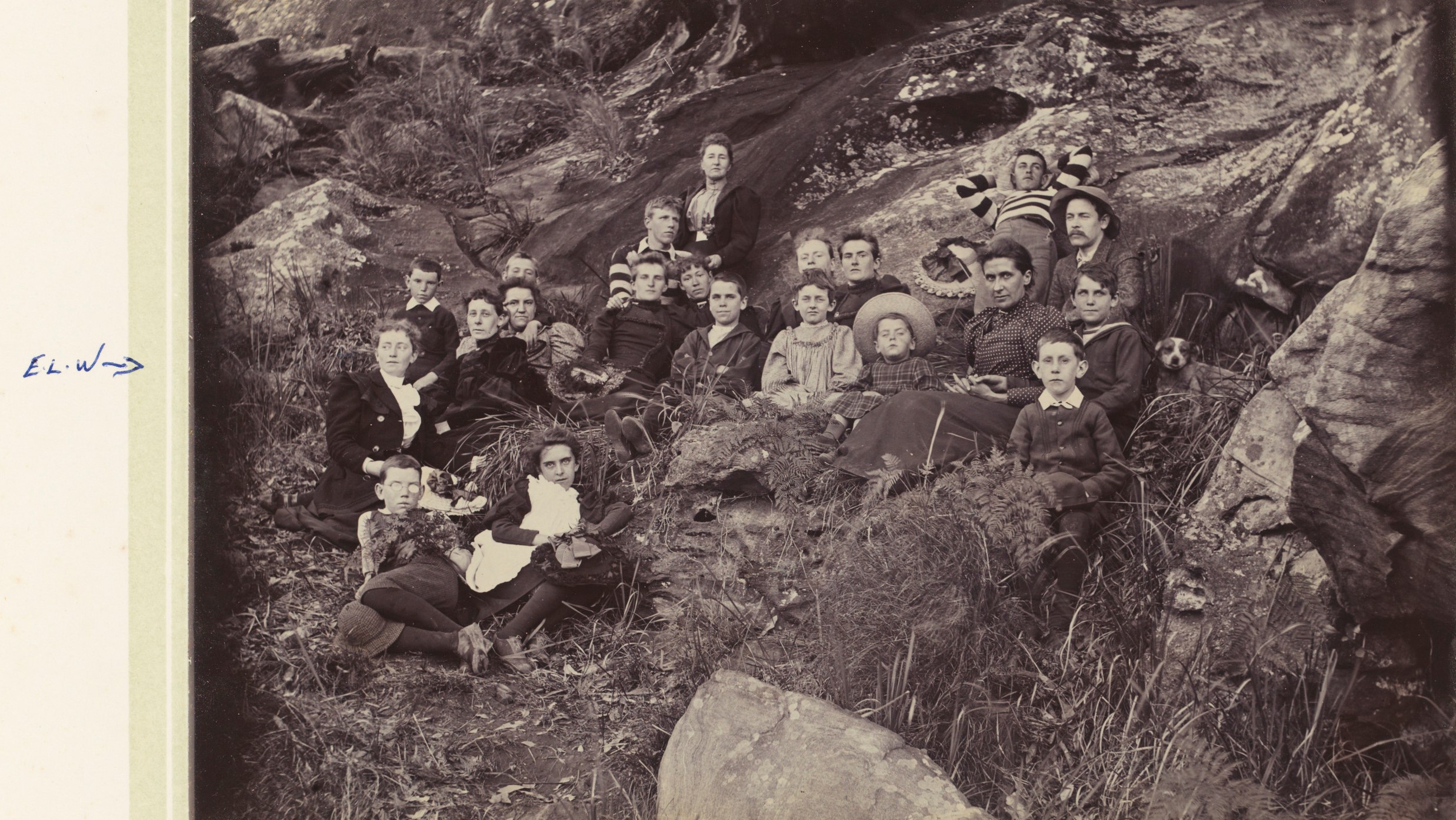
Item: c051620039 from Harry Wolstenholme album, circa 1894, courtesy Mitchell Library, State Library of New South Wales
WOLSTENHOLME - DOUST.—January 8, 1902, at the Wesleyan Church, Stanmore, by the Rev. E. J. Rodd, assisted by the Rev. J. E. Carruthers, Harry Wolstenholme, of Sydney, to Edith Lucy, daughter of Isaac Doust, of Wyroolah, Dulwich Hill. Family Notices (1902, February 5). The Sydney Morning Herald (NSW : 1842 - 1954), p. 1. Retrieved from http://nla.gov.au/nla.news-article14445797
The marriage of Mr. Harry Wolstenholme and Miss Edith Doust, eldest daughter of Mr. Isaac Doust of Wyroolah, Dulwich Hill, took place in the Wesleyan Church, Stanmore, on January 8th. The Revs. E. J. Rodd and J. E. Carruthers performed the ceremony.
The bride wore a lovely duchesse satin gown and was supported by three bridesmaids, Miss Bessie Selfe and two little girls, Lena and Dorothy Doust, who were all dressed in white. After the ceremony a reception was held at Wyroolah, where many friends assembled to wish the bride and bridegroom happiness.
Among those present were Professor and Mrs. Anderson, Mr. J. and Mrs. Perry, Mr. and Mrs. Baker, Mrs. H. A. Russell, Mr. and Mrs. Hicks, Mr. Norman Selfe, Mrs. Caro, Mr. and Mrs. Hague Smith, Mrs. Adams, Misses Trevor Jones, Humphries, Booth, Jones, Mr. R. and Miss Cowlishaw, Mr. Wallis, Mr. and Mrs. Ducker, Misses Larke, Robson, and Wise. The bride travelled in a dainty green Harris lace, trimmed with twine lace and insertion, and a hat of burnt straw trimmed with deep red roses. Mr. and Mrs. Wolstenholme left for Bay View, where Professor and Mrs. Anderson placed their home at their disposal. WOMAN'S COLUMN. (1902, February 1). The Newsletter: an Australian Paper for Australian People (Sydney, NSW : 1900 - 1919), p. 9. Retrieved from http://nla.gov.au/nla.news-article114726739
Prof. Anderson and Maybanke Anderson at 'Maybanke' Bay View - circa 1899 -1890 - photos courtesy Jan Roberts and Marjorie Wolstenholme (daughter of Harry Wolstenholme)
Edith's father passed away at the end of that year, quite young, and suddenly, at Manly - a break by the sea the Doust family seemed to regularly make around the Christmas-New Years time:
Mr Isaac Doust, who was well known in mercantile circles, died somewhat suddenly at Manly on Christmas Day from failure of the heart, supervening on a severe attack of influenza. Mr Doust, who was a native of the Manning River district, was 52 years of age, and had lived an active commercial life. For many years he was in business as a member of the firm of Precious, Doust and Co., importers and general merchants, in this city, but lately he conducted a real estate business. In 1886 Mr Doust represented New South Wales as one of the commissioners at the Indian and Intercolonial Exhibition in London. The news of his death occasioned considerable regret in mercantile circles. QUEENSLAND MINISTERS. (1903, January 3). The Sydney Morning Herald (NSW : 1842 - 1954), p. 9. Retrieved from http://nla.gov.au/nla.news-article14480955
Death at Manly. — Mr. Isaac Doust, of Dulwich Hill, Sydney, eldest son of Mr. E. Doust, of the Paterson, and brother to Messrs. S., E. and P. Doust, of this river, died at Manly, where he was staying, on Christmas Day. No title (1903, January 3). The Manning River Times and Advocate for the Northern Coast Districts of New South Wales (Taree, NSW : 1898 - 1954), p. 6. Retrieved from http://nla.gov.au/nla.news-article172994169
Isaac Doust, 52, well known in mercantile circles, suddenly died at Manly on Christmas Day from failure of the heart, supervening on a severe attack of influenza. The Week's Obituary. (1903, January 7). The Sydney Mail and New South Wales Advertiser (NSW : 1871 - 1912), p. 20. Retrieved from http://nla.gov.au/nla.news-article163779119
We regret to have to record the sudden death, on Christmas Day, of Mr. Isaac Doust, the president of the Petersham Chess Club. Mr. Doust was the founder of this strong suburban club, and the original president, which position he retained throughout. A thorough chess enthusiast Mr. Doust did much to further the development of the game in this State, and although of late years his kindly efforts were discouraged by the unworthy friction which raged unceasingly between leading clubs and players in the metroplois, he remained to the last an ardent supporter of chess. Such disinterested lovers of the game as Isaac Doust are rare indeed, and his place will be hard to fill. NOTES. (1902, December 31). The Daily Telegraph (Sydney, NSW : 1883 - 1930), p. 3. Retrieved from http://nla.gov.au/nla.news-article236808549
Her mother passed away soon afterwards, also very young:
DOUST.— May 30, at Killara, Lucy Ellen, relict of the late Isaac Doust, aged 51 years. Family Notices (1906, May 31). The Daily Telegraph (Sydney, NSW : 1883 - 1930), p. 1. Retrieved from http://nla.gov.au/nla.news-article236826798
Newspaper records of Harry's activities defending many a Balmain resident, including some women teachers who had set up small schools on their own, may indicate he and his new wife were living at the Eversley home owned by his mother prior to moving towards Killara where his son Harry Doust Wolstenholme was born on June 4th, 1906. They had two sons and a daughter, Arthur, possibly named for Harry's lost brother, Marjorie and Harry:
MARRIAGES.
WOLSTENHOLME—MACKENZIE.—April 9, at St. Andrew's, Wahroonga, by the Rev. Stephen Taylor, B.A., Arthur Stanley, elder son of Mr. and Mrs. Harry Wolstenholme, of Wahroonga, to Jeannette Murchison, younger daughter of Mr. and Mrs. John Mackenzie, of Wahroonga. Family Notices (1927, May 7). The Sydney Morning Herald (NSW : 1842 - 1954), p. 14. Retrieved from http://nla.gov.au/nla.news-article16384296
The Engagement Is announced of Mary, second daughter of the late Bishop Long and Mrs. Long, of Killara, to Harry Doust, younger son of the late Mr Harry Wolstenholme and Mrs Wolstenholme, of Palm Beach. Family Notices (1933, November 11). The Sydney Morning Herald (NSW : 1842 - 1954), p. 14. Retrieved from http://nla.gov.au/nla.news-article17023397
In June 1911, just after the tramline to Brookvale opened, a group of businessmen registered the 'Barranjoey Company', and led by John Ralston, succeeded in purchasing the Bassett-Darley Barrenjoey acreage. Some sources state they paid a whopping £500 - the proprietors apparently wanted at least £1900.00 but settled for what they could get. Harry Wolstenholme was one of the original directors:
NOTES AND COMMENTS.
Barrenjoey Company, Ltd, has been registered with a capital of £6000, In 120 shares of £50 each, the object being to purchase 410 acres of the Bassett Darley subdivision. The first directors are Messrs H. Wolstenholme, E T Jones, J T Ralston, J Young, and H R Nolan. NOTES AND COMMENTS. (1911, June 3). The Sydney Morning Herald (NSW : 1842 - 1954), p. 15. Retrieved from http://nla.gov.au/nla.news-article15239859
By 1916 he is recorded as a member of the Royal Australasian Ornithologists' Union and adds to the records of birds seen or heard on outings and at camps:
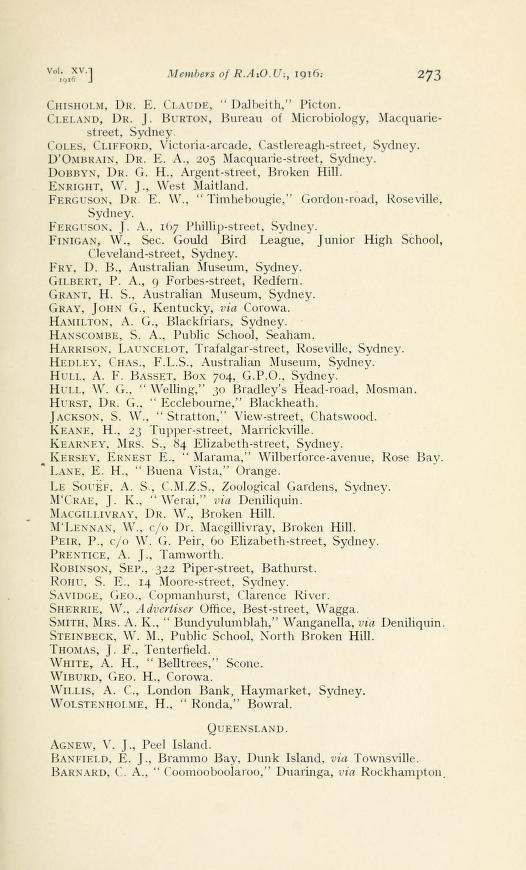
The Emu by Australasian Ornithologists' Union; Royal Australasian Ornithologists' Union; Volume 15, 1915-1916 - recorded as member.
Interestingly, at the same time he is recorded as living near his father, this item appears, showing the difference of opinion around birds - as his father passed away earlier that year, this item refers to Harry's brother Edmund:
THE ORCHARDISTS' FIGHT.
Before the Bathurst Fruitgrowers' Association (Mr. H. S. Wark presiding) in Webb's warehouse, Mr. E. K. Wolstenholme addressed the members on "Starlings and other bird pests." He gave his experience of the starling pest in his orchard, Montavella. He had lost 300 or 400 cases of fruit owing to the starling pest this year. Gun shots had not daunted these birds, nor had any struchnine any great effect in lessening the fruit destruction. The systematic effect of poisoning fruit merely had the effect of causing the birds to change their rendezvous. Mr. Wolstenholme was just devising a terrible scheme of arsenic' poisoning when the recent rain came. The rain signalled the departure of the starlings from the orchard. Since the rain he had not had the slightest trouble with starlings. Most of them were now out in the paddocks. Mr. Wolstenholme's idea was that the lack of rain had reduced the supply of the usual food for the starlings, and they had resorted to fruit. The starling was going to cost the orchardist a great deal of money. He had examined the stomach of a dead starling, and found spiders, crickets, beetles, and grain, and a great amount of fruit pulp. Crows, Mr. Wolstenholme had found to be particularly fond of pears. One could make as much uproar with ammunition as he liked, but the crows would take no notice. Strychnine was impossible, for he had never found one crow in his poison traps. Rosellas had not troubled his orchard much. He thought their intelligence, however, far below the ordinary starling, in spite of their powers of mimicry. Bird Pests. (1915, April 24). Leader (Orange, NSW : 1899 - 1945), p. 5. Retrieved from http://nla.gov.au/nla.news-article119915549
Edmund passed away in 1915 at Cowra. According to reports on his funeral, his two surviving sons and one nephew attended. He had been living there for at least 25 years. What he did between times is alluded to as 'various occupations'. He is not listed among the guests at his sons weddings, although may have been present:
Death of Mr. E. K. Wolstenholme
News has been received by his relatives in Maitland of the death of Mr. E. K. Wolstenholme, eldest son of the late James Wolstenholme. He was a native of West Maitland and was 72 years of age. He lived in retirement and had been a resident of Cowra for the past 25 years. Death of Mr. E.K. Wolstenholme. (1915, February 3). The Maitland Daily Mercury (NSW : 1894 - 1939), p. 4. Retrieved from http://nla.gov.au/nla.news-article123075320
THE LATE E. K. WOLSTENHOLME.
The death occurred somewhat suddenly on the 3rd inst. at the local Hospital of Edmund Kay Wolstenholme, a resident of some 25 years standing. For many years he followed various avocations, but being in receipt of a private income he retired some little time back and lived a very quiet life. He was 72 years of age, and a native of Maitland. The remains were interred in the Presbyterian portion of the local cemetery on Thursday morning, the chief mourners being Messrs. E. W. Wolstenholme (orchardist, Bathurst), H. Wolstenholme (barrister, Sydney), sons, and Mr. Young (Sydney) nephew. THE LATE E. K. WOLSTENHOLME. (1915, February 6). Cowra Free Press (NSW : 1911 - 1921), p. 4. Retrieved from http://nla.gov.au/nla.news-article99691766
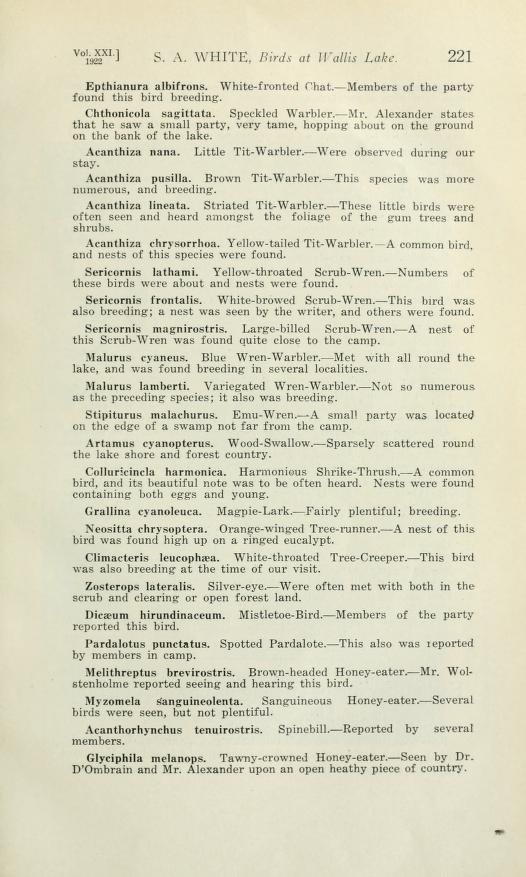
The Emu by Australasian Ornithologists' Union; Royal Australasian Ornithologists' Union, Volume 21, 1921-1922
The State Library of NSW album 'Ku-ring-gai Chase National Park and Wolstenholme family, 1893-1896' is interesting in that its dates and some of those appearing in the photos dates from the gazettal of this park, even nearby neighbour on the North Shore Eccleston du Faur appears among these and although the bulk of them are family photos or show Harry and friends on fishing trips, usually around Christmas time or in October, the presence of these indicates an association with, and love for, Kuring Gai Chase National Park even as it was established in December, 1894.
Harry seemed to have a lot of his mother's gentleness combined with her own temerity and will to persevere. His defence of birds was a lifelong occupation and he found time, although always tried to remain 'behind the scenes' always - perhaps to avoid the spotlight and loss of privacy that had been cast on his mother throughout her suffragette work, to change what was seen by many as a rapidly being destroyed urban parkland as suburbs expanded, along with the loss of wildlife in these areas. The Birds and Animals Protection Act, 1918 (Act No.: 21) to repeal the Birds Protection Act, 1901, and the Native Animals Protection Act, 1903 ; to amend certain other Acts; and for other purposes consequent thereon or incidental thereto. [Assented to, 12th September, 1918.] was an updated means of ensuring birds and animals were not hunted with dog and gun and killed. It provided for 'eyes everywhere' on this and empowered appointed Rangers with these powers;
Rangers.
11 . Every member of the police force shall by virtue of his office be a ranger, and the Minister may from time to time appoint honorary rangers who shall have the same powers and duties as rangers under this Act.
12. Any ranger who has reason to suspect that a breach of any of the provisions of this Act or the regulations has been committed, and that any bird or animal in respect of which such breach has been committed is likely to be in any tent, house, vessel, boat, conveyance, or other place, may enter and search, and seize any such bird or animal found therein.
13. Every ranger is hereby empowered, for the enforcement of the provisions of this Act, to exercise the powers and authority of a constable, and may at all times and seasons, without any let or hindrance whatsoever, enter any land or premises, and examine any nets, traps, or other instruments which are being used or could be used in contravention of this Act, and do all such other acts and things as he is required to do by this Act or the regulations; the production by him of. his appointment shall be sufficient warrant for so acting.
14 (1) Any ranger may require any person reasonably suspected to be; offending against any of the provisions of this Act or of the regulations to give his name in full and place of abode.
(2) If such person, after being so required, and on production of the necessary authority, refuses to give his real name or place of abode, or gives a false or fictitious name or place of abode, he may be at once arrested and taken before a court, and shall be liable for every such offence to a penalty not exceeding five pounds.
15 . If any person is found offending against the provisions of this Act, and refuses to deliver up any bird or animal, instrument, gun, net, or other means of destruction or capture to any ranger who may demand the same, such ranger may, with any assistance he may require, take such person into custody and take him before any court to be dealt wit h according to law.
16 . Any person who assaults, resists, or obstructs, or encourages any other person to assault, resist, or obstruct, or who uses abusive language to a ranger, or to any other person in the execution of his duty or authority under this Act or the regulations, shall be liable to a penalty not exceeding ten pounds.
You would, today, need an iron spine to take on such a voluntary position with so many reacting adversely and with threats and even assault when caught out doing the wrong thing in the wrong place at the wrong time - however, in these more respectful of the laws eras people did not hesitate to take on the position, there were many in Pittwater who did so well into the 1950's, and thereby saved a lot of wildlife - Harry Wolstenholme was an early helper, as was his mother:
BIRDS AND ANIMALS PROTECTION ACT, 1918.
Honorary Rangers.
THE undermentioned, have been appointed by me as Honorary Rangers, in pursuance of the provisions of section 11 of the Birds and Animals Protection Act, 1918, viz.:— t
Mr. Harry Wolstenholme, of Maybank, Junction road, Wahroonga.
Mr. Percy Albert Gilbert, of Dacelo, Colin-street, Lakemba.
Mr. Thomas Dunbabin, of 46 Musgrave-street, Mosman.
Mr. John Simeon Pearson Ramsay-, of Calia, Selborne- street, Burwood.
Mr. Camden William Chisholm, of Uyeno, Woodward avenue, Strathfield.
Mr. James Roy Kinghorn, of the Australian Museum. College-street, Sydney.
Mr. Henry Sneddon Grant, of the Australian Museum, College-Street, Sydney.
CHARLES W. OAKES,
Chief Secretary and Minister of Public Health. BIRDS AND ANIMALS PROTECTION ACT, 1918. (1922, September 29). Government Gazette of the State of New South Wales (Sydney, NSW : 1901 - 2001), p. 5331. Retrieved from http://nla.gov.au/nla.news-article22206059
And of course the wildlife, including all birds, knows who is for them and will sit still long enough for you to marvel:
Wahroonga Man Tames Wild Birds
Getting on good terms with wild birds is not merely dependent 0n environment and goodwill; you must be prepared also to exercise plenty of patience. One of the prettiest examples of the success of this policy is presented by Mr. H. Wolstenholme, of Wahroonga. I have had something to say previously of the happy relations established by Mr. Wolstenholme with various "wild" birds (writes A. H. Chisholm in the ''Daily Telegraph") but the subject is worth detail. What is to be said of a home at which jacky winters, yellow robins, thrushes, blue wrens, and two kinds of honey birds come fearlessly to be fed, either hopping about their host's feet or taking food from the hand? There is, indeed, a suggestion of Utopia developed when one sees four brown fly-catchers (jacky winters), perched on a paddock fence, fly swiftly towards a couple of men and flutter daintily within arms length, mutely appealing for cheese crumbs, and then smartly catch them in mid-air. One of the small honey-eaters also performs this catching trick; but the yellow robin, the thrush, and the yellow eared honey-eater ("orange bird" of the north) fly directly on to an out-stretched hand, there to take either cheese or watered sugar. Frequently the host has had a bird on each hand at the one time — perhaps the honey-bird on the right flicking its long brush tongue in-to the liquid sugar; and the yellow robin on the left, picking up cheese crumbs and ruffling its soft feathers at its neighbor of the other hand. At the present time most of these bird-visitors are not so persistent as they were when nesting; now they are taking life easily, and perhaps roving little. Contrariwise, the yellow-eared honey-bird stayed severely away when brooding; he disappeared in November, and only recently returned to the house, after an absence of, roughly, five months. But — here is a pleasant ex-ample of bird memory — he came straight to the outstretched hand and reappearing!
The thrush, too, affords an interesting bit of data. That one bird, a handsome male, has been coming intermittently to be fed for, it is believed nine or ten years. Why the female does not do likewise is a puzzle. At one stage Mr. Wolstenholme tamed a young thrush. The old bird graciously permitted this for a time — even fed the youngster as each sat on a hand — but when he considered the offspring to be big enough to play a lone hand he drove it out of the locality. Another eloquent little observation is the fact that some 45 different kinds of birds have, from time to time, visited a small concrete bath beneath a tap not a dozen yards from a back door of this happy haven on the edge of a Sydney suburb. Wahroonga Man Tames Wild Birds (1924, May 23). The Richmond River Herald and Northern Districts Advertiser (NSW : 1886 - 1942), p. 1. Retrieved from http://nla.gov.au/nla.news-article125953749
Wahroonga was not the only place Harry watched birds - having been a visitor to our area for decades by the time the above appeared, it should come as no surprise that he had knowledge about the birds that would return here annually:
SHEARWATERS ON LION ISLAND.
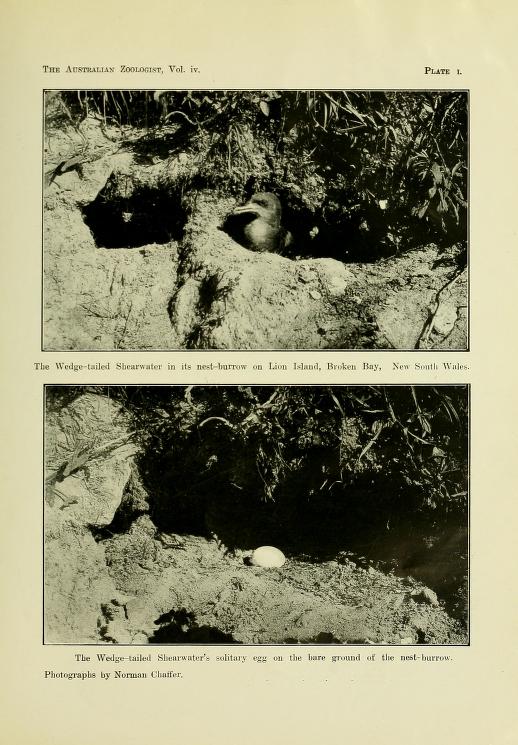
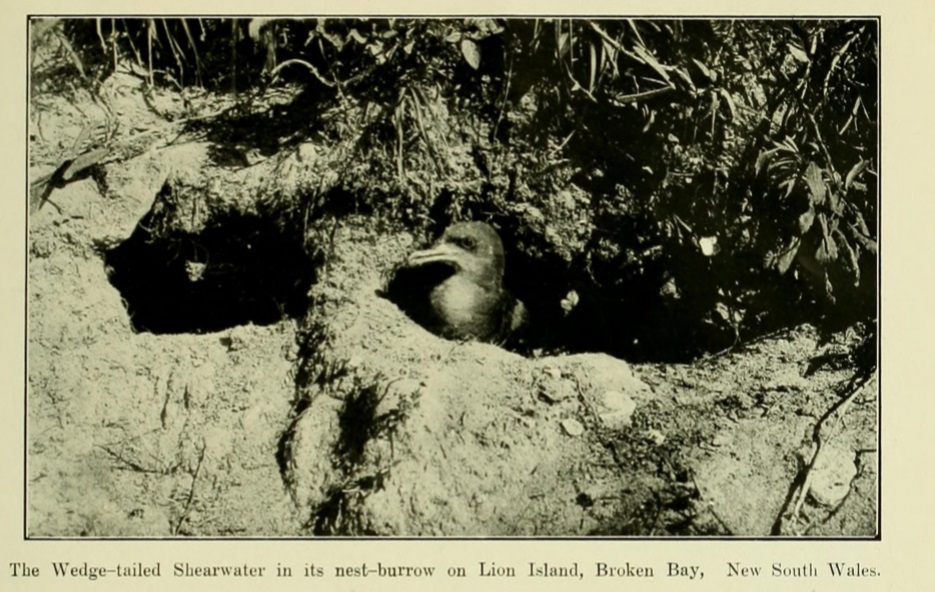
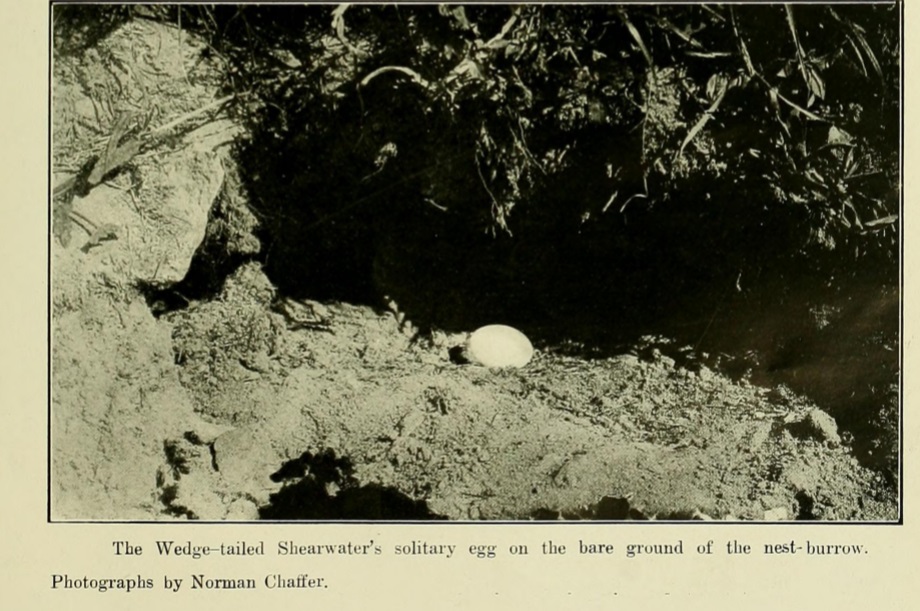
Ornithological Section.
Chairman: A. H. Chisholm.
Vice-Chairman : A. F. Basset Hull
Hon. Secretary: Neville W. Cayley.
Committee: E. A. D'Ombrain. M.B., B.S. P. A. Gilbert, J. R. Kinghom, E. F. Pollock and H. Wolstenholme.
ORNITHOLOGICAL SECTION.
Third Annual Report.
During the year just ended, nine meetings were held, all being satisfactorily attended — an average attendance of fifteen, — at each, lecturettes and addresses were delivered, and some fine bird pliotographs screened, providing- interest and enjoyment.
On August 22nd, 1924, Mr. A. H. Chisholm led a discussion on voice mimicry among Australian birds.
On September 19th, Mr. H. Wolstenholme lectured on "Australian Bird Names and Their Meanings."
On October 17th, Mr. E. J. Bryce gave "Some Observations on Bird- Life in North America."
On November 21st, Mr. A. H. Chisholm reported on the proceedings of the annual Congress of the R.A.O.U., held in Central Queensland during October, and Mr. H. Wolstenholme spoke on the birds observed during that trip.
On January 16th, 1925, Mr. N. W. Cayley contributed "Observations on the Plumage display of some Australian birds."
On February 20th, Mr. Tom Iredale led a discussion on the genus Gery-gone (Fly-eater Warblers).
On March 20th, Mr. David Uniapon, the educated aborigine, spoke of aboriginal myths and legends relating to birds and mammals.
On April 17th, a fine series of pictures of birds, taken by Mr. Otto Webb, of Jaiulowae, Queensland, were shown as lantern slides by Mr. Cayley.
On May 15th, lantern slides from bird photographs were shown, the pictures being by Messrs. D. W. Gankrodger, A. E. Keane and M. Cohn.
On June 19th, Mr. P. A. Gilbert read a comprehensive paper on the "Superb Lyre-bird.''
Members are justly proud of the part the Section played in the establishment of the first Australian Biological Survey Station, and are unanimous in their thanks and appreciation of the generous help afforded the movement by the members of the National Park Trust, especially the wholehearted interest of the Chairman, Mr. Frank Farnell. Acknowledgments are due also to the Council of the Royal Zoological Society for its contribution of £25 towards the expense of furnishing the cabin at Palm Creek, National Park.
At the meeting held on May 15th, Mr. Frank Farnell was presented with a painting of a Lyre-bird as a small acknowledgment of his many courtesies to bird-students.
At the meeting held on June 19th, a presentation was made to Mr. E. Nubling of a painting of a satin Bower-bird, on the occasion of his marriage.
During the year several inter-State visitors and others from country districts were welcomed at meetings.
In conclusion, it may be stated that the cabin is furnished with accommodation for six, and all members of the affiliated Societies are welcome to attend the section's meetings and to use the cabin. Application in the latter case should be made to the Chairman or Hon. Secretary of the Section.
Neville Cayley, Hon. Secretary.
Ornithological Section. (1925)
In submitting the annual report of the Section, we have to say that the year has been a satisfactory one. The lecturettes and discussions have been pleasant and informative, and meetings generally have been well attended. A good deal of interesting material accrued from a trip to the Capricorn islands, Central Queensland, in November, in which several of our members took part.' That was the only expedition of a general nature held during the year, but members individually and in small groups have made frequent visits to the Bird Cabin in National Park, some of these visits extending over several days. The Cabin has proved exceedingly useful in this respect, and it will continue to do so. Up to the present we have not attempted any directly systematic work there, but we hope later to achieve something on a larger scale than hitherto, and to publish a general account of the ornithology of National Park, in the interests of the Park, the public, and ourselves. Workers in other branches of natural history have also used the Cabin, notably a University group who have been attempting an ecological survey. This work is now nearly complete.
If Company expeditions on the part of the Section have not been carried out to any extent, there have at least been many trips by individual members, Mr. Tom Iredale was at Michaelmas Cay, near Cairns, for a month; Mr. E. F. Pollock visited the Bunker Group of Islands; Mr. Ellis Troughton has gone to the Santa Cruz Group ; and Mr. Basset Hull is again visiting New Caledonia.
Interesting bird notes should result from each of these trips.
Members of the Section take pride in the fact that they were instrumental in securing for the Australian Museum, last month, the Grant collection of Australian and foreign birds.
The collection in question contains approximately 3,200 skins of birds, about half of them being of Australian origin, and the others representing many countries. Every continent is represented, and also many islands, notably New Guinea, Borneo, Fiji, the Solomons, Timor, the New Hebrides; Samoa; Ceylon; Madagascar; and the Philippines. All the beauty of the rainbow is contained in the plumage of these birds, and there is a strong interest attaching to many of them by reason of their novelty and rarity.
Perhaps the "show" specimens in the collection are the birds of paradise. Nearly twenty species of these brilliant creatures are represented by about forty specimens. The difficulty of securing paradise birds and their increasing rarity are in themselves facts that emphasise the value of the collection.
These bird skins were got together by the late Robert Grant, for many years taxidermist on the staff of the Australian Museum. Mr. Grant was a very able collector and a skilled taxidermist; he knew what birds to secure and how to look after the skins to the best advantage, and his visits to wild places in the tropics gave him opportunities of securing rare species, he worked on this collection from about 1890 to 1916, so that these birds represent skilled work extending over 26 years.
When Robert Grant died the collection passed into the possession of his son, Henry, who, being also a skilled taxidermist, was able to care for the birds. In time he decided to sell the collection. An offer at once came from South Africa. Then came a bid from the United States, the amount offered being about £750. Mr. Grant was sufficiently patriotic, however, to desire that the collection should remain in Australia. He remembered that Australian students were placed at a disadvantage by the fact that most of John Gould's type specimens of birds were located in Philadelphia, and he did not wish to stress the disadvantage.
It was at this stage that Mr. J. R. Kinghorn, zoologist at the Australian Museum, took up the matter. He organised a small committee from this Section to act with him, and personally communicated with various citizens, pointing out the value of the collection and the wisdom of straining every effort to prevent it leaving Australia. The result was thoroughly gratifying. Five men each gave £100 ; others gave smaller amounts, and within a few weeks Mr. Kinghorn was able to pay Mr. Grant something over £600 and take over the collection at the Australian Museum.
The rarity of many of the species is emphasised by all naturalists who have seen the list, among them Mr. H. L. White, the well known pastoralist-ornithologist, of "Belltrees," Scone, who was one of the donors. Mr. White is very competent to judge on this point, for he has spent much more money on ornithological collections than anyone else in Australia. Among the Australian birds represented are many familiar species, of course, but there are also such rarities as Prince Albert's lyre bird, the rufous scrub bird, the paradise parrot, the turquoisine parrot, the scarlet-chested parrot, the superb parrot, the golden bower bird (a fine series of these beautiful bower birds is included), the black-throated whip- bird, and the lilac-crowned wren.
Some of the birds mentioned are believed to be extinct. In any ease, there is no chance of Australians generally ever seeing them, save in a collection such as this.
Mention of rare parrots recalls the fact that the position of these birds in Australia is something in the nature of a national calamity. The broad-tailed parrots generally appear to be holding their own fairly well, and certain members of other genera are not in danger. But the sad fact is that several of the I'sephotus parrots are almost extinct ; almost every one of the brilliant Polytelis parrots is in grave danger; and practically the whole of the seven members of the Neophemu genus may disappear in the near future. It should be possible to breed up some of these species in well-kept aviaries, under national supervision, with a view to re-establishing them throughout the country. Meanwhile, the survivors should be rigidly protected, and every effort should be made to check exportation.
Members will have noted that there has recently been a good deal of stirring of dry bones in the trusts that control the destiny of certain show places carrying a natural history interest in and about Sydney. The trust of the Australian Museum, constituted by an antiquated act, has come in for a good deal of public criticism, and the responsible Minister has declared his intention of having it remodelled. In that event, it is hoped that the new trust will embrace men who understand museum work, and not include men who chance to be heads of public departments, having no sympathy with museum work. The same thing, broadly, may be said in respect of the National Park and Kuring-gai Chase Trusts.
These also have been publicly criticised, largely because many of the trustees, holding life appointments, never attend meetings or pay the slightest heed to the interests of the reservations. The responsible Minister in this case also is considering the matter of remodelling the Trusts. Perhaps this may lead to the whole question of the conservation of fauna and flora being placed under one department, a thing we advocated some time ago.
Neville Cayley. Hon. Secretary.
Office-bearers for the year 1926-27 were elected as follow : —
Chairman, Mr-. J. R. Kinghorn.
Vice-Chairman : Mr. H. Wolstenholme.
Hon. Secretary: Mr. N. W. Cayley.
Committee: Dr. E. A. D'Ombrain, Messrs. A. H. Chisholm, C. Coles, and A. Musgrave.
The I'sephotus parrots were species such as the Chesnut-crowned parakeet and the Multi-coloured parakeet which were once found in New South Wales, South Queensland, South Australia and Victoria - their nests, as described in the 1901 published book Nests and eggs of Australian birds, including the geographical distribution of the species and popular observations thereon by Archibald James Campbell, and the related species and still present the Red-backed Parakeet, were tree hollows in open forest - most of which were cleared. They were also prey to collectors for their eggs, and as caged birds for those who wanted these as 'pets' as this extract from the same work shows;
519. PSEPHOTUS H'MATONOTUS, Gould. (431)
RED-BACKED PARRAKEET.Figure. — Gould : Birds of Australia, fol., vol. v., pi. 36.
Reference. — Cat. Birds Brit. Mus., vol. xx., p. 567.
Previous Descriptions of Eggs. — Gould : Birds of Australia (1848) , also Handbook, vol. ii., p. 70 (1865) ; North : Austn. Mus. Cat., p. 262 (1889).
Geographical Distribution. — South Queensland, New South Wales, Victoria and South Australia.
Nest. — Within a hole or hollow trunk of a tree, in open forest.
Eggs. — Clutch, six to eight; roundish in shape; texture of shell fine ; surface glossy ; colour, pure white, occasionally stained or soiled with the wood dust of the nest. Dimensions in inches of selected pairs: A(l) -95 x -79, (2) •94x-7-7; B(l) -99 x -73, (2) -92 x -72.
Observation. — The familiar Red-backed Parrakeet is probably the most common of the graceful genus l'sephotus, and is found in the inland or interior tracts of Eastern Australia, where at some seasons, especially during winter, they congregate in flocks of from 150 to 200 birds, making a harvest for bird catchers. On account of its spending most of its time on the ground, it is often called the " grass " Parrot. It makes a good cage bird, its musical whistling notes, as Gould remarks, almost approach a song.
Mr. John Ramsay has taken the eggs of this species as early as 2nd September (1868), at Cardington, on the Bell River.
An incomplete set of four eggs I took from a small dead tree near Pyramid Hill, Victoria, 7th October, 1887. On the same date I saw another nest with three young in down, proving these birds breed early for Parrots. The eggs are common in collections.
The female of this graceful Parrakeet appears solely to perform the task of incubation. I have watched her mate feeding her in or near the nesting hole. He performs the operation somewhat after the manner of a common Pigeon feeding its young, by connecting beaks and discharging at intervals the contents of its crop with spasmodic jerks, while the female keeps up a continual hissing noise.
Breeding months, end of August or September to December.
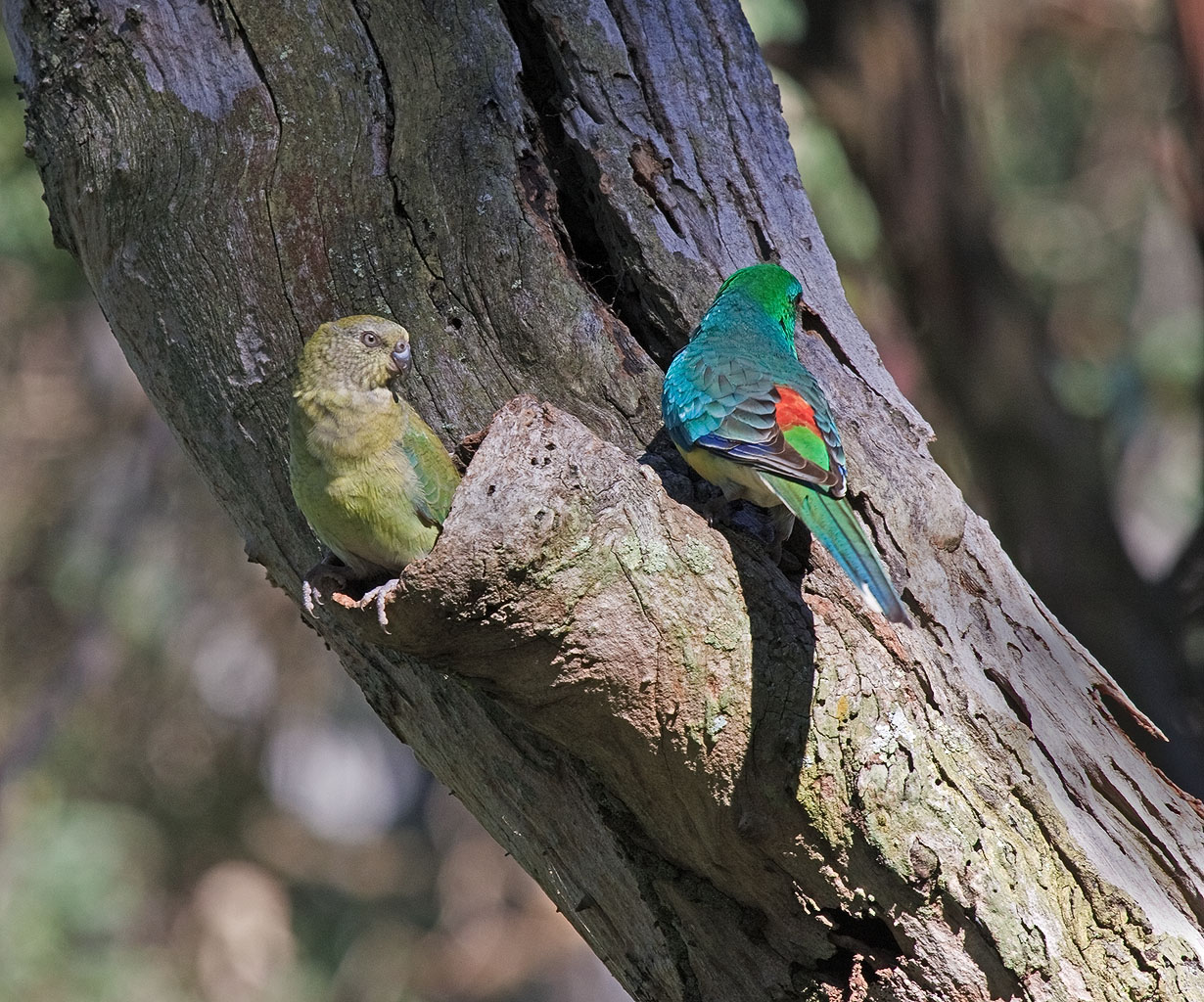
The still present and alive Red-rumped parrots, Platycercus haematonotus; A pair in suburban Sydney (at Baulkham Hills) - photo by Richard Taylor.
The above 1925 Ornithologist Section report also refers to political parties stacking community trusts or 'independent' bodies with politicians or the familiar by now 'jobs for the boys' unwritten policy - a practice which continues to today, despite community circumspection and pessimism being generated as these appointments manifest in serving the interests of those appointed or the political parties and not necessarily the reserves and their wildlife or the human community. Then such practices were reported as:
Preference to Politicians
On the face of things, it would appear that the honorary controlling bodies of such big "playgrounds" as the National Park and Kur-ing-gai Chase should be combinations of business men and naturalists. But it has been a habit in New South Wales to give preference to politicians in such matters— why is not very clear. There have been various agitations on the general point, partly because many of the politicians or ex-politicians on these trusts have failed to attend meetings for several years— and have also failed to send in their resignations. Now, for the first time, naturalists have been added to the trusts.
One of Mr. Loughlin's last acts as Minister for Lands was to appoint Mr. H. Wolstenholme to the Kuring-gai Chase trust and Messrs. A. H. Chisholm and G. M. Goldfinch to the trust controlling National Park. But even on this occasion the ubiquitous politician is well in evidence. The appointments include Mr. R. J. Greig, M.L.A., to Kuring- gai Chase, and Mr. R. J. Stuart-Robertson, M.L.A., to National Park. It is for these two to show that they can beat even the naturalists in activity. Town Topics (1926, December 3). The Daily Telegraph (Sydney, NSW : 1883 - 1930), p. 6. Retrieved from http://nla.gov.au/nla.news-article245921102
The politicians were no longer Trustees when they rewrote the rules for the Chase and had them published at the beginning of 1930 - once again the passion for protecting birds and animals, and aboriginal artefacts, as well as the flora, predominates. That has been transcribed and runs in References in full.
The home at Palm Beach seemed to be a Summer residence which the family would allow friends, including those of his mother, to stay at, including another great lover of birdlife, wildlife, flowers and Kuring-gai Chase National Park, Ella McFadyen. One such article of their home, and their dog, links the two:
.jpg?timestamp=1544130612932)
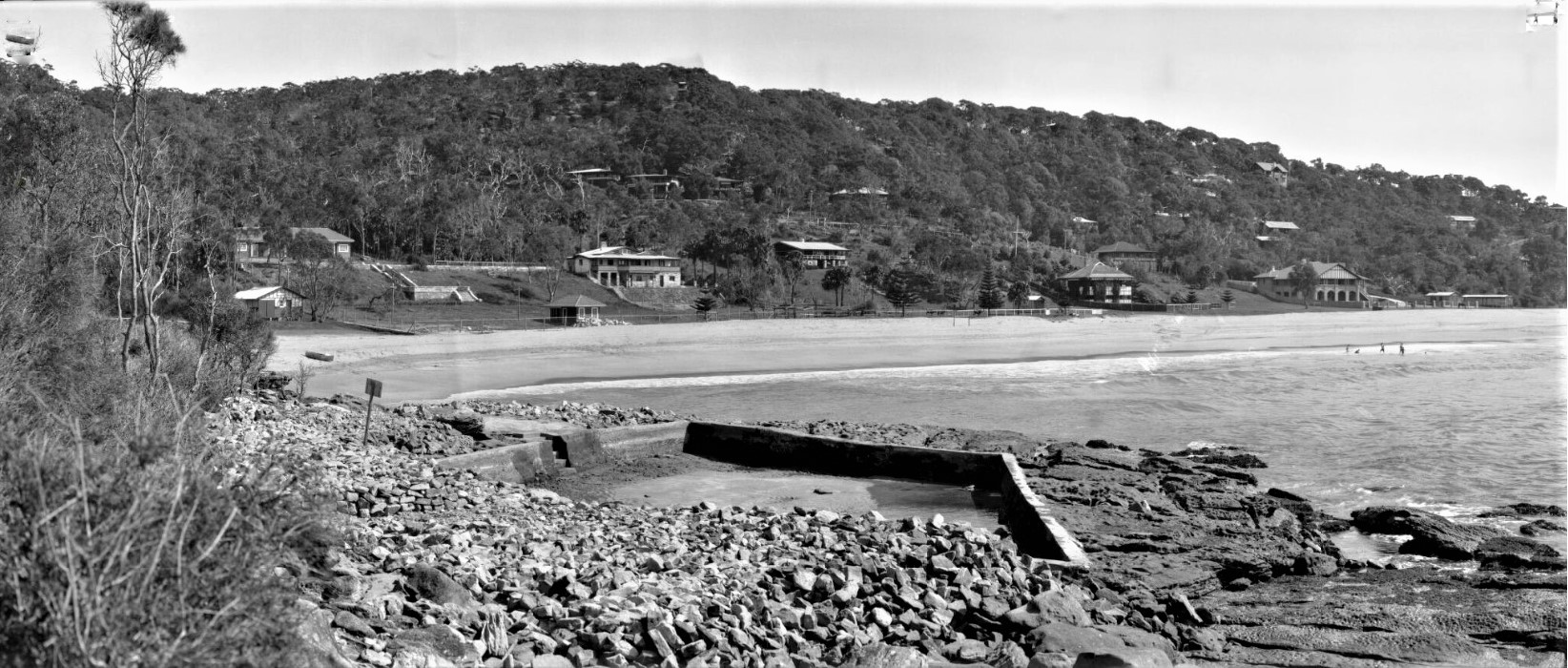
.jpg?timestamp=1544130747931)
.jpg?timestamp=1544130775468)
.jpg?timestamp=1544130667126)
.jpg?timestamp=1544130862800)
Later articles state the couple actually lived there, although it may have been Harry Jnr. who resided there for a while after his own marriage to a local girl. Either way, around the end of the Barranjoey Land Company and commencement of the Palm Beach ands Company, Harry stepped back from actively working in 'business' and directed his efforts into his love of Nature and birds.
Reports of Harry feeding birds cheese, a practice he may not undertake today with all the knowledge about how harmful this is to wild birds, appear regularly in both city and regional newspapers, so much so that he became known as 'The Bird Man of Wahroonga':
A BIRD MAN AND HIS FRIENDS.
What can be done with wild birds has been shown by Mr. H. Wolstenholme, the well-known field ornithologist, at his home at Wahroonga. Mr. Wolstenholme has on his visiting-list a grey shrike-thrush, which takes tit-bits from his hand, and comes on to a sleeping-out verandah, where It will perch on the bedside and pull at his ears. The same bird will come fear-lessly and perch on his hand, taking tit-bits of cheese find the like.
A trio of yellow Bobs, too, Is of the company, and will take food from Mr. Wolstenholme's hands. Now and again they fly down and perch on a nearby tree in their characteristic "sidelong" attitude. The yellow robin is a master of "pose." altogether delightful In his "thoughtful" attitudes.
Not least Interesting of Mr. Wolstenholme's bird friends Is a family of "Jacky Winters" (brown flycatchers). Each day three or four of the birds-come to the garden and sit on the edge of the tennis court, from whence they swoop down and snatch up In mid-air, morsels of cheese which Mr. Wolstenholme throws up. Recently two of the birds sat side by side on the fence but only one of them would take the food, the other steadfastly refusing it, even when It was thrown near to him. Shortly after Mr. Wolstenholme 'saw the bird which had been fed return to her nest In a tree nearby. It was her mate who sat beside her on the fence, and refused to take the food, while she was off the nest. The male brown flycatcher, like the yellow robin, is a model mate, and feeds his lady love on the nest during the long period of Incubation. BIRD FOLK. (1927, October 22). The Sydney Morning Herald (NSW : 1842 - 1954), p. 13. Retrieved from http://nla.gov.au/nla.news-article16413325
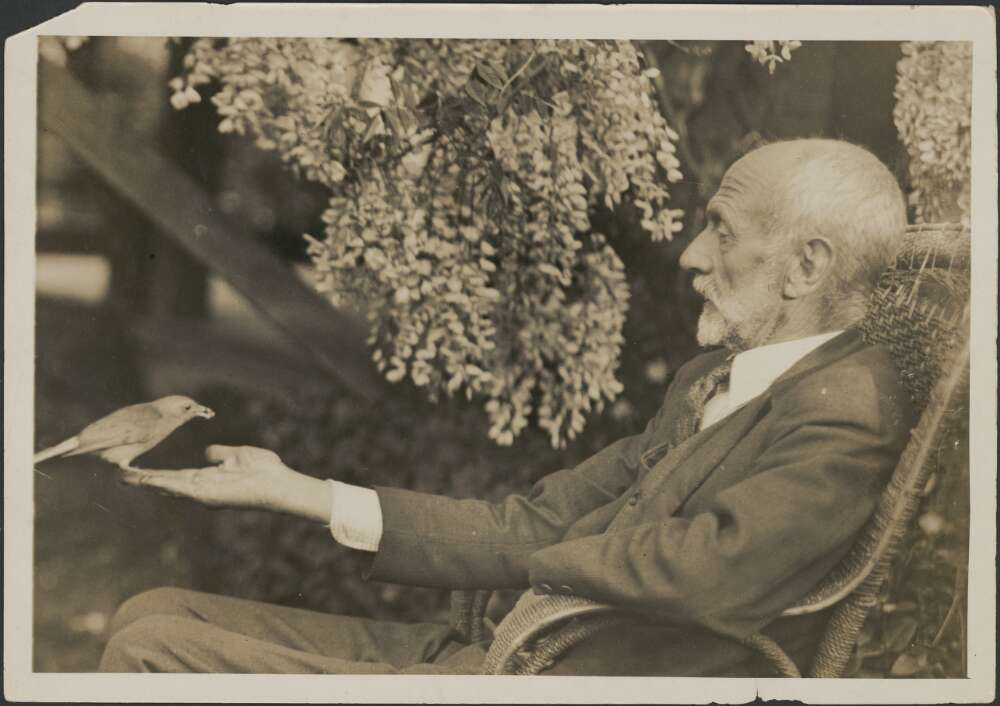
Chisholm, Alec H. (1928). Portrait of Harry Wolstenholme at Wahroonga, Sydney feeding a thrush [1928] Retrieved from http://nla.gov.au/nla.obj-150662503
Sydney, 6th January, 1928.
IT is hereby notified, for public information, that, in accordance with the provisions of the 26th' section of the Crown Lands Consolidation Act, 1913, the undermentioned gentlemen are hereby appointed as Trustees of an area of 42 acres 2 roods 7 perches at The Basin, Pittwater, dedicated 31st August, 1917, for Public Recreation, as an addition to Ku-ring-gai Chase, namely:—
Messrs. Richard Davis Bramston, Robert John Greig, Harry Wolstenholme, Hugh Kirkpatrick Byers, and Richard Beaumont Orchard (in the places of Hon. J. Perry, M.L.C., Sir C. G. Wade, and J. P. Archibald, Esquire, deceased, and Messrs. O. Curtis and E. J. Sievers, resigned). R. BALL, Minister for Lands. Lands Department Notices. (1928, January 6). Government Gazette of the State of New South Wales (Sydney, NSW : 1901 - 2001), p. 91. Retrieved from http://nla.gov.au/nla.news-article223009440
Throughout newspapers and volumes of The Emu, reference is made to Harry Wolstenholme penning papers on birds:
PROTECTING BIRD LIFE.
The annual conference of the Royal Australasian Ornithologists' Union, which last year was held in Perth, will be held this year, for the first time, at Canberra, the proceedings commencing on November 20. After the conference an observation camp will be conducted at Port Stephens in conjunction with the Royal Zoological Society of New South Wales.
Among the papers to be read at the conference will be one on the lyre bird by Dr. J. A. Leach, one on the economic value of Australian birds by Mr. Lance Le Souef, and a number of others by Dr. Leach, Messrs. A. G. Campbell, J. R. Kinghorn, H. Wolstenholme, and A.. H. E. Mattingley. Items on the agenda include consideration of a report on the training of young ornithologists, the slaughter of Australian birds by foreigners, bird protection and game laws, and the report of the bird migration committee. PROTECTING BIRD LIFE. (1928, November 2). The West Australian (Perth, WA : 1879 - 1954), p. 6. Retrieved from http://nla.gov.au/nla.news-article32234668
BRIGHT LADS WILL IMITATE WILD BUSH BIRDS
Great Work Being Done by Bird-lovers' League
More than twenty small boys, drawn from various Sydney schools, created a diversion An national Park yesterday. With lips puckered, and faces generally screwed into all manner of 'contortions, iliey roamed about the reservation, whistling and carolling like a varied convention of birds.
The reason? It is Bird Day throughout New South Wales next Friday, and the boys will be competing in bird-call competitions at Sydney Town Hall. Yesterday's bush ramble, therefore, was launched not only to freshen the boys as mimics, but also ta give them the chance of stealing further, calls from the birds. T3IRD Day in New South Wales is an annual celebration conducted by the Gould League of Bird-iovers. Formed 18 years ago at Wellington, It has spread all over the state,- and In that time has enrolled- no : fewer than 500,000 children as members, together With about 1000 adults. - ' All that is required of members is that they promise to safeguard valuable native birds. In. many cases, of course, the affection for the "little creatures of the air" continues to be keen, and extends into a life-long hobby. There can be no doubt, therefore, that the Bird-lovers' League has done the State much service. It is not every society that benefits Australia economically : (as the league .. does by saving valuable birds) and also brightens the lives of children by affording them a charming aesthetic study. Imitative Calls A pretty feature of the league's work has been the fostering, of the imitative powers of boys in relation to bird calls. Go along to the Town Hall next Friday, and you will hear bright lads throwing. themselves heartily into the wild carols of magpies, the rippling whistles of thrushes and "ecohings," the gay rollick of butcher-birds, : the plaintive semi-tones of placid cuckoos, and many other distinctive sounds of - the Australian bush._ " .
Fitting enough7is if not, that Australian boys should revel "in mimicry of birds? For the birds of Australia are themselves the cleverest- mimics in the world. No country has vocal conjurors to excel or equal our" lyre-birds, bower-birds and heath-wrens. Given adequate support for the Bird-lovers' League, and renewed activity by that modest body, the benefit to Australia would be very considerable. Aside from the economic aspect, -think of the elysium-like state of a community that cultivated its brilliant wild birds. As a sparkling example in point, consider the healthy records created by Mr. Harry Wolstenholme, in a Sydney suburb. Mr. Wolstenholme has shown such fraternal- regard for the birds of the bush that no fewer than 41 different species — a varied and beautiful throng — have come to a small water-trough in his back- yard. And in his own grounds, which carry garden shrubs, fruit trees, and a score or so of big gum trees, he has recorded 26 species of birds nesting from time to time. Further, Mr. Wolstenholme has enjoyed the novelty of having as many as eight species of wild birds take food from his hands, or at his feet, or catch crumbs as he throws them aloft. Every day a bevy of. jacky winters, call to him., from trees, and then flutter above his head to snap up. fragments of cheese. All. this on the fringe of the largest city in -Australia! BRIGHT LADS WILL IMITATE WILD BUSH BIRDS (1928, October 14). The Daily Telegraph (Sydney, NSW : 1883 - 1930), p. 8. Retrieved from http://nla.gov.au/nla.news-article246855748
GILL BIRDS.
TO THE EDITOR OF THE HERALD.
Sir,-It should be known that there are two species of birds that are sometimes called gill birds. Their approved name is wattle-birds. The larger bird is the red wattle bird (Anthochaera carunculata), commonly known in Sydney as the gill-bird. It has a small wattle of red flesh at the side of the neck This gives the name. The smaller bird (two inches shorter) is called the little wattle bird or the brush wattle bird (Anthochaera chiysoptera).
Though it has no wattle it has received the name little wattle bird from its general similarity to the first-known wattle bird. Both species are well known about the outer suburbs of Sydney. Yesterday I observed both kinds at the same time gathering honey from the red blossoms of a coral tree (Erythrina sp.) in my garden. About Wahroonga little wattle birds nest in my own and other gardens or in neighbouring bush every year but I have not yet observed or heard of a nest of the red wattle bird (gill-bird) in these parts. Ornithologists would be interested to know whether the gill-birds your correspondent A.B. of Wahroonga mentions as breeding almost at his back door are real Sydney gill birds or simply little wattle birds.
I am etc
H. WOLSTENHOLME.
Wahroonga, September 9.
GILL BIRDS. (1929, September 10). The Sydney Morning Herald (NSW : 1842 - 1954), p. 8. Retrieved from http://nla.gov.au/nla.news-article16582769
The ill health that had taken his siblings as babies seemed to thwart his own life as well. He passed away in the Spring of 1930 with the following Tribute published in The Emu a few months later:
Obituary
MR. HARRY WOLSTENHOLME.
Ornithology in Australia lost one of its ablest adherents when Mr. Harry Wolstenholme, B.A., died at Wahroonga, Sydney, on October 14, 1930, at the age of 62 years.
A native of Maitland, N.S.W., Mr. Wolstenholme had a brilliant career at Sydney University. He entered the legal profession, but failing health caused his retirement from professional activity some years ago. By a curious paradox, it was illness that both stimulated and handicapped him in the study of birds, since the enforced leisure caused him to cultivate a latent fondness for natural history, and physical weakness prevented him from extending his field studies.
The last considerable outing undertaken in Australia by Mr. Wolstenholme was the R.A.O.U. expedition to Yeppoon, Queensland, in 1924. He wrote for The Emu the detailed list of species noted on that trip, and his articles, packed with informative observations, stand as models of their kind.
During 1925 he went with his wife and daughter on a tour of the Old Country, and there he enjoyed himself in making the acquaintance of British birds and bird students with all the gusto of a hearty man of half his years, a fact which became manifest in a zestful and scholarly article comparing British and Australian birds. (The Emu, Vol. 26, pp. 122-134). Less ambitious, but no less interesting, articles by Mr. Wolstenholme are freely distributed throughout the pages of this journal during the last ten years or so, perhaps the most important of them being the notes upon native birds found about his home at Wahroonga.
It was a happy chance that such a man settled in such an area ; for by this chance the bird-haunted suburb became another Selborne, with Harry Wolstenholme as its Gilbert White. Not only did he keep faithful watch upon all bird happenings of the neighbourhood, and promptly share the pleasure of his discoveries with younger men, so that many of the best bird photographs in Sydney were taken at Wahroonga, but he encouraged birds about his home to such an extent that the garden and paddock adjoining were by way of being natural aviaries. During the last five years twenty-six species of birds (twenty-one natives and five immigrants) nested on the property, and no fewer than forty-five species accepted the hospitality of a small drinking and bathing pool only ten yards from the rear door of the house.
Furthermore, the Birdman of Wahroonga had four species of wild birds perch voluntarily on his hands from time to time, and at least four other kinds approach to "ask" for food. So complete, indeed, was the confidence of certain birds that it was no uncommon circumstance, when walking in the forest with Mr. Wolstenholme (out of sight of the house) to see Brown Flycatchers skim down from lofty trees and flutter a few yards away until cheese-crumbs were thrown for them to catch. Surely there has never been a happier or more thorough alliance between birds and man than in this Wahroonga idyll !
The name of Wolstenholme will endure in popular birdlore because of the scholar-naturalist, warm in sympathies, mellow in wisdom, who studied birds about his home. It will live also in scientific ornithology, and that because of the remarkable Appendix to the Official Checklist of Australian Birds (Second Edition). Although not a member of the Checklist Committee, Mr. Wolstenholme generously devoted many months to studying the technical names of Australian birds, and finally presented the Committee with a complete list, embracing derivations, vocabularies, and pronunciations of the accepted names, together with a mass of informative notes thereon. It was a unique and valuable work, possible only in the case of a bird-student possessing high classical scholarship.
At the time of his death Mr. Wolstenholme was a member of the Council of the R.A.O.U. He was also a trustee of the N.S.W. National Park, known as Kurin-gai Chase. Previously„ when able to attend meetings, he had been a councillor of the N.S.W. branch of the R.A.O.U. He was not at any time, however, fond of public or even semi-public positions. When The Emu was published in Sydney he gave constant and valuable assistance to the Editor, but never desired to have this fact acknowledged. Modest, kindly, and as gentle as the birds he loved, for him the pleasures of natural history were sufficient in themselves ; he sought no further reward.
Nevertheless, he was not in any sense a hermit ; he thoroughly enjoyed short trips in the Sydney region with kindred spirits, and his home was (as many ornithologists in other States can testify) always open to lovers of birds. If any further indication of the kindly nature of the man is needed, it lies in the fact that he left his bird-books to the younger naturalists of Sydney, who had frequently visited him during his illness.
It had been arranged by several bird-photographers to take a lantern to Wahroonga during October in order to show Mr. Wolstenholme slides of all recent pictures. Alas, he did not live to enjoy this pleasure other than in anticipation. A month or so later, however, the slides were screened for Mrs. Wolstenholme and interested friends of the neighbourhood. We felt, then, that the Birdman of Wahroonga was present in spirit.
—A.H.C, The Emu, January 1st, 1931, Volume XXX
'A.H.C.' was Alexander Hugh (Alec) Chisholm (1890-1977), journalist, ornithologist and encyclopaedist who also took photographs and was among numerous adventures seeking birds and became a lifelong champion for nature and the environment - long before the term 'environmentalist' was coined. It is his image of Harry feeding a bird at Wahroonga which has been shared so many times in this and other publications, and he appears among the images taken by Harry, or some other, during visits to fishing places, National Parks and anywhere they sought to observe and record birds.
His duties as a Trustee for the park over the other side of the estuary were taken up by another:
Sydney, 5th December, 1930.
IT is hereby notified that, in accordance with the provisions of section 26 of the Crown Lands Consolidation Act, 1913, George William Hitchcock, Esquire, is hereby appointed, in the place of the late Mr. Harry Wolstenholme, as a Trustee of Ku-ring-gai Chase, Hawkesbury River, area about 35,300 acres, dedicated 14th December, 1894, for Public Recreation, and the following additions thereto, namely: 3 acres 1 rood 20 perches at Towler's Bay, Pittwater, dedicated 12th July, 1911; 15 acres and 7 acres 1 rood at Coaster's Retreat, Pittwater, dedicated 2nd August, 1911; and 42 acres 2 roods 7 perches at The Basin, Pittwater, dedicated 31st August, 1917. P. 30-11,500. J. M. TULLY, Minister for Lands. Government Gazette Appointments and Employment (1930, December 5). Government Gazette of the State of New South Wales (Sydney, NSW : 1901 - 2001), p. 4816. Retrieved from http://nla.gov.au/nla.news-article220234083
As can be read in the Obituary for him by his long-term friend, Harry also wrote papers. This one (below) underlines the importance of the backyard bird watcher and the annual Aussie Back Yard Bird Count, along with allowing all to do their own 2020 checklist and compare it with that from 100 years ago, where Mr. Wolstenholme could count at least 100 birds species from and in his backyard.
Clearly the retention of trees and being part of that 'tree flyway' helped having so many birds living with humans - while here we have not only the tree flyways but the bay and wetland byways for birds that need to be maintained and kept as Wildlife Preservation Areas where these birds may rest and nest safely, as has been shown earlier this year when birds normally seen inland fled from bushfires to these coastal wetlands ands their creeks. The work of bushcarers and the individual gardenere in their own backyard is highlighted in this - we can all plant out species endemic to here with which to feed birds - birds that are part of the balance and snure you don't get eaten alive by mosquitoes - because they eat them - and don't get sick from tick bites - because they eat them!
This also allows us to hear his voice and know why Mr. Chisholm called him the 'Bird Man of Wahroonga' even if, to we of Pittwater, he was also a Bird Man of here. Even a brief scan of all the birds Harry listed may give those not cosncvious of the existenmce of birds an undertsanding of why those who live with them hear their call to wake as the sky lighten and hear naught but the most glorious noted 'Good Morning!, Good Morning, Good Morning!' from every kind of bird flitting fast past them in the half hour of sunrise.
Good Morning! Are you awake yet????
Harrys' work - From - The Emu by Australasian Ornithologists' Union; Royal Australasian Ornithologists' Union: Volume 22, 1922-1923
Vol. XXII. 1922
WOLSTEXHOLME, .Notes from Wahroonga. 141
Notes From Wahroonga, Sydney, N.S.W.
By H. WOLSTENHOLME, R.A.O.U.
These notes are from observations of birds at Wahroonga, a North- Shore-line suburb, 12 miles from Sydney. They were made in the garden (or within 100 yards round it), largely from the verandah, which has trees and shrubs close by and a small bathing pool, hollowed out of a flat piece of sandstone, a few steps away in the shade of an apple tree. On three sides is almost virgin bush, with small areas here and there of tall eucalyptus, left by the timber-getters of last century and still happily untouched by the ruthless hand of civilisation. All the country north of the North Shore railway suburbs consists of the Hawkesbury sandstone formation, usually hard and rocky, sterile in appearance, and supporting its characteristic flora of Banksias, Boronias, Heath (Epacris), Apple-tree {Angophora), etc., etc., that Honeyeaters love, and where the shy Ground-Wren {Hylacola pyrrhopygla) may sometimes be seen. The land falls away into gullies which are studded and flanked with irregular masses of weathered and waterworn sandstone, and grow deeper and wider as their streams wind away to the salt waters of Cowan Creek or Middle Harbour — plenty of cracks and caves for the Rock Warbler (Origina ntbricafa ) , and thick scrub and under- growth in places for the Whip- Bird (Psophodes olivaceits) and the Lyre-Bird (Menitra nover-hollandice) .
There would be 100 or more bush birds about these suburbs on their northern side, beginning at Roseville, six miles from Sydney, and it is a matter of surprise and regret that, with this amount of interesting bird-life close to a city, there seem to be so few individuals that go out among the birds and hear and see them in their native haunts.
Eurystomus orientalis. Dollar Bird or Australian Roller. — Very common in summer, small parties taking up a position in high trees, preferably on dead branches and doing short flying; stunts to and fro as though practising or "showing off," perhaps catching insects at the same time, to an accompaniment of rough, hoarse notes from both performers and spectators. Good glasses are needed to appreciate their varied hues. They rarely come down low.
Eurostopodus mystacalis. White-throated Nightjar. — At nightfall every fine evening in April one was to be seen in continuous strong and graceful flight of sweeping curves about the tops of the tall eucalyptus. Once only (April 16th) were two birds seen at the same time, when it was too dark to identify the species.
Eudynamys orientalis. Koel. — Unmistakable "cooees" were heard on two summer evenings, and a few nights later (January 14th) a bird came into the tall trees in the back paddock and "cooeed" several times. The birds have not been actually seen here, but have frequently been seen nearer the coast at Pittwater, about 8 miles away as the Crow flies.
Microeca fascinans. Australian Brown Fly-catcher. — Jacky Winters are very common indeed and great favourites. They have no bright plumage to please the eye, but are so lively, friendly, and useful, and such sweet songsters in the warmer months; frequent companions to the gardener (but often in high timber, where their song is usually given), alighting familiarly round about on twig or post, and flicking the white-edged tail to this side and that side. Quiet and trustful, alert and wistful, gentle, yet they are marvellously quick. If a morsel is dropped it will be caught in the beak before falling 6 inches. On good terms with all other birds with the exception of Cuckoos. Rather silent through the cool months, but they give prolonged "Peter Peters" in a variety of sweet tones and modulations in spring. Their chorus at dawn on a fine spring morning is glorious — a daily joy to the early riser in these parts. We feed some every day by tossing up little bits of cheese to be caught in mid-air — a natural way for fly-catchers to obtain food — and they take them most wonderfully with the greatest ease. A few posts close to the verandah are for their special use. In the garden they will alight just at hand or hover above one's head, asking for a morsel to be thrown to them. Their shallow little nests, though so small and hard to see, may be found easily by watching the birds. Their were four last season within 70 yards along the road by the gate. Usually they are in a big eucalyptus and frequently are quite low.
Gerygone albogularis. Bush-Warbler. — Plentiful. This little migrant fly-eater is here from spring to autumn. It is sometimes called the "Native Canary," having its breast a light canary colour, and possessing a beautiful song — a cascade of light liquid notes ending with a staccato note not always heard. It lives chiefly aloft in the big gums. The nest is of the Tit-Warbler (Acanthiza) type, very elongated, with a hooded entrance and a long tail.
Eopsaltria australis. Shrike-Robin. — Very common indeed, and, like the Jacky Winter, most attractive, but very different. It is heavier, slower, inoi-e deliberate, often eyeing a piece of food for quite a little time before hopping down to it. Does not hover, and moves about silently in thick, scrubby and shaded parts (perhaps its large eye is to assist the sight in these places). Here one is almost sure to be seen in its well-known position, clinging diagonally to the vertical stem of a small tree, and never far from the ground. Some are usually in the garden. First to wake and last to sleep, their gentle and regular one-note whistle is (along with the boisterous laugh of the Kookaburra) the earliest of bird-notes at day- break, and the latest at nightfall, but throughout the day it is not so much heard. The strong "Tchoo Tch.oo" is given in the nesting season only.
Some of the birds are tame — friends of all the household — and take cheese perching on our hands. Two were given names — "Cheeky" and "Stumpy," he was minus his outer tail feathers for a while. Trustful, unassuming and joeaceful by general repute, and rightly so, yet. at times, quite otherwise. If food is being distributed, they are very jealous of the Jackies and try to keep them away, and occasionally they fight amongst themselves. At the bathing pool Robin is selfish and exclusive. A Sparrow is usuallv there. If Robin wants to go in, he just jumps at the Sparrow. Sparrow as a rule goes; if not. Robin jumps on him, and. applying his beak effectively, has the bath to himself. He objects to strangers, and rudely drives off Redheads ( Aegititha trmfioralis ) or other small birds. The nests about here are a uniform height, about 8 feet from the ground.
Falcuncuhis frontatus. Shrike-Tit. — Very numerous. Their queer chuckle or slow whistle is constantly heard in the eucalyptus trees. Young birds were often fed in the orange trees. In the quiet of the bush the presence of these fine birds is sometimes discovered by the crackling noise made in breaking and pulling away bits of dead bark with their powerful mandibles, as they search for their insect food. At the bath one will flop down suddenly, causing a scare and a scurrying- away of the bathers as though he were a Butcher-Bird. He will splash about energ-etically, looking very alert and more handsome than usual with crest and tail spread — formidable, no doubt, to the smaller birds that do not venture near while he is in posession. A pair nested at the extreme top — 70 feet high — of a lanky blackbutt near the fence.
Pachycephala rufiventris. Rufous-breasted Whistler. — These great songsters may be beard in all directions in spring and summer, except during a kind of midday siesta on hot days. Most of them go north in the autumn. They have many melodious notes. The chief one is heard at its best in the mating season, when the males are in competition with one another, and in their excitement at this time they have a curious habit of bowing or bobbing their bodies up and down. This note is a rapid and confused blending of rich and resonant melody impossible to imitate. It is heard, too, when the nest is being made. The female bird attends to this, but whether she goes some distance away collecting material or whether she is at the nest arranging it, the male bird is never very far from her, making the bush resound with his approving outbursts and joyous song. That is his only assistance. But it must be recorded that later on he takes a turn sitting on the eggs, which many male birds do not.
Other pleasing notes are the leisurely "Echews" and the short whip-like notes. Then there is the loud single piping note oft repeated — so many times frequently that one wonders when it will cease. When this is given it follows at the end of the commonest call. Any sudden noise such as the report of a gun, a clap of thunder, blast at a quarry, always startles these birds into song. The female is not seen as often as the male, and has not his bright colours or fine notes.
Pachycephala gutturalis. Yellow-breasted Whistler. — These are plentiful, but not so common as the Rufous-breasted. They prefer the scrubs and brushes of the gullies. A more handsome bird to look at, but an inferior songster, though he has some fine calls — one that is reminiscent of the well-known note of the Grey-Shrike Thrush {Collitriciiicla harmonica) and one with a whip-like swish at the end. The Whistlers are particularly fond of caterpillars, and may frequently be seen in the trees pulling out quite large ones from under the bark. One female bird used to come about the verandah and take bits of cheese that were thrown down. Its plumage is darker than that of the female nifivoitris, and has a green tinge. The nest of the yellow bird is more solid than that of the rufous bird, and, speaking generally, is nearer the ground.
Rhipidura flabellifera. White-shafted Fantail. — Very numerous. Fearless and inquisitive (yet in a shy kind of way), fussy and restless as a Honeyeater, the peculiar little whistle may be heard all through the day in the nesting season, as they hop and flit about in the scrub and trees. Very quick and active in pursuit of flying insects, they dart or dive suddenly in any direction, making the flight sometimes appear jerky. Nests about here are very low — some only 2 feet from the ground.
Rhipidura rufifrons. Rufous-fronted Fantail. — Not nearly so numerous; but they frequently come up from the gullies to the gardens and are sometimes seen hopping about in company with the White-shafted. They are similar in habit to the white-shafted species, but more beautiful in appearance — a study in rufous shades.
Seisura inquieta. Restless Fly-catcher. — The Scissor-grinder is plentiful — a fine and interesting bird to observe with its lustrous dark-blue (not black) head, on which the feathers can be erected into a little crest, and its under parts pure white except for a slight wash of rufous on the chest of the female. It calls so sweetly (though, perhaps, holding the while a large moth in its beak), "Tu whee, tu whee" high in the gums or on a telephone post, and gives the grating, grinding notes lower down among the fruit trees and vegetables. Close to the ground it flies along very slowly, and at times hovers as it searches the ground for insects and spiders, suddenly, maybe, drooping down on to them like a Kookaburra on to a mouse. In hovering it gets its body and tail into a more vertical position than Jacky Winter, and its; head seems more pointed to the ground. The scissor-grinding sound end.s with notes at a higher pitch than those at the beginning. This effect is produced by opening the mandibles wide. It does not nest low and near houses like its relative, the Willie Wagtail Fantail { Rhipiditra leucophrys } , but usually high in a eucalyptus.
Myiagra rubecula. Leaden Fly-catcher. — Not plentiful; but birds are to be heard and seen now and then in the high timber, never about the garden. The tail is not held up like that of the Fantails, but sometimes shows a slight quivering or trembling movement when the bird is at rest. The female differs from the male in having throat and breast lufcus, which in the male are of a greeny-blackish colour.
Monarcha carinata. Black-faced Fly-catcher. — Not common. "Why- you, which-you," heard two or three times, revealed the presence of two birds in a thick Pittosponam (P. undidatum) on February 17th. They are singular looking birds as though wearing a black mask, the face and throat being in such contrast to the grey upper and rufous under parts. Odd ones also were seen on a few other occasions — one with face and throat grey looked commonplace in comparison with the black-faced birds. This was a female or immature male. They keep in thick brush country as a rule.
Psophodes olivaceus. Whip-Bird. — Fairly common a little way off, where there is thick undei'growth in the gullies. They come up to the shrubberies in the warmer months, and may then be frequently seen and heard near the ground among thick umbrageous shrubs in the gardens that border on the bush. They are very shy.
Acanthizae. Tit-Warblers. — These lively and most useful little birds are very numerous in small flocks. About the ground, often among the vegetables and flowering plants, may be seen parties of A. chrysorrhoa (Yellow-tailed), and less often A. rcgidoidcs (Buff- tailed), active and busy feeding on aphis and other insect pests, and showing their yellow or buff upper tail coverts as they flit from place to place.
Going through tree after tree (particularly Acacias) in little companies, the Little (A. nana) and Striated (A. lineata) may be distinguished, hard at work devouring insects. A. pusilla (Brown), darker, and with spotted chest, is not so common; keeps more to the bush.
Maluerus cyaneus Blue Wren-Warbler. — The bright warblings of these lovely little birds are to be heard in every garden as they hop and flit about among the small plants and creepers. Some will come to the verandah, and take cheese thrown to them. It is surprising how many birds like cheese. It must be more nourishing than the outer parts of many insects. They nested twice in honeysuckle on a bush-house.
The Variegated-Warbler ( M. lamberti ) of the same genus is fairly numerous, but sta/s in the wild undergrowth away from houses.
Colluricincia harmonica. Harmonious Shrike-Thrush. — These are very plentiful and are great favourites about the homes. They are to be seen on the ground or among the trees and plants of every orchard and garden, rarely high even in bush timber. They live on grubs and all kin()s of insects, spiders, beetles, small lizards, and have been seen swallowing with some difficulty large centipedes. One bird comes hopping along every day with cheerful confidence on to anyone's hand tor cheese, and has been a family pet for a long time. It will hop about us as we lie reading, and sometimes wakes us up early by coming on to our pillows (two of the family sleep outside). This is quite an old bird— a male with chest a clear blue- grey, not streaked like that of the female. Its nest was placed in the young growth from a Casuarina stump about 3 feet from the ground. One young bird only was reared which came to us like the old bird for a while, then disappeared. It had a rufous eyebrow and a generally lighter colour. The rich, harmonious note for which these birds are famous is heard in the nesting season only.
Necsitta chrysoptera. Orange-winged Tree-Runner.— These are plentiful. They go about in little flocks, which give mournful notes as they fly over. They feed, too, in small companies, running along the branches and the tree trunks, usually head downwards, probing with their sharp beaks every little crack and hollow in the bark or wood in their search for insects, and uttering a little "Chip, chip" all the time. One has to observe a little party at work in thick scrub such as Casuarina to see their pretty marking and coloration and their yellow legs and feet. One can get quite close: they are so hungry and so busy, and always seem in such a hurry — going like a flash from one tree to another and displaying as they go the band of colour on the wings, which is bright rufous rather than orange.
A pair nested in October and in January (perhaps same pair) high in two eucalypts 20 yards apart in the back paddock. The nest is built on a perpindicular branch usually dead, at a junction, and is difficult to find unless the bird can be followed to it with the eye.
Cliniacteris leucophaea. White-throated Tree-creeper. — Very numerous, especially in autumn. They live on the same kind of insect food as the Sittellas and obtain it in a similar way, creeping up (never down) the tree trunk spirally or winding round the main limbs and suddenly darting away to the base of a neighbouring tree to begin another s; scent, often giving loud and shrill piping calls and a pretty, soft, ratt.e note. Seen closely, they are beautifully marked (female having a clear orange spot near the ear); like the Sittella they show the rufous band on wing when they fly. Being rarely on the ground, they are awkward in an unaccustomed place such as the flat side of the bathing pool; on going in, the bird splashes and ducks and gives a loud cry between the splashings, which no other bird does.
Dicaeum hirundinaceum. Mistletoe-Bird. — Though common, this exquisite little bird (the male) is not very frequently seen notwithstanding its bright red breast, being very small and keeping aloft, its shrill little chirp is often heard from the tree-tops or lower down from the clumps of the parasitic mistletoe ( Lorantbus ), whose berries are greedily eaten and look as though they might choke the bird in its efforts to swallow them. It comes down at times into the garden trees in search of small insects — its principal food. A male bird was observed, one day for quite a little while hanging by its feet from a clothes line head downwards like an acrobat. The male only has the gorgeous colours, female being inconspicuous and not much seen. The nest is made of light-coloured woolly-looking material obtained from various plants, and is sometimes decorated with small globules of red gum like rubies — a wonderful structure.
AEgintha temporalis. Red-browed Firetail. — Very plentiful during April. Commoner than Sparrows. They were all round in flocks and about the garden, where their sibilant whistling was heard all day, and little flocks were flushed where the grass and weeds were long. Many birds were not mature, being without any red on brow or bill; rump feathers just showing the red. They swarm round the bathing- pool. A party enjoying themselves there on a bright day is a pretty sight. Nests all round; they were still nesting in April.
Honeyeaters (Family Meliphagidae) are very numerous. Near the verandah is a Coral-tree ( Erythriua), from which, when in flower, the varied notes of different birds from the Friar- Bird or the Eeatherhead (Philemon corniculatus) to the Blood- bird or Crimson Honeyeater ( Myzomcla sanguineolenta) are heard, as they gather honey and insects, and flit hither and thither from blossom to blossom. It is remarkable that, among all the Honeyeaters in the coastal districts of New South Wales there are not many that have pleasing notes. There is no Honeyeater that, as a songster, can be compared with the Rufous Whistler or the Thrush {C. harmonica), the Australian Reed- Warbler (Acrocephalus australis) or the Jacky Winter. Many have notes that are harsh or discordant — the ejaculations of the Gill Bird or Wattle-Bird {Acantiochaera caritncitlata), the queer talk of the Leatherhead. The bright, insistent whistle of the Spinebill ( Acanthorhynchns tenuirostris), and the lovely "Tink Tank" notes, now close, now distant, of Bell-Miners (Manorliina mclanophrys), immortalised by Henry Kendall as being —
"Softer than slumber and sweeter than singing," give great pleasure to the ear; but these are the exception.
Melithreptus lunulatus. White-naped Honeyeater. — These are very common, and are here all the year round. Their well-known notes, one plaintive and another with a sort of sucking or lisping sound, are continually heard from the tall gums, where they chiefly live and nest. They c( me in small parties to the bathing pool, where they are shy and timid, but are not much seen in the flower garden. They obtain their honey from the native trees. Smallish birds, clean- looking and with bright colour contrasts — the black head, the white chest, the bright yellow .green upper parts, and the little ring of vermilion about the eye. They are not fruit eaters.
Melithreptus brevirostris. Brown-headed Honey-eater. — This bird is not so common as the White-naped, but is plentiful. It might be said to resemble b White-naped, whose plumage has become very faded and shabby — a little blue about the eye. They are often in small companies in the bush trees and in the garden, where they are very fond of the large blossoms of cannas and Bignonia grandiflora. Their commonest note is rather jerky and unmusical. The Black- chinned Honey-eater (M. gularis). of same genus, is like an extra big lunulatus, with blue instead of vermilion about the eye. It is not common.
Myzomela sanguineolenta. Crimson Honey-eater. — This beautiful little fellow — about the smallest and the brightest in colour of the family — is plentiful roughly from October to February, according to the season — in some years more numerous than in others. Though their diminuitive song may often be heard aloft in the eucalypts, the birds themselves are hard to see until they come down to the flowering shrubs in the gardens, where they may nearly always be found on the flowers of the Coral-Tree ( Erythriua ) or Native Bottlebrush (Callistemon lauceolatus) , both largely grown in gardens, and both producing big blossoms of a scarlet colour — a good example of protective coloration. Immature birds are sometimes seen with very little scarlet on the back. The female, as in the case of the Mistletoe-Bird, has dull plumage and no song, but a chirp, and is rarely seen unless near her nest. About here they often choose a Turpentine tree (Syncarpia latirijolia) or a Sweet Pittosporum {F. undulatitm) for their nests, which are frequently built very low.
Acanthorhynchns tenuircstris. Spinebill. — This lovely bird is the best-known Honey-eater in the flower gardens. He likes the bright blooms of summer time, and looks very pretty as he flits from plant to plant and gracefully balances or hangs on a flower spike or hovers beside it, while he culls the honey and little insects from the blossom- depths with his long tongue. A pair, perhaps, is on the same stem (the female is the one with duller plumage), and it bends over, may be to the ground, with their weight. Active and restless and fussy, swift in flight, making a "Frip frup" sound with his rapidly-moving wings as he speeds along, always in a hurry, even his calls — especially the clear whistle, a single note repeated, given "tempo accele-rato" — suggest impatience. Not a fruit eater, he is a genuine honey- eater and flower-lover. He often nests in small She-oaks (Casiiarina).
Meliphaga chrysops. Yellow-faced Honey-eater. — This bird, one of the least attractive of the family to look at, is the most plentiful in these parts, and can always be seen in the native trees or about orchards and gardens. Inveterate orchard-robbers, they place a high value on their services as insect destroyers, when helping them-selves to their wages in the form of fniit. In company with the Lewin or Yellow-eared Honey-eaters ( M. leicini ) and Silver-eyes (Zosterops lateralis) they do great damage to summer fruits and to apples and pears. These are all so greedy, when busy feeding on the fruit, that one can approach and "stand within one or two feet (literally) of them without being noticed.
The Yellow-faced is the most tameable or least wild of the family — the Soldier-Bird or Noisy Miner ( Myzantha garriila ) excepted. Some come for cheese, almost taking it from our hands. A pair fed a young Pallid Cuckoo (Cucuhts pallidus) four times their size, that took up a position in the nearest peach tree for two days on a liberal diet of cheese cnambs supplied by the household. They are almost as omnivorous as Sparrows, often feeding with them at the scrap-bucket on all kinds of refuse. One had a habit of coming into the kitchen, and was often found on the floor picking up morsels. Here, as elsewhere, they often nest in a bush or creeper quite close to a building. Their note is rather pleasant, but short.
Meliphaga lewini. Yellow-eared or Lewin Honey-eater. — This Honey-eater is common especially in autumn — a finer bird in evei'y way than M. clirysops; of a dull darkish gi'een colour and with a large yellow spot by the ear. It is a robber of the orchards when the fruit is ripe, and, like the Oriole {Oriolns sagittatits) is veiy fond of figs. It also feeds on large insects and spiders, for which it will dart in under the verandah. These birds like thick leafy shrubs or trees such as Lillypilly {Eugenia smitliii) or Sweet Pittosporuni {P.ioidulatum) for their nests, which are placed not high in the tree and are fairly large and solid and beautifully lined bottom and sides — often with soft, downy material obtained from the seed cases of various plants. The old birds are veiy brave and pugnacious when the young ones are in the nest. Their chief call is a prolonged quavering note, rather musical and pretty.
Meliphaga melanops. Yellow-tufted Honey-eater. — These are not very plentiful, but companies are frequently seen — handsome birds with projecting eartufts of a rich golden-yellow and dull yellow crown which sometimes appears to be ruffled. Their hoarse notes are heard aloft in the eucalypts, where they jump and flit about as though playing some game, and are hard to observe. They come down to the garden sometimes and to the bathing pool. They have not been seen to take fruit. Like the Crimson Honey-eater, they are fond of the Bottle-Bush (Callistemon) blossoms, among which, one bright summer's day, eight or ten were to be seen enjoying themselves — a sight to be remembered. They form little settlements, confining themselves to a small area for nesting. A previous season near here, in an area of about three acres, some fifteen nests (all 3 or 4 feet from the ground) were found in the young growth sprouting from the stumps of felled eucalyptus trees. Many of the nests had a little bit of paper fixed in their outer parts — a scrap of newspaper or torn-up letter.
Meliornis nova-hollandae and M. nigra. Yellow-winged and White-cheeked Honey-eater. — These two fine birds, alike in appearance, habit, and note, often come about in the spring and summer. The White-cheeked has white about the forehead and particularly the cheeks. Their home is not in timbered country, but in scrub near the sea, about creeks and lagoons, among the Banksias, Callistemons, etc., whence it is not far to the gardens in these suburbs. Both species were to be seen almost every day in summer in a Coral-tree and an Acacia-tree, next to each other and close to some natural scrubby undergrowth. Restless, fussy and selfish and somewhat slow of movement, having feasted on the Coral-tree blossoms, they would move to the Acaci.i and hop about leisurely, giving their not very pleasing notes, waiting for some excitement— the advent of a brother to be welcomed or a stranger to be hunted. The chief concern seemed to be to keep every other kind of bird out of that tree. They would hasten across and hustle out any innocent Thornbill (Acanthiza) or Silver-eye ( Zosterops) seen on the other side. (It is a transparent tree.) They rarely visit the flower beds and are not fond of fruit. Both species nest not for from the ground in small bushes.
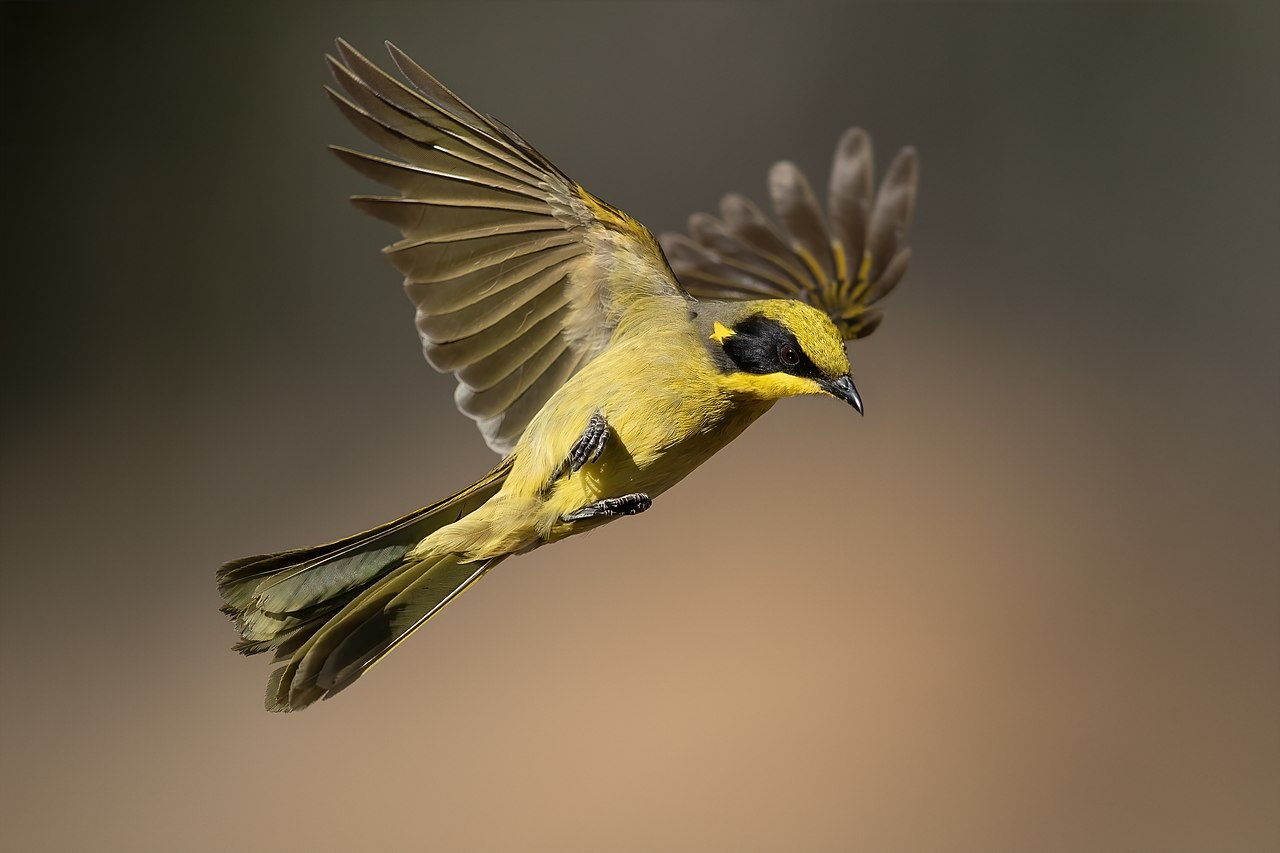
Yellow-tufted Honeyeater (Lichenostomus melanops), Glen Alice, Lithgow, New South Wales, November 9th, 2019 - photo by and courtesy J J Harrison(https://www.jjharrison.com.au/)
References And Extras
- The NSW Women's Legal Status Bill 1918: How The 'Petticoat Interference In Government' Came Of Age - A 100 Years Celebration Of Women Alike Our Own Maybanke Selfe-Wolstenholme-Anderson - originally published in 2019
- TROVE - National Library of Australia
- Pittwater’s Parallel Estuary: The Cowan ‘Creek’ - 2014, Issue 145
- Pittwater's Lone Rangers - 120 Years Of Ku-Ring-Gai Chase And The Men Of Flowers Inspired By Eccleston Du Faur - 2014, Issue 165
- The Emu by Australasian Ornithologists' Union; Royal Australasian Ornithologists' Union; Volume 15, 1915-1916, The Emu by Australasian Ornithologists' Union; Royal Australasian Ornithologists' Union, Volume 21, 1921-1922, The Emu by Australasian Ornithologists' Union; Royal Australasian Ornithologists' Union, Volume 2, 1902-1903
- Pittwater Roads II: Where The Streets Have Your Name - Palm Beach
- Ella McFadyen's Love Of Pittwater: An Environment, Wildlife and Children's Champion
The Emu
Vol. I.] OCTOBER, 1901. [Part I] Pages 1-6.
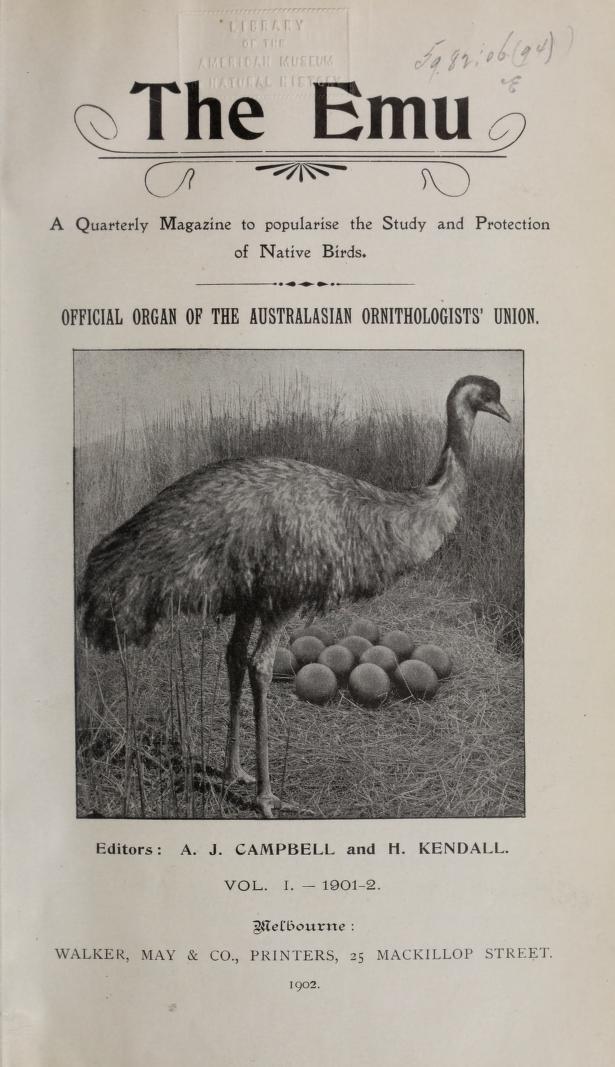 The Australasian Ornithologists Union
The Australasian Ornithologists Union
ITS ORIGIN.
In after years reminiscences of the beginnings of successful societies possess a special interest. But too often, when the history of what time proves to be an important event comes to be written, material is either unavailable or only procured with difficulty. Hence it may not be unwise to reverse the usual order of things, and even before the first general gathering of the Aust. O.U. in Adelaide, to " take time by the forelock," in this first issue of The Emu, by giving an outline of the inception of the Union and the steps which led to the formation of so necessary an institution.
The initial stages took the form of a series of ornithological and oological dinners or reunions, delightful socials at which nothing stronger than tea and coffee was drunk. The first was held on 15th August, 1896, and the only record is the following account given by a newspaper : —
REUNION OF NATURALISTS.
At the invitation of Mr. A. J. Campbell, about 20 naturalists* met at a reunion at Britannia House, South Yarra, on Saturday evening. There were present : — Mr. D. M'Alpine, Government Pathologist (in the chair), Dr. Charles Ryan, Mr. Dudley Le Souef, and several members of the Field Naturalists' Club and others who take interest principally in the oology ornidification of Australian birds. The floral decorations of the table were in strict keeping with the occasion, consisting of golden blooms of acacias, native heaths, pink and white. A large and beautiful moss-made nest of the Mountain or Ground Thrush, with eggs, fresh from the scrub, adorned the centre of the table. Mr. M'Alpine said that Mr. Campbell had been naturalizing for 25 years. His egg collection had reached 500 species— the largest purely Australian collection of eggs extant. Mr. M'Alpine referred to the instructive articles by Mr. Campbell appearing in The Australasian, and said he hoped that when Mr. Campbell published his permanent work (now in course of preparation) he would receive national assistance. In lieu of the usual toasts, Mr. Campbell read a paper touching on ornithological topics, describing some of his experiences as a field naturalist, and giving an account of the Bell Miner. The paper was followed by an exhibition of lantern views depicting birds and nests seen by Mr. Campbell during his excursions. Before breaking up the meeting resolved to form an Australian Ornithological Union, on similar lines to the British and American Ornithological Unions.
* Those actually present were :— H. P. C. Ashworth, T. A, Brittlebank, F. G. A. Barnard, A. J. Campbell, W. R. G. Campbell, T. G. Campbell, A. G. Campbell, Ed. Degen, C. French, jun., J. Gabriel, J. T. Gillespie, Robt. Hall, D. Le Souef, D. M'Alpine, Chas. Ryan, G. E. Shepherd, and J. Sommers.
A return dinner was given at the Victoria Coffee Palace on 26th August, 1897. About the same number of gentlemen were present as in the previous year, amongst them being Dr. Chas. Ryan, Dr. Snowball, Mr. E. D'Ombrain, and other field naturalists. Mr. T. A. Brittlebank and Mr. G. E. Shepherd were present on behalf of provincial collectors, while the intercolonial ones were represented by Mr. A. E. Brent, of Tasmania.
Apologies regretting absence were received from Sir Frederick M'Coy, Colonel W. V. Legge, and others. Mr. Campbell, replying to the toast of his health, made the prophetic utterance —
" It is a very happy thought to make these reunions of ours annual affairs. If we keep them going no doubt they will merge into an Australian Ornithological Union at no distant date."* Lantern views of birds, nests, and eggs, and an exhibition of some of the rarest and most beautiful eggs, filled up a pleasant and profitable evening.
There was a lapse of two years ere the next gathering took place, at the Coffee Palace, on the 1st September, 1899. This was at the invitation of Mr. Dudley Le Souef The return dinner, on 7th November, 1900, was an unqualified success, and at it the preliminaries of a union had a definite beginning. Apologies were read from Sir Malcolm M'Eacharn, Mr. C. W. De Vis (Queensland), Mr. S. W. Moore, M.L.A. (New South Wales), Dr. Morgan (South Australia), Colonel Legge (Tasmania), Mr. C. French (Government Entomologist), and others. There were present — Dr. Chas. Ryan (in the chair), Mr. J. W. Mellor (representing the Ornithological Association of South Australia), Mr. C. F. Belcher (Field Naturalists' Club, Geelong), Mr. D. M'Alpine, and several other prominent members of the Field Naturalists' Club of Victoria — in all 21 gentlemen.
-f* (By a remarkable coincidence, this was the exact number of the founders of the now famous American Ornithologists' Union, started in 1883.) It was resolved that Dr. Ryan, Messrs. D. Le Souef, A. J. Campbell, G. A. Keartland, Robt. Hall, and J. Gabriel form a committee to consider the matter of a union fully, and bring up at an early date the result of its deliberations.
This committee went to work, slowly but surely, with the encouraging result that sufficient responses (including the gracious patronage of Their Royal Highnesses the Duke and Duchess of Cornwall and York) were received to warrant the committee in recommending that a union be constituted from the 1st July, 1901, with its principal planks the study and protection of birds, and that the first general meeting be held at Adelaide in October following, when a simple code of rules and a representative list of office-bearers be proposed for adoption. - The Wombat, Oct., 1897, p. 6. t Signatures see Plate I.
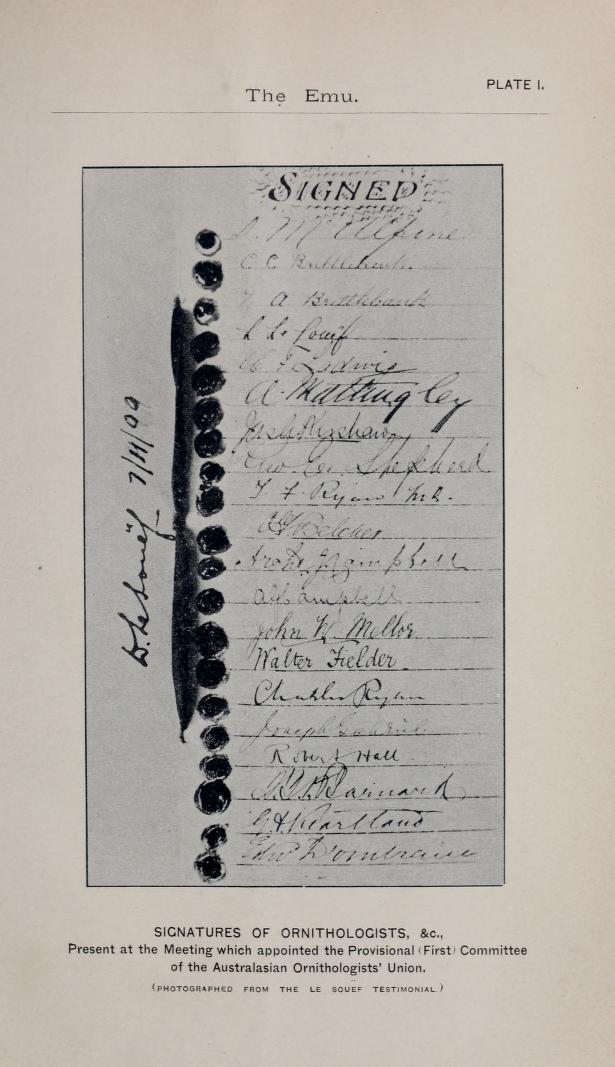
PLATE I. SIGNATURES OF ORNITHOLOGISTS, &c.,
Present at the Meeting which appointed the Provisional First' Committee of the Australasian Ornithologists' Union. (photographed from the Le Souef testimonial.)
FUTURE WORK.
Already the membership roll includes workers whose names are known beyond Australasia, and though the Union is not confined to men who have made so prominent a mark, but includes ordinary bird-lovers as well as scientific ornithologists and oologists (this was necessary to secure the diffusion of knowledge), it should do excellent work. None will deny that there is a wide field to engage the attention of such a body, or that there is much to be done both in the field and the cabinet. There are technicalities to be settled, doubtful points to be cleared up, and mysteries of nesting, &c., to solve. Our knowledge of bird life is incomplete ; it is probable that many new species remain to be discovered ; and some of the genera are in danger of passing away altogether unless something is done to save them. The efforts of isolated workers cannot be so effective in such a cause as if all interested acknowledge their undoubted interdependence and combine to render mutual aid, to correct one another's observations, deductions, or plans by the light of their own experience, and to assist in the common cause.
The Australasian Union has a very similar task before it to that which the American Union had, and surely there is no reason why it should not achieve as good results. It ought to be possible to v/rite of our Union, when it has been as long established, in language like that employed by Dr. J. A. Allen, the first president of the American Ornithologists' Union, sixteen years after that body had been formed. What he says emphasizes the need of united action, and shows what can be accomplished by it.
" Between isolated workers in any field, jealousies and misunderstandings arise, which personal contact tends to obliterate. Such was the case with our ornithologists for some, years prior to the founding of the Union.
There were two rival check lists of North American birds, each, perhaps, equally authoritative, though differing in important details, which led to confusion and a tendency to array our ornithologists into two hostile camps.
This being recognized as a threatening evil of considerable gravity, one of the first acts of the Union was to appoint a committee on the classification and nomenclature of North American birds, so constituted as to include the most competent authorities on the subject and at the same time safeguard all conflicting interests. The work of this committee long since became a matter of history. It was conducted with the utmost conscientiousness and care ; personal interests and personal bias were generously waived ; differences of opinion were settled by appeals to facts and the evidence, with the result that agreement was established in respect to all points of nomenclature and other technicalities, and a new impetus given to systematic investigation. Thus, through the work of this committee alone, one of the primary objects in view in founding this Union was most happily accomplished."'
After alluding to such important matters as " Bird Migration," " The Sparrow Pest," &c., Dr. Allen mentions that at the second congress of the Union it appointed a Committee on Protection of North American Birds, which has been continued to the present time, and has been an influence for good in this great economic and humanitarian work.
In the important matter of bird protection there is a great task before the Australasian Union. The Field Naturalists' Club of Victoria has done some good work locally from time to time. The Australasian Association for the Advancement of Science promised to be a larger sphere of usefulness in this direction. But possibly it has " too many irons in the fire," and the meetings only once every two years are not conducive to the continuous efforts needed for effective bird protection. At the Association's first (Sydney) session, 1887, a paper was read on "The Protection of Native Birds" {vide vol. i., p. 338), and Professor Baldwin Spencer secured the appointment of a committee to consider and investigate the question (page 33).
The committee was reconstructed at the following (Melbourne) session, and brought up its recommendations (amended and approved by the Council) at Adelaide, 1893 {znde vol. v., p. 241, 242). But although eight years have passed since then, nothing practically has been done, except to carry out the one relating to the preparation of a systematic list of vernacular names for Australian birds, which was adopted at Sydney (1898) and published in vol. vii., pp. 128-154.
Probably one of the first acts of the Australasian Ornithologists' Union will be to start where the Adelaide Committee of the Australasian Science Association left off — namely, with the recommendations, which for the most part are these : —
(1.) That close reserves, controlled by local honorary trustees, and supported by Government grants, should be proclaimed.
(2.) That the existing game laws should be strictly enforced.
(3.) That in all Game Acts provisions should be made for the proclamation of districts, comprising both Crown lands and private property, wherein particular species may be absolutely protected for indefinite periods.
(4.) That special legislation should be introduced in all the states to provide for the protection of animals of economic value or particular biological interest.
(5.) That a standing committee of local naturalists should be appointed in each State to deal with the protection of the native fauna.
All this cannot be accomplished at once, and it must ever be remembered that ornithologists and bird-lovers will have to " hammer, hammer, hammer " at some very apathetic skulls before due protection is achieved. The public must first be roused, then never be permitted to ignore the desired result.
The Union would achieve much, to commence with, if it only got (No. 2) the existing Game Laws strictly enforced and brought into Line, so that it may no longer be lawful to shoot, say, ducks on the left-hand bank of the Murray (Victoria) up to the end of July, and then to shoot on the right-hand bank (N.S.W.) for a month later. Obviously close seasons in similar localities should be assimilated.
" THE EMU."
The Emu (with the motto " Birds of a feather ") is intended to be " an outward and visible sign " of union, and should prove of value in the good cause. It will provide a recognized means of intercommunication between all interested in ornithology, whatever their branch of that study may be, and afford all an opportunity of recording facts and valuable observations, and of giving publicity to those and their own deductions. Thus bird students will be kept in touch with one another, original study will be aided, and an Australasian want supplied.
It will be noticed that, despite the fact that Professors A. Newton and R. Lydekker prefer "Emeu " in their " Dictionary of Birds," it has been decided, with all due deference to those eminent authorities, to adopt the common Australian spelling of *' Emu " in the title of this magazine. The reasons are, briefly, that this form of the word has been in use since 1774, is adopted by the new English Historical Dictionary, given as correct by Professor Morris in his " Australian English," and used by most of the standard authorities. It has also been embodied in the vernacular list of the Australasian Science Association, and is generally recognized as correct throughout Australia, where Emeu and its variant Emew are almost unknown. These grounds should be sufficient to stand upon, but, as kindly pointed out by Mr. T. S. Hall, M.A., there is the further consideration that Emeus is the title of an extinct genus of New Zealand struthious birds, and that when it became necessary to allude to members of the Dromaeidae in the plural, as Emeus, confusion might be caused. In conclusion, it may be mentioned that in the endeavour to get the fullest light on the subject an appeal was made to Professor Tucker, Litt. D., who so ably fills the chair of Classics and Philology at the Melbourne University, as to whether there was any classical origin for the word. His answer was that it has "no well-ascertained derivation," and that Emeu (through the current form in olden times) " was only a way of representing the same sound as in Emu (E-mj/oo), and from the phonetic point of view each is incorrect. . . .
The question reduces itself to this — ' Shall we adopt an old, phonetically incorrect, and rather unsettled spelling ; or shall we adopt a spelling which, while phonetically incorrect also, has become usual, is rather neater in shape, and appears free from pedantry ?'.... I should say ' Emu.' " If The Emu sins as to the orthography of its name, which seems hardly probable, it will not be without justification.
The Emu by Australasian Ornithologists' Union; Royal Australasian Ornithologists' Union - Volume 1 (1901/1902). Publication date 1901. Retrieved from: https://archive.org/details/emu1190aust/page/n3/mode/2up
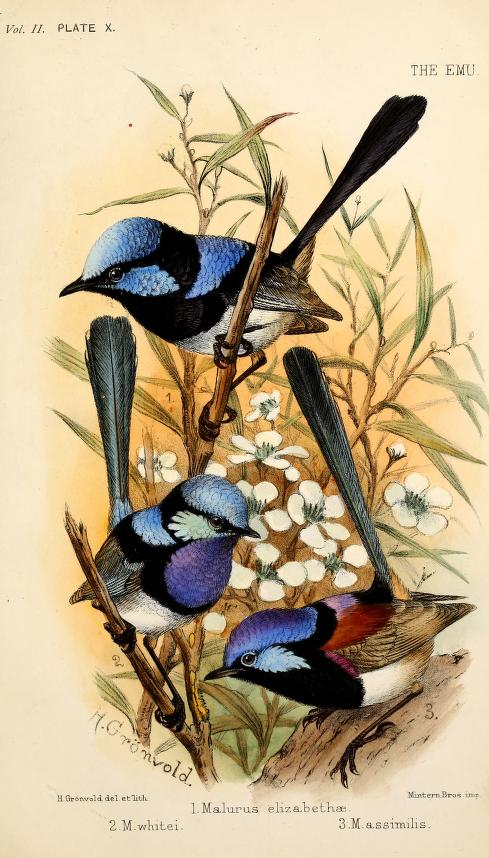
The Emu by Australasian Ornithologists' Union; Royal Australasian Ornithologists' Union, Volume 2, 1902-1903
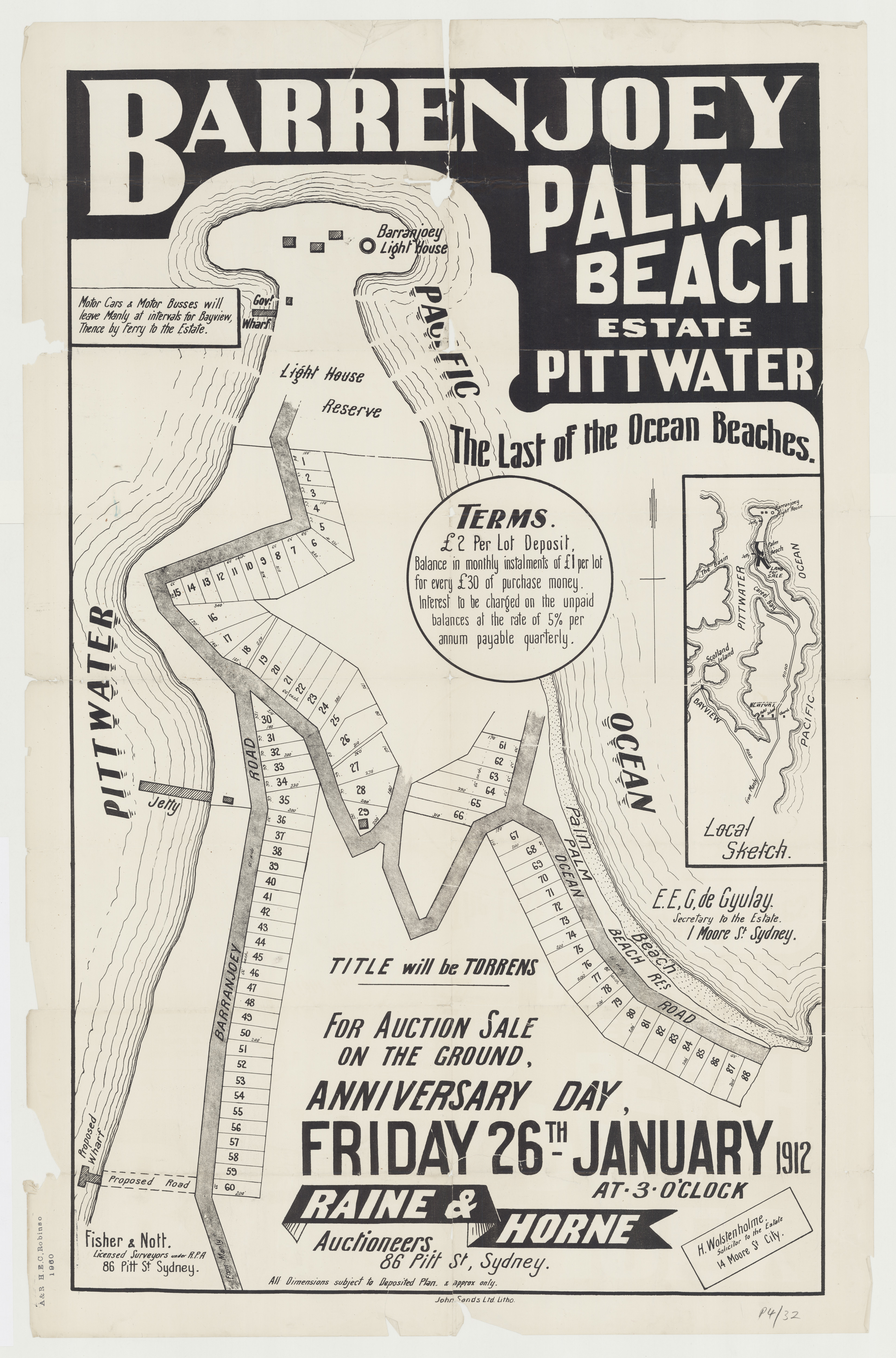
Barrenjoey - Palm Beach Estate - Pittwater - Barranjoey Rd 1912. Item c052700030, courtesy State Library of NSW - H. Wolstenholme, solicitor to the estate.
IN THE MATTER OF THE BARRENJOEY COMPANY, LIMITED.
AT an Extraordinary General Meeting of the above named Company, duly convened and held at 92b Pitt street, Sydney, on the nineteenth day of June, one thousand nine hundred and twenty-four, the following Resolution was duly passed, and at a 'subsequent Extraordinary General Meeting of the Members of the said Company, also duly convened and held at the same place', on Monday, the seventh day of July, one thousand nine hundred and twenty-four, the same Resolution was duly confirmed, as a Special Resolution, viz.: —
That as a result of the recent disposal of substantially the whole of the Company's land, it is advisable to wind-up the Company and accordingly that the Company be wound up voluntarily; and at such last-mentioned Meeting the following Extraordinary Resolutions were passed: —
1. That George Mason Allard, John Malbon Ralston, Ernest Ebenezer Way, and Harry Wolstenholme, be appointed Liquidators for the purpose of such winding-up.
2. That their salary be fixed at one hundred and eighty pounds among them for the first year.
3. That, as regards Mr. J. M. Ralston, he shall be entitled, in addition to his remuneration as a Liquidator, to be paid all usual Solicitor's Profit Costs and Disbursements in connection with any legal work which he may be instructed to do by the Liquidators in his capacity as solicitor.
Dated at Sydney, this 17th day of July, 1924.
H. WOLSTENHOLME, Chairman.
Witness,—E. E. G. de Gyulay. £1 12s.
IN THE MATTER OF THE BARRENJOEY COMPANY, LIMITED. (1924, July 18). Government Gazette of the State of New South Wales (Sydney, NSW : 1901 - 2001), p. 3572. Retrieved from http://nla.gov.au/nla.news-article222025488
THE BARRENJOEY COMPANY LIMITED, (In Voluntary Liquidation).
Notice of General Meeting.
NOTICE is hereby given in pursuance of section 141 of the Companies Act, 1899, that a General Meeting of the Members of the abovenamed Company will be held at the registered office, 92b Pitt-street, Sydney, on Tuesday, the 14th day of May, 1929, at 4 o'clock in the afternoon, for the purpose of having an account laid before them showing the manner in which the winding-up has been conducted and the property of the Company disposed of, and of hearing any explanation that may be given by the Liquidators; and also determining by Extraordinary Resolution the manner in which the books, accounts and documents of the Company and the Liquidators thereof shall be disposed of.
Dated the tenth day of April, 1929.
H. WOLSTENHOLME, E. E. WAY, J. M. RALSTON, ) Liquidators. 3281 £1 2s. THE BARRENJOEY COMPANY LIMITED (IN VOLUNTARY LIQUIDATION). (1929, April 12). Government Gazette of the State of New South Wales (Sydney, NSW : 1901 - 2001), p. 1670. Retrieved from http://nla.gov.au/nla.news-article223026442
First directors of 'Palm Beach Lands':
Palm Beach Lands, Ltd., has effected registration with an authorised capital of £15,000, in £1 shares. To traffic in land, house, and other property is the aim of the new company. First directors: R. R. M'Kay, E. B. Harkness, and A. M. K. Scott. COMPANY NEWS. (1924, July 31). The Sydney Morning Herald (NSW : 1842 - 1954), p. 11. Retrieved from http://nla.gov.au/nla.news-article16177971
In fact R T McKay was Chairman of this new company, not R R McKay. This new group enlisted the expertise of Willmore and Randell, who were looking after Avalon Beach subdivisions by then. Their take on selling block of land at Palm Beach was to focus on the company new owners would be among, not the permanent residents.
Harry's wife passed away in 1947:
WOLSTENHOLME, Edith Lucy -July 28, 1947, at Pymble, widow of the late Harry Wolstenholme, mother of Arthur, Marjorie, and Harry. Private cremation. Family Notices (1947, July 30). The Sydney Morning Herald (NSW : 1842 - 1954), p. 26. Retrieved from http://nla.gov.au/nla.news-article18037383
Sydney, 24th April, 1930.
BY-LAWS FOR THE MANAGEMENT OF KU-RING GAI CHASE PUBLIC RECREATION GROUND.
HIS Excellency the Lieutenant-Governor, with the advice of the Executive Council, having approved of the following By-laws, made in substitution for those heretofore in force for the management of the land at Hawkesbury River (Cowan Creek and Pitt Water), known as Kuring-gai Chase, area about 35,300 acres, dedicated 14th December, 1894, for Public Recreation, and the following Additions thereto, namely, 3 acres 1 rood 20 perches at Towler's Bay, Pitt Water, dedicated 12th July, 1911; 15 acres and 7 acres 1 rood at Coaster's Retreat, Pitt Water, dedicated 2nd August, 1911; and 42 acres 2 roods 7 perches at The Basin, Pitt Water, dedicated 31st August, 1917; such By-laws are published for public information, in accordance with the provisions of the Public Parks Act, 1912. (Parks, &c. 1930-3,770)
R. T. BALL, Minister for Lands.
We, the trustees of the land at Hawkesbury River (Cowan Creek and Pitt Water) known as Ku-ring-gai Chase, area about 35,300 acres, dedicated 14th December, 1894, for Public Recreation, and the following additions thereto, namely:—3 acres 1 rood 20 perches at Towler's Bay, Pitt Water, dedicated 12th July, 1911; 7 acres 1 rood and 15 acres at Coaster's Retreat, Pitt Water, dedicated 2nd August, 1911; and 42 acres 2 roods 7 perches at the Basin, Pitt Water, dedicated 31st August, 1917, do hereby make, under the Public Parks Act, 1912, and by virtue of the powers thereby conferred, the following By-lawS for the management thereof:—
Proceedings of Trustees.
1. All By-laws heretofore made and notified in the Government Gazette are hereby repealed.
2. A regular meeting shall be held in each month, and special meetings when authorised by the President, or in his absence the Vice-President.
3. All meetings shall be called by circular, posted three days before the day of meeting.
4. A quorum for transaction of business shall consist of five members, excepting as otherwise provided under deed of grant.
5. The trustees shall annually elect a President and Vice-President, but in their absence from any meeting any other trustee may preside.
6. The annual meeting shall be held in the month of July, or as soon after as convenient in each year, at which meeting the President, Vice-President, and such other officers and committees as may be approved shall be elected.
7. Any vacancy shall be filled up at the next regular meeting after the occurrence of such vacancy.
8. No resolution passed at any meeting shall be rescinded unless upon notice given and entered upon the notice-paper.
9. The secretary shall keep a proper record of the proceedings of each meeting.
General.
10. No person shall without the permission of the trustees, cut, remove, or deface any rocks, soil, sand, mineral, trees, shrubs, ferns, palms, plants, seats, tables, gates, posts, fences, tanks, vessels, buildings, ^wharves, jetties or notices or write or paint, or otherwise mark thereon, or shall affix any bill, notice or stencil mark to any rock, trees, seat, table, gate, post, fence, wall, roof, pillar, railing or to any vessel, building, wharf, jetty, or any other erection within the Chase.
11. No person, unless authorised by the trustees, shall deface or remove any aboriginal drawings or chippings on rocks, dig up or remove any banks of shells and refuse (presumably aboriginal kitchen middens) in search of skulls, bones, or other aboriginal remains.
12. No person, unless authorised by the trustees, shall use or carry firearms within the Chase, or bring sporting dogs into same, or interfere with, or capture, or destroy any birds or animals therein.
13. No person, unless authorised by the trustees, shall depasture any horses, cattle, sheep, or stock of any kind in the Chase.
14. All dogs, pigs, goats or any other animal, found doing any damage within the Chase, or found within any ornamental plantation or reserve set apart for the preservation or use of deer, or any other animal or birds, may be destroyed or impounded by any employee or other authorised person.
15. No person, unless authorised by the trustees, shall hunt or disturb the native or introduced birds, or animals, in the Chase.
10. No person shall bathe or swim dogs, or otherwise pollute the water, in any fresh-water stream, tank or reservoir on the Chase.
37. No person shall, within public view, bathe in any water upon the Chase, unless clothed from neck to knee in proper bathing costume.
38. No person, unless authorised by the trustees, shall expose any article for sale in the Chase.
19. No person in a state of intoxication shall enter or remain within the Chase, and no person shall behave in a disorderly or'offensive manner, or use any bad language, or commit any act of indecency therein, and any person causing annoyance or inconvenience may be removed by any duly authorised person.
20. No person shall erect any tent or other structures on the Chase for the purpose of camping or residing therein except with the permission of the trustees and subject, to any conditions imposed by them when giving such permission. Any person found residing in or occupying any tent or other structures on the Chase without permission or failing to comply with the conditions subject to which such permission was given, shall be liable to a penalty not exceeding £10 (ten pounds).
21. No person shall ride, drive, or park any animal or vehicle within the Chase, except on the rides, drives, roads, or areas set apart or appointed by the trustees for such purposes. Such riding, driving or parking shall be subject to such conditions as the trustees may prescribe and indicate in a, notice affixed or set up in a conspicuous, position at or near to any entrance to or within the Chase.
22. No person shall, without the permission of the trustees, place any notice or advertisement on the Chase.
23. No person shall, without the permission of the trustees, have fixed or permanent moorings for any ship, boat, punt, or other vessel upon the water of the Chase.
24. No person shall obstruct or interfere with any employee of the Chase while in the execution of his duty.
25. The annual fees to be charged for licenses for the mooring of vessels within the boundaries of the Chase shall be:—
Class 1—Mooring, being the property of and intended . for use of an oversea, Interstate or State shipping company, £5 per annum; Class 2—Mooring intended for use in connection with i business carried on at docking premises, £1 per annum; Class 3—Mooring for a vessel 100 feet in length and upwards, and not covered by Class 3 or 2, £1 10s. per annum; Class 4—Mooring for a vessel 50 feet and under 100 feet in length, £1 per annum; Class 5—Mooring for a vessel 40 feet and under 50 feet in length, 15s. per annum; Class 6—Mooring for a vessel 30 feet and under 40 feet in length, 10s. per annum; Class 7—Mooring for a vessel 25 feet and under 30 feet in length, 7s. <3d. per annum; Class 8—Mooring for a vessel under 25 feet in length, 5s. per annum; and shall be paid annually in advance on or before the first day of January in each year.
26. Any person offending against any one of these by-laws may be forthwith removed from the Chase, and shall be liable to a fine not exceeding £10 (ten pounds).
27. Any trustee of Ku-ring-gai Chase, or any officer or employee of the trustees, or any member of the police force, or any other person duly authorised by the trustees, shall be the person or persons authorised to enforce the foregoing by-laws.
Made at Sydney, this 13th day of February, 1930.
ROBERT HOLLIS,
HOWARD JOSELAND,
FRANK CHAPMAN,
EDWARD M. CLARK,
F. ANTILL POCKLEY,
E. W. QUIRK,
RICD. BRAMSTON,
H. WOLSTENHOLME,
MAC. ABBOTT,
J. GARRARD,
R. B. ORCHARD,
ARTHUR GRIFFITH,
T. MARSHALL,
W. A. HOLMAN,
R. H. LEVIEN,
T. W. SPENCER,
Trustees.
The Common Seal of the Trust was hereto attached by authority and order of the Trustees dated 13th February, 1930.
(l.s.) F. I. W. HARRISON, Secretary.
BY-LAWS FOR THE MANAGEMENT OF KU-RINGGAI CHASE PUBLIC RECREATION GROUND. (1930, May 2). Government Gazette of the State of New South Wales (Sydney, NSW : 1901 - 2001), p. 1774. Retrieved from http://nla.gov.au/nla.news-article223051603
A Christmas Day at Cowan Creek, Hawkesbury River.
(Written for the "Town and Country Journal.")
"For a successful fishing outing," declared Daylesford, "you must be on the water by peep o' day."
The youth, who was anxiously watching the horizon for the moon-rise to enable him to commence a possum hunt, concurred very heartily. The languid man, with his pipe drawing particularly well, and his hip jammed snugly in a heap of ferns, approved of early rising on hygienic principles, but thought fish that hadn't the decency to wait until noon to be caught would in all probability be lean, highly strung creatures unworthy of angling. But when the youth returned after three hours fruitless stalking of excrescences on gnarled trees, and his lust for sport merely aggravated, his entreaties, added to the supplications of the man who had brought a large number of faded prawns in a stained parcel, were irresistible, and a a.m. start was agreed upon. Even the languid man was aroused to the extent of relating, well on towards midnight, all he had ever thought or read about the ways of awakening at any given hour. The languid man has a tenacious memory-as a matter of fact, he Is too indolent to forget and if it were not for the pleasing circumstance that he has never read or heard of anything of interest, his remarks might keep one awake.
"Goo' ni*." The bait-a succulent prawn, with his feet neatly curled and his whiskers skilfully poised-is adjusted; the line is barely cast before there is a 'tug-tug, and there is a great fish swirling in wide silvery sweeps. We brace our feet against the gunwale, and take a turn of the line round our wrist. The line fairly hums as the great fish strains and swirls in steadily-increasing curves. We catch a glimpse of his bristling fins; we see his widespread eyes agleam with fury. Thunder! He is dragging us over the side. The gunwale is bending under the strain like elastic. The perspiration stands in globules on our forehead; our hair stands on end- over the side, into the green depths.
"Come along-, boys; it's half-past three." The artist, candle in hand, stands, by the bunk. Through the open doorway there is a glimpse of stars. The bed is so cosy; the earth seems so still. Surely, it is nothing short of madness to think about getting up at such a time as this! But the youth, already has his pockets a'bulge with lines, and exudes an odor of very dead prawns, as he divides his time between boiling the billy and filling cartridges from a little mound of powder, so close to the blaze that the languid man is fairly awakened at the sight. The horse, with ferns and dead leaves in its mane, and deep distrustful eyes blinking at the light, submits to be harnessed in a sort of dream, and abstractedly backs into position between the shafts.
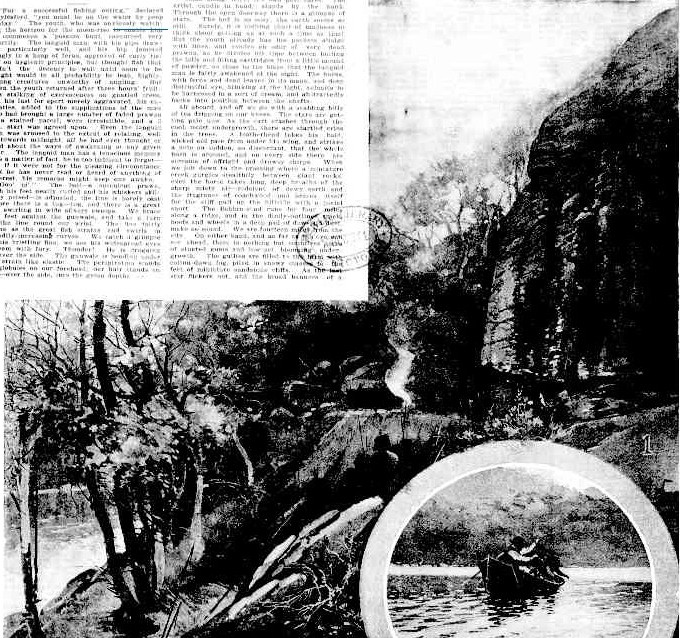 All aboard, and off we go with a scalding billy of tea dripping on our knees. The stars are getting pale now. As the cart crashes through the cool, moist undergrowth, there are startled cries in the trees. A leatherhead takes his bald, wicked old pate from under his wing, and strikes a note so sudden, so discordant, that the whole bush is aroused, and on every side there are screams of affright and drowsy chirps. When we jolt down to the crossing where a miniature creek gurgles stealthily between giant rocks, even the horse takes long, deep breaths of the sharp misty air-redolent of dewy earth and the fragrance of coachwood-and braces itself for the stiff pull up the hillside with a jovial snort. The Bobbin-road runs for four miles along a ridge, and in the dimly-outlined tracks, hoofs and wheels in a deep pad of dewey dust make no sound. We are fourteen miles from the city. On either hand, and as far as the eye can see ahead, there is nothing but countless acres of stunted gums and low-set blooming under growth. The gullies are filled to the brim with cotton-down fog, piled in snowy mass to the feet of miniature sandstone cliffs. As the last star flickers out, and the broad banners of a magnificent day are spread aloft, even the artist is satisfied with the color scheme. We must needs pull up here. This is glorious, but just over the hill there, we could-by jingo! we've forgotten to drink the tea. It's black and bitter, but nobody minds. Across the narrow track enterprising spiders have spun webs, and planned magnificent ambuscades, into which have fallen nothing more substantial than beads of dew that scintillate like diamonds. The horse cleaves through them ruthlessly, adding at every few yards to the gleaming tiara on forelock and ears, while spiders in vesture all too brilliant for their gruesome avocation wave despairing legs in eager effort to repair the shattered nets.
All aboard, and off we go with a scalding billy of tea dripping on our knees. The stars are getting pale now. As the cart crashes through the cool, moist undergrowth, there are startled cries in the trees. A leatherhead takes his bald, wicked old pate from under his wing, and strikes a note so sudden, so discordant, that the whole bush is aroused, and on every side there are screams of affright and drowsy chirps. When we jolt down to the crossing where a miniature creek gurgles stealthily between giant rocks, even the horse takes long, deep breaths of the sharp misty air-redolent of dewy earth and the fragrance of coachwood-and braces itself for the stiff pull up the hillside with a jovial snort. The Bobbin-road runs for four miles along a ridge, and in the dimly-outlined tracks, hoofs and wheels in a deep pad of dewey dust make no sound. We are fourteen miles from the city. On either hand, and as far as the eye can see ahead, there is nothing but countless acres of stunted gums and low-set blooming under growth. The gullies are filled to the brim with cotton-down fog, piled in snowy mass to the feet of miniature sandstone cliffs. As the last star flickers out, and the broad banners of a magnificent day are spread aloft, even the artist is satisfied with the color scheme. We must needs pull up here. This is glorious, but just over the hill there, we could-by jingo! we've forgotten to drink the tea. It's black and bitter, but nobody minds. Across the narrow track enterprising spiders have spun webs, and planned magnificent ambuscades, into which have fallen nothing more substantial than beads of dew that scintillate like diamonds. The horse cleaves through them ruthlessly, adding at every few yards to the gleaming tiara on forelock and ears, while spiders in vesture all too brilliant for their gruesome avocation wave despairing legs in eager effort to repair the shattered nets.
Suddenly, away down through the trees, there is a glimpse of dark, smooth water, with little clouds of mist stirring sluggishly in the morning air. To reach it we must go down a zigzag path, which makes a descent of some 500 or 600 feet in half a down grades. About 100ft above this bay we halt to put up the horse in an enclosure provided for the purpose. Then, by clambering down some steps and falling down a great many more, we arrive abruptly on the roof of the boatman's shed. To awaken him after this procedure is not difficult, and, despite certain opposition on the part of his dog, whose body is adorned with spots in lieu of hair, and which wanted to take samples of our persons for future reference or bait, we are speedily afloat. The languid man, with great adroitness, secured a seat as far from the centres of activity as possible, so we gave him the prawns to mind. In half an hour we are in an ideal spot. On one side dark, beetling cliffs stand straight up from the water's edge, on the other the land, shelves down in a grassy slope to the oyster-clad shingle. The languid man declared, almost with animation, that someday he would work out the point as to whether the three lines with which the youth had determined to fish or the kellick stone had reached bottom first; but it is feared that the matter is too much akin to the passage of thought to be cleared up.
"Ah! Shark! Got him! No! Yes! Ah!" Everybody tries to get out of the road. Everybody knocks over something. The youth, with nerves strung to snapping point, lands a fish. The artist, whose camera has cramps or something in its stomach, casts but a single glance at the flapping creature, and says, "Pshaw!" with great vehemence. The languid man, who is cherishing a great longing to lose the prawns, says, "Never mind, we'll use it for bait." And so, and so, and so, until, after three hours fishing in six different places, the artist, who has laid aside his tools, and is dispensing thick junks of bread and jam, orders us ashore for breakfast. And as the potted things are opened up, and as we sneeze and choke and weep in the smoke that curls through the widespread limbs and dense foliage of the great trees that stand precariously on the water's edge, the youth is not the youngest of us all. The languid man in an abortive cast throws the tea into the fringe of the fire, and gathers and puts it into the pot with such unprecedented haste that nobody has time to stop him. But nectar could not be sweeter. Possibly it is the extraordinary number of sugar ants and other inquisitive insects in it that makes billy tea so good to taste. Anyhow, to the picnicker rejuvenescent nothing comes amiss.
Fisho till noon, and then, under the shaded side of the towering shore, we lazily make for the Bobbin Cave. Out in the bay the water is stirred in little patches by the whispering breaths of a north-easter, and glitters in broad bands of sparkling silver. But under the shaded bank it is unruffled as a mirror. As we gaze down into its limpid depths, we see fine black bream lazily nosing around the stones on the bottom, and every now and then we pass a place where the trees and rocks on the shore and to the very tops of the hills are reflected so clearly that one becomes really startled to see a school of fish disporting in the branches and among the ferns and grass.
Cowan is famed for its caves. In some of them at present there are regular habitations of fisher folk. We passed one in which all the signs of permanent residence are evident. Elderly fowls strut and preen their feathers on the piles of decomposed shells; chickens race after grasshoppers on the grassy slopes, and at the mouth of a cunning little crevice a hen proclaimed to all the world that bright Christmas day that she had done her duty. In a gin case under a shelving rock a colony of bees are housed. For a foraging ground they have broad acres of all the flora that the heart of bee can desire, and for their hoardings there is no doubt a market in the holiday parties that throng the gaily painted houseboats moored in the deep, green bays. Bobbin Cave is a citadel at the mouth of Gibberabong Creek, and it was only by virtue of certain committal statements the languid man had made that he could be induced to consent to our climbing the steep approach to it. Hedged in by rocks bold and perpendicular as masonry, this cavern fulfils even the ideal of the robber cave of boyhood dreams. Its walls are blackened by the smoke of countless ages, and when we stretched ourselves on the smooth floor to digest a great deal more than was safe for any of us to have eaten, we all fell wondering; what sort of scene had. been enacted there on Christmas Day a hundred .years ago. This fastness at the head of the great water, inaccessible from behind and above (where, indeed, on the broad flat rocks there are to this day to be found, graved deep in the surface, many carvings and symbols of a race that is no more) ; with its steep approach, with its unfailing limpid spring; with its deep water fishing and broad expanse of shallows, where tons of luscious shellfish lie easy to the hand-this, surely, was a mighty place. We see the tribesmen gathered here to put their weapons in order for battle with the tribes across the hills, where the low moan of the ocean can be heard on the Barrenjoey sands. That was a favorite battleground, and now and again, when the sea in fury tries to drag back into its depths the barrier it has itself piled up between the Barrenjoey and the mainland, grim evidences of warfare, In the shape of cloven skulls and bones, are laid bare. Or perhaps this was the haven to which the remnant of a stricken army would painfully creep to heal their hurts and plot revenge.
In such a spot as this may have sat in conclave many chiefs, with intertribal feuds buried in face of common dread of the winged terrors arisen from the sea, and discussed and marvelled at the dread language of smoke and death that the white foes spoke.
The languid man said such things ought not to be discussed on Christmas Days. It made him creepy to think of the hordes of spirits wandering about thrusting spears through intangible enemies and hurling spectral boomerangs at palaeontological spooks. He was rather inclined to think that the aborigine would most likely have spent his Christmas here in strict accordance with barbarian ideas of a season of festival. The chances were that the tribesmen, in their forcible way, would have induced the gins and the piccaninnies to hasten to the cockle patch down yonder to fill their dilly-bags with mussels and so on, while the warriors made off across country to look for shoals of mullet. These fish, went on-the languid man, came into the river, mouths, etc.,.. to spawn in the shallows, and of course the blacks could take it nice and easy, and wait for them to swim past places at which spearing could be performed to advantage. Of course, nobody wants to say that the warriors were entranced with the sport, or anything like that, but no doubt they would get about wearied to death by the end of the year of such beastly rough work as wallaby hunting, and they would, no doubt, be regularly nauseated with possum done in the skin, and cooked by women without cookery books. So, of course, they'd get as many fine fat mullet as possible, bring them home, and let the gins cook them here. Then, when all hands were so full that they couldn't eat anymore, the sensible savages would go to sleep and have a rest from the infernal racket of cicadas.
And all the time the artist, with his mind on those Christmas days at home when, seated in a box over a hole in the thick ice, he would sit and spear fish in the clear depths, spoke not. His camera had played him false. The spring upon which he placed his sole reliance was supine as a boiled feather. And so he refused to stock his mental pantry with any jars of romance done up in aboriginal labels. Romance that, you could not get at with a camera is something that does not appeal to his modern soul, and so, with his feet back once more on his native heath of asphalt pavement and wood-blocked road, he refers to Cowan, not as the gem of natural beauty amid the home of old romance, but as "the place where my camera broke down”.
Cowan Creek, Hawkesbury River sketches: 1-In the Days of the Aborigines. 2.-The Big Cave. 3-A Fishing Party. (See letterpress on previous page.) A Christmas Day at Cowan Creek, Hawkesbury River. (1901, December 14). Australian Town and Country Journal (NSW : 1870 - 1907), p. 24. Retrieved from http://nla.gov.au/nla.news-article71475710
Album Of Photographs Of Ku-Ring-Gai Chase National Park And Wolstenholme Family, 1893-1896 / Probably Compiled By Harry Wolstenholme
SOURCE: Presented by John Wolstenholme, 2014 - many have captions below the photograph
Courtesy Mitchell Library, State Library of New South Wales
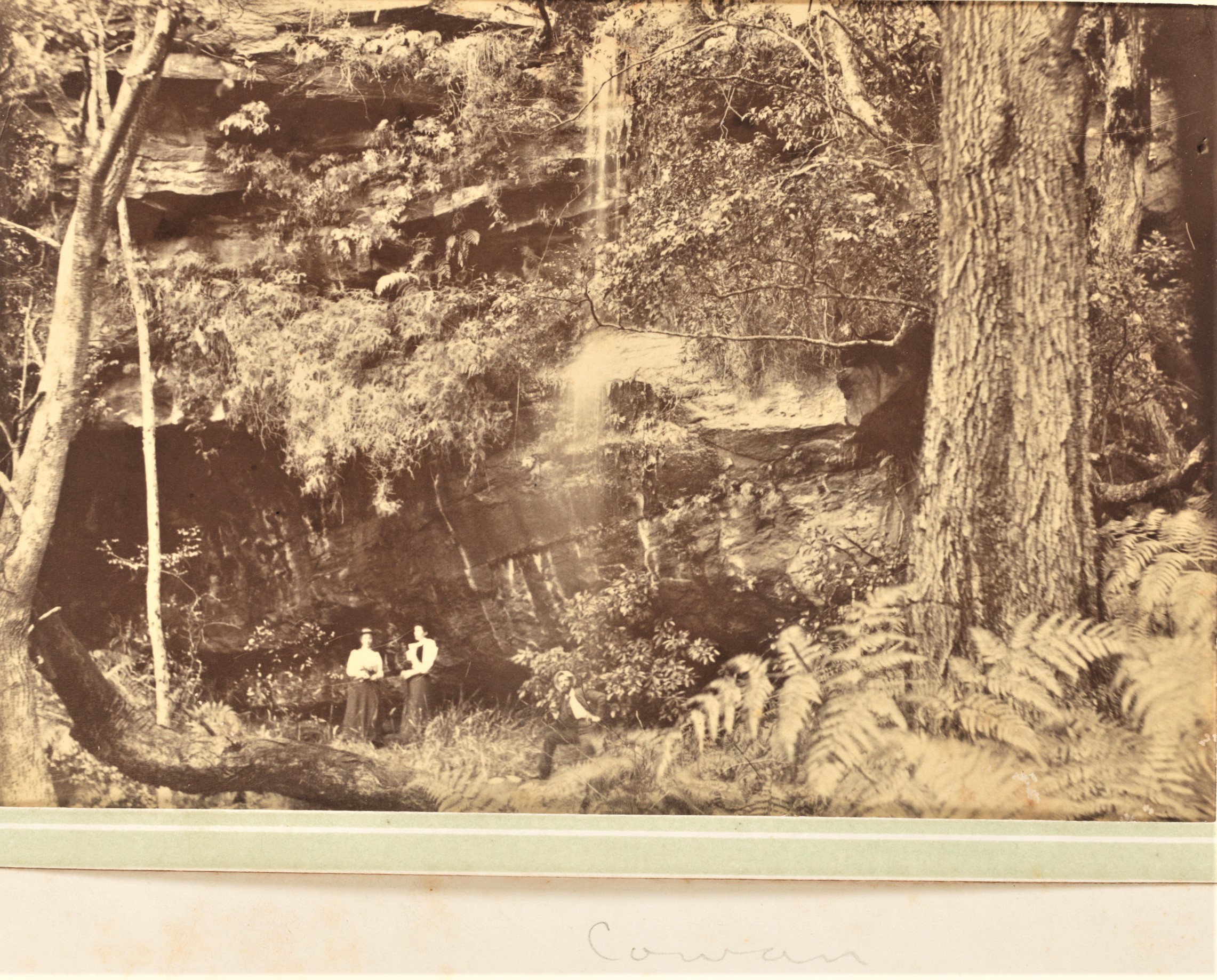
1. Cowan - Item: c051620007
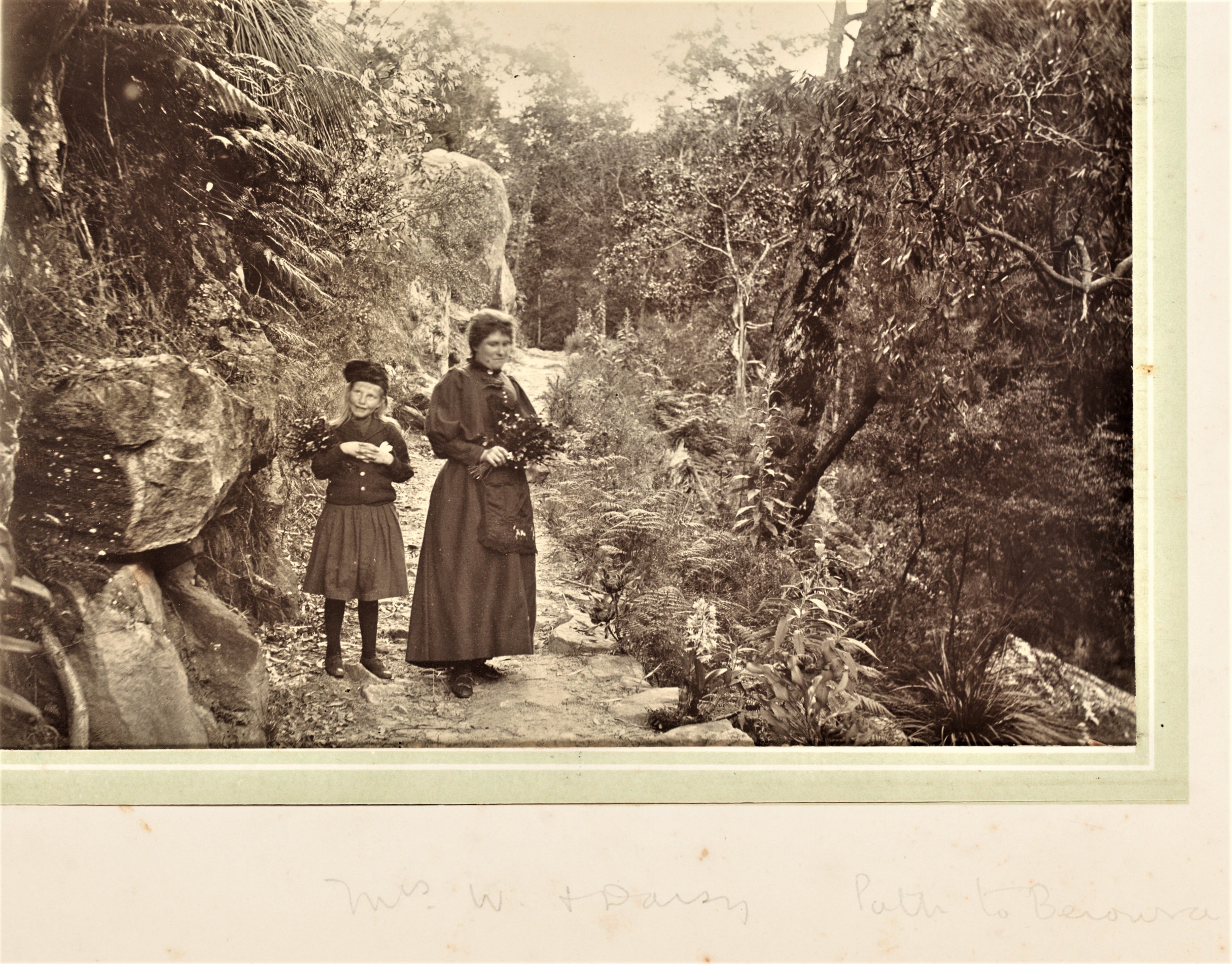
2. Mrs W. and Daisy. Path to Berowra - Item: c051620008
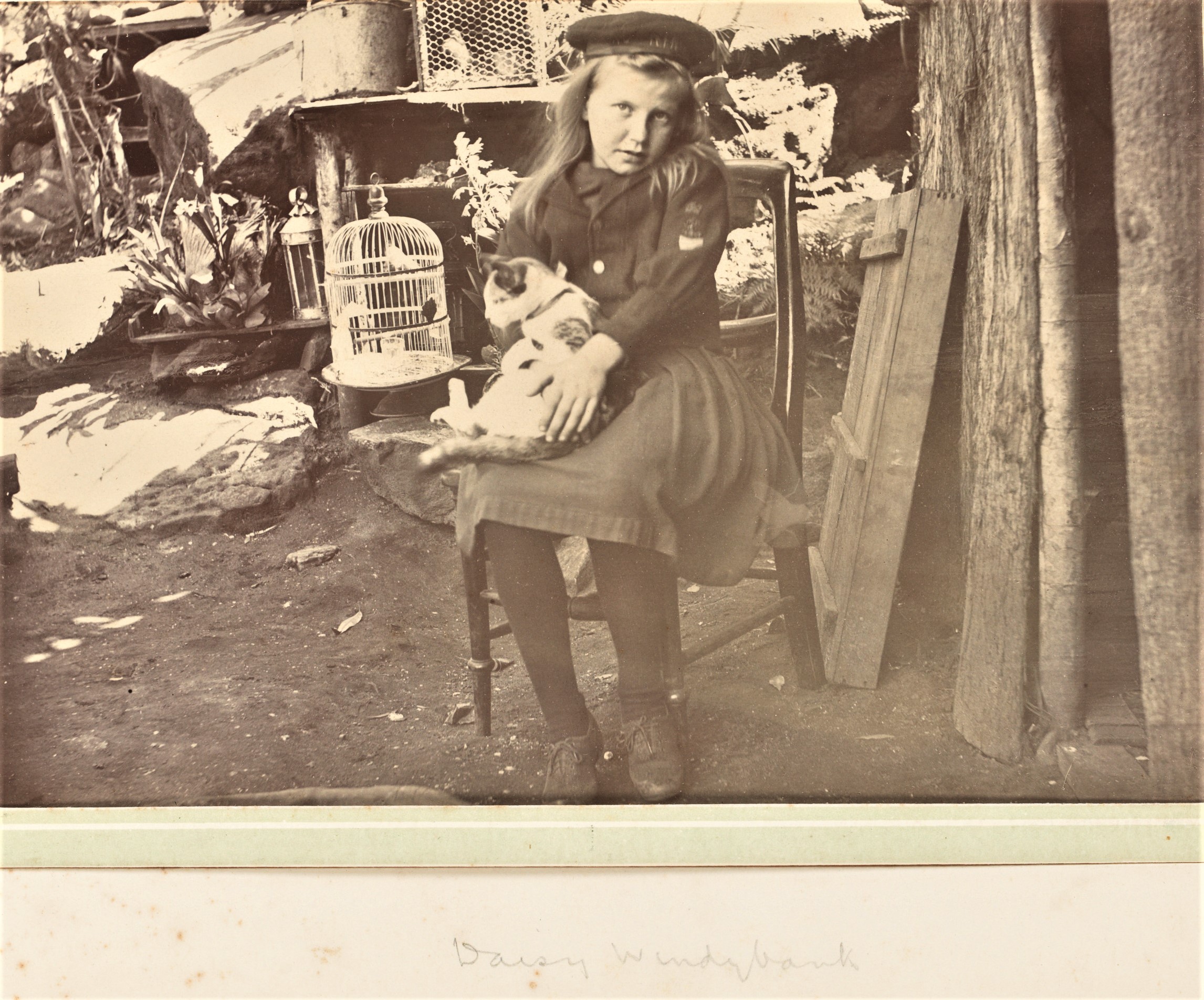
3. Daisy Windybank - Item: c051620009
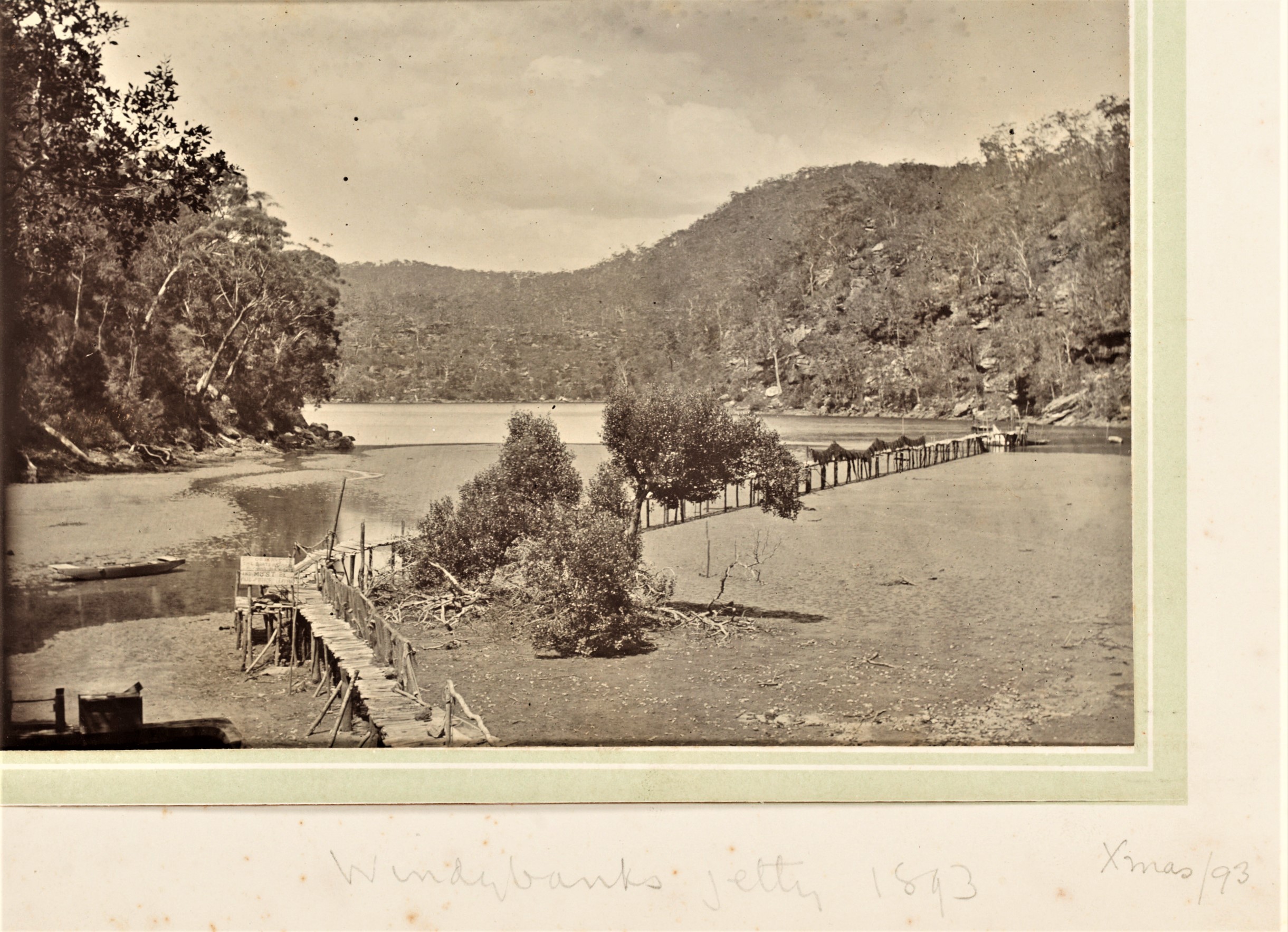
4. Windybank's Jetty 1893. Xmas '93 - Item: c051620010
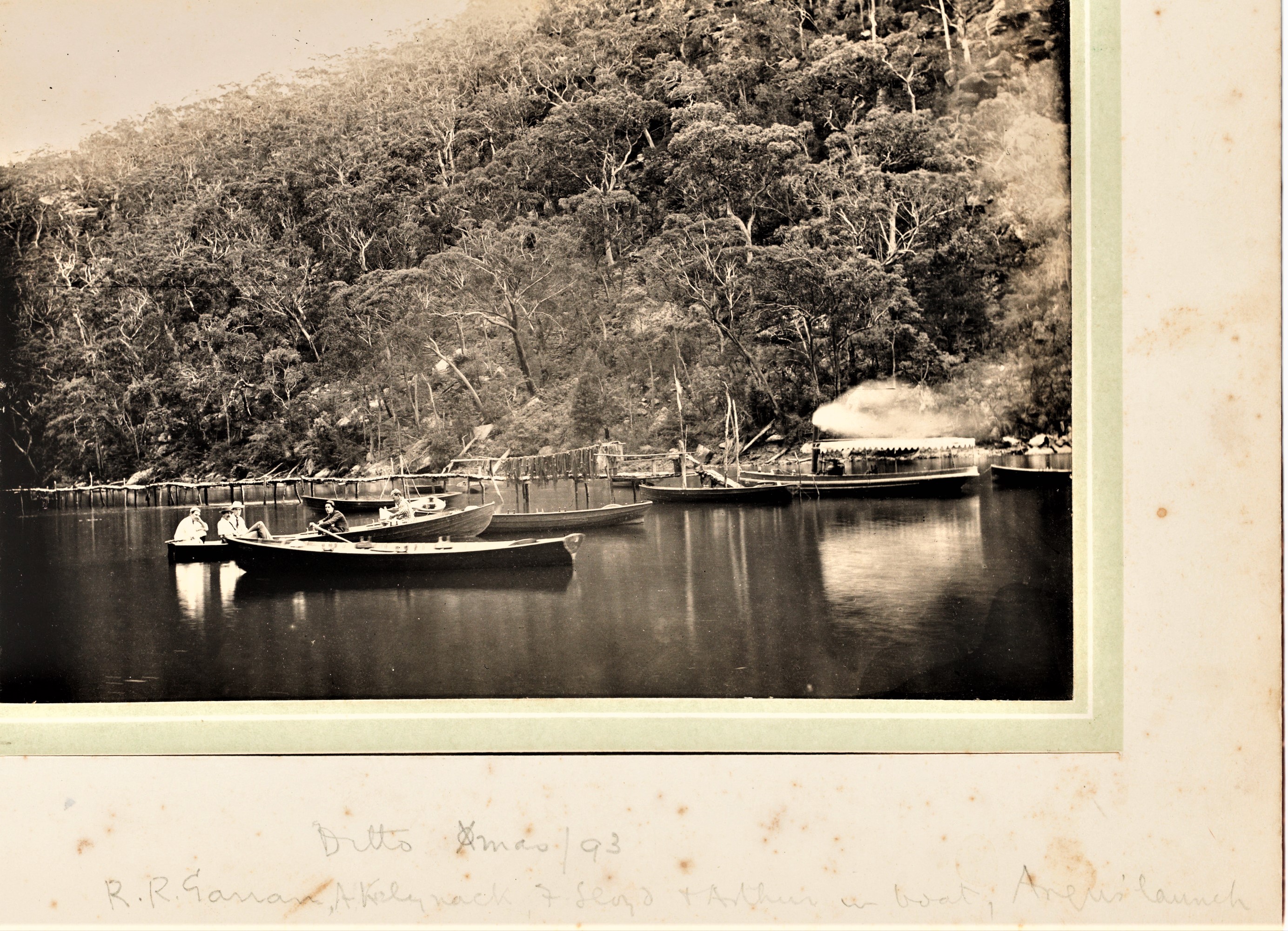
5. Ditto Xmas '93. R. R. Garran, A. Kelynack, and Lloyd and Arthur in boat, Arthur's launch - Item: c051620011
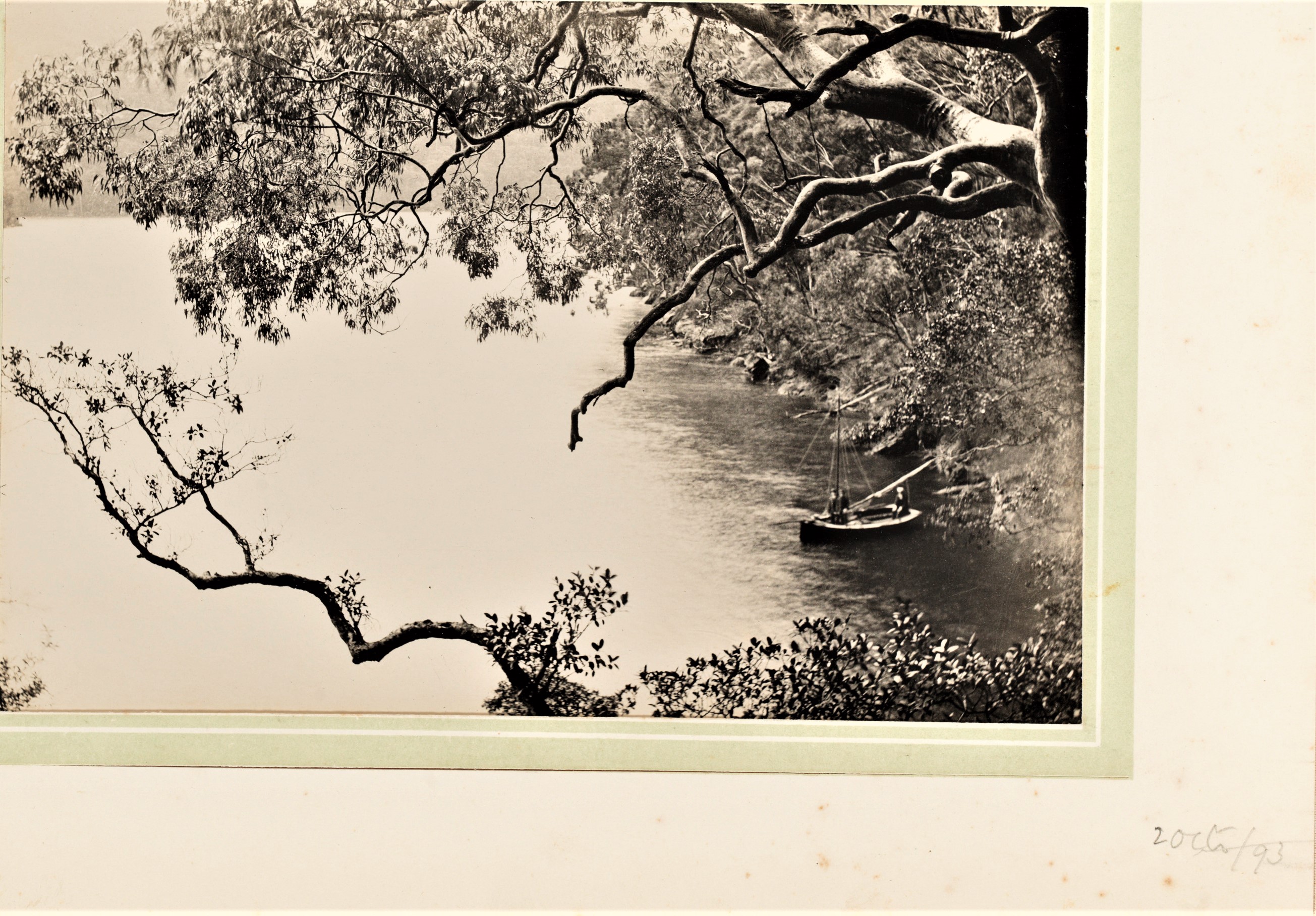
6. 2 Oct. '93 [sailing boat] - Item: c051620012
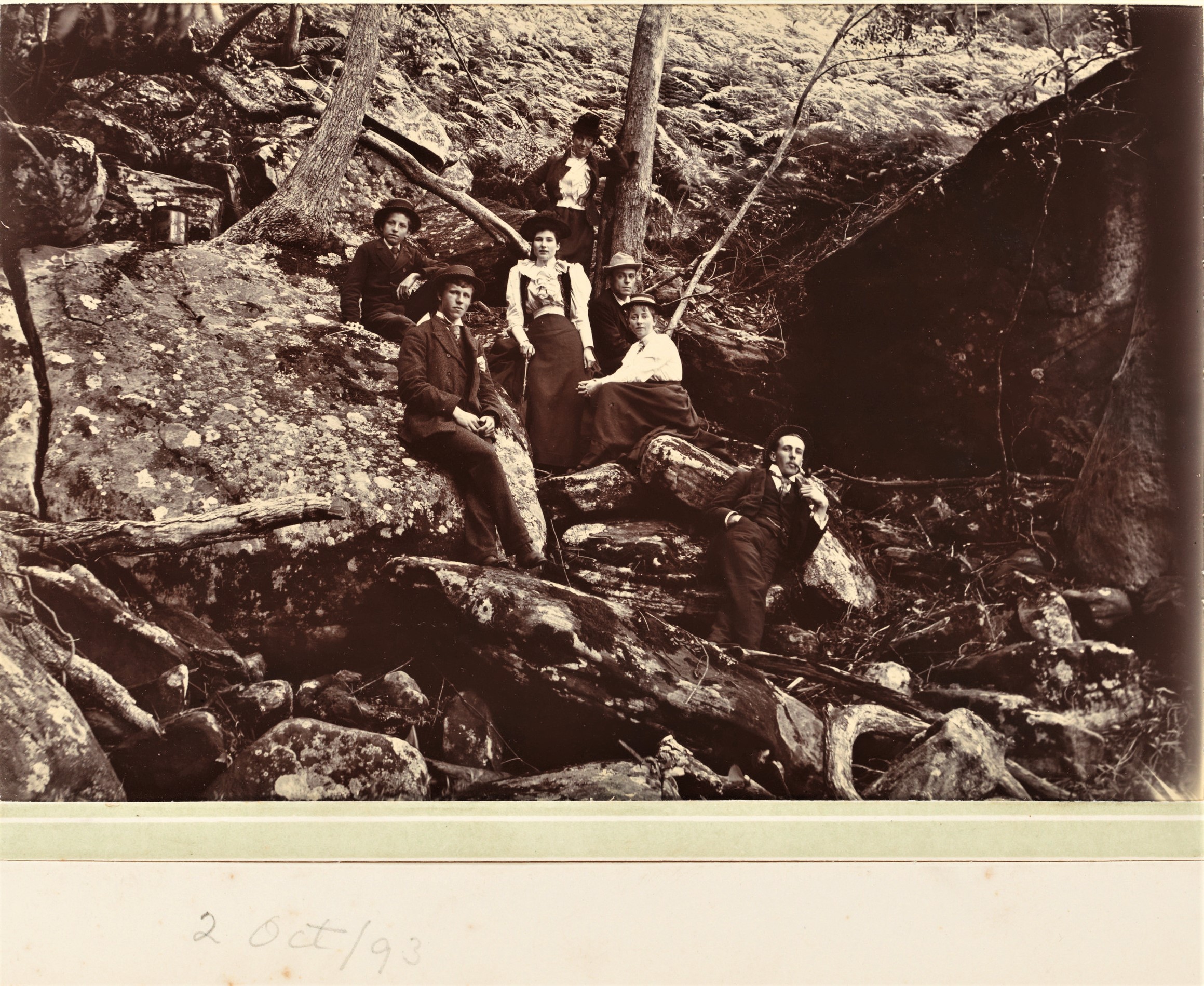
7. 2 Oct. '93 [four men and three women posing in riparian setting] - Item: c051620013
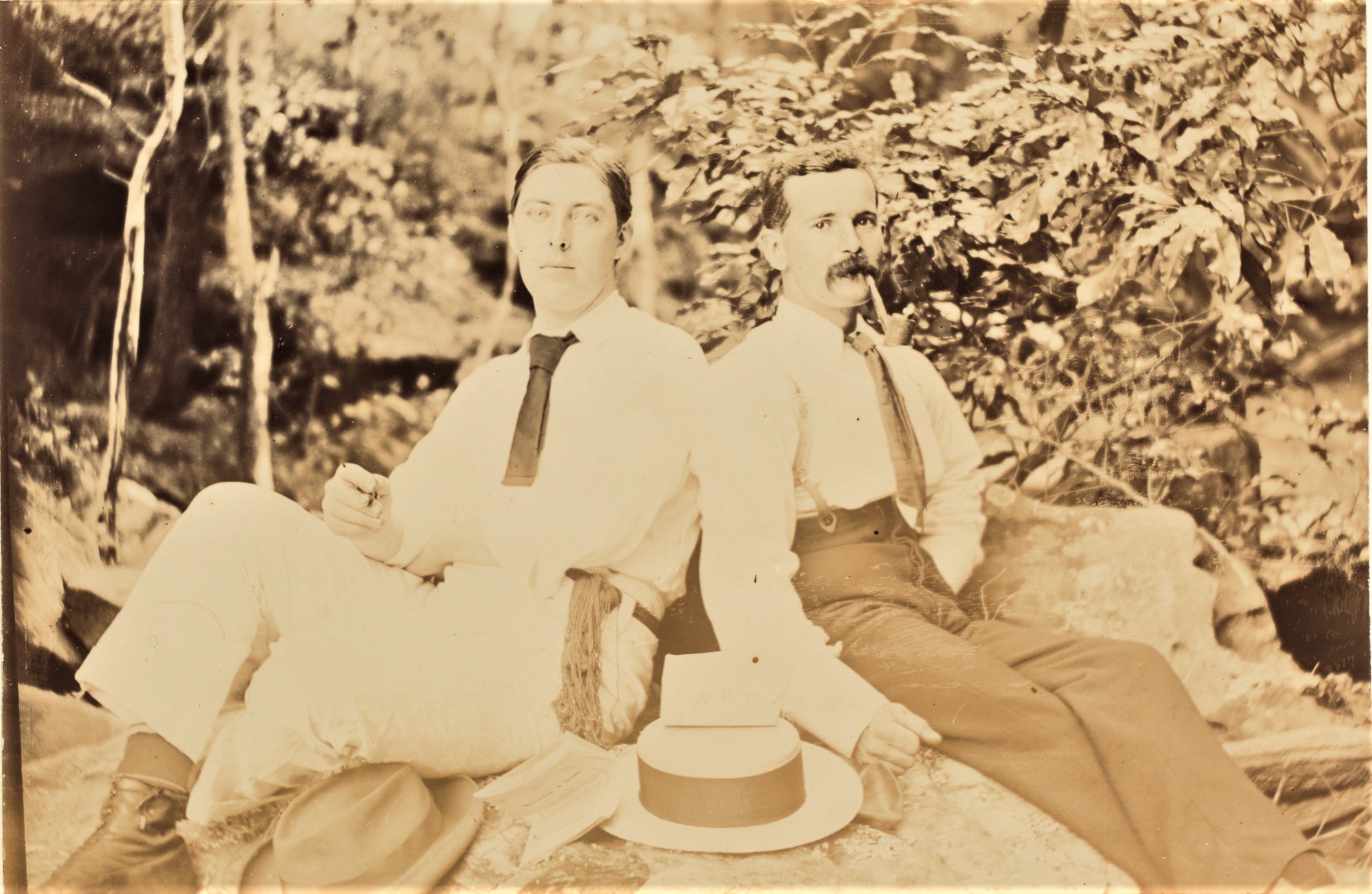
8. [Two men sitting on rock] - Item: c051620014
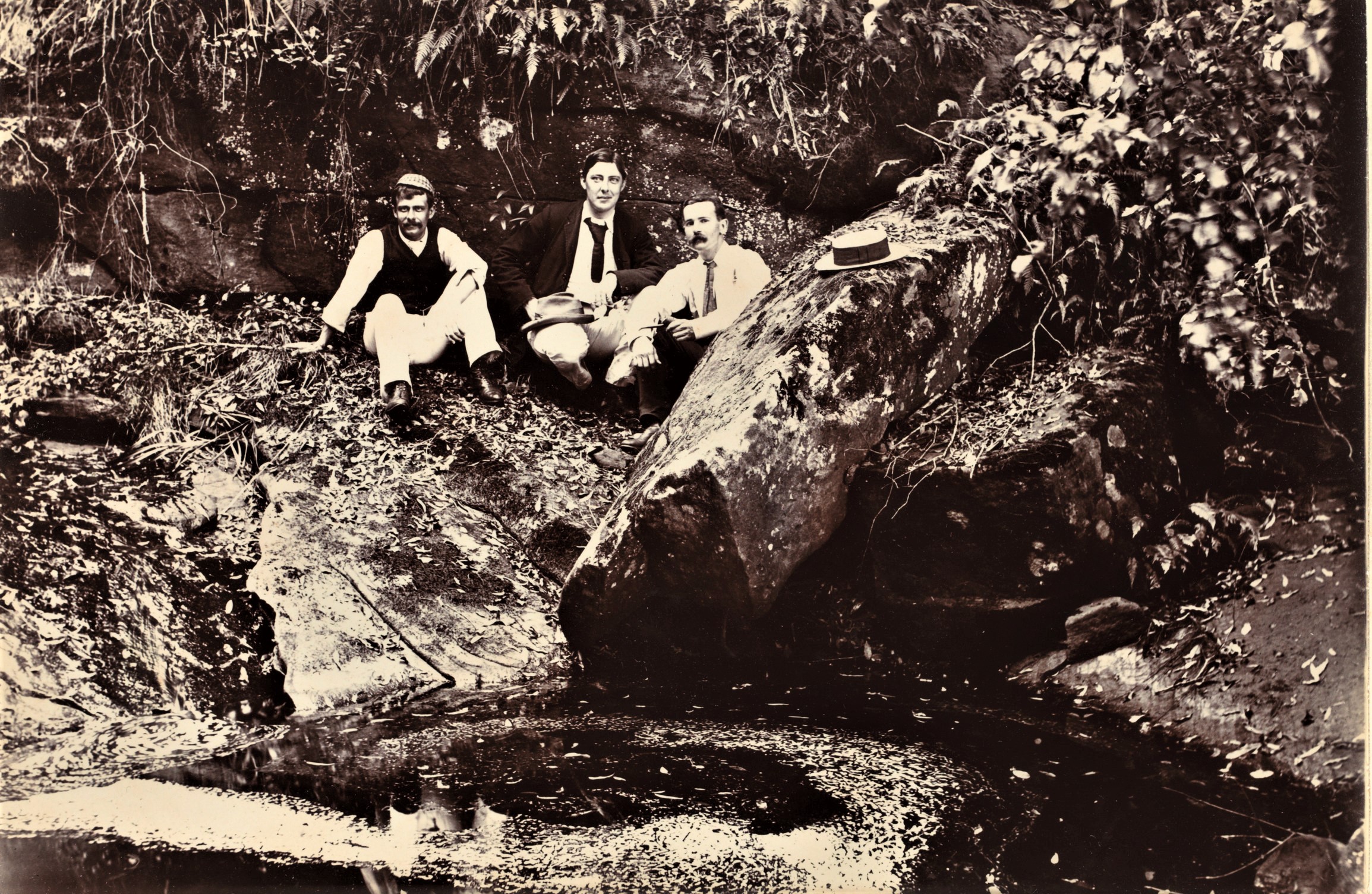
9. [Three men sitting on rock near pool] - Item: c051620015
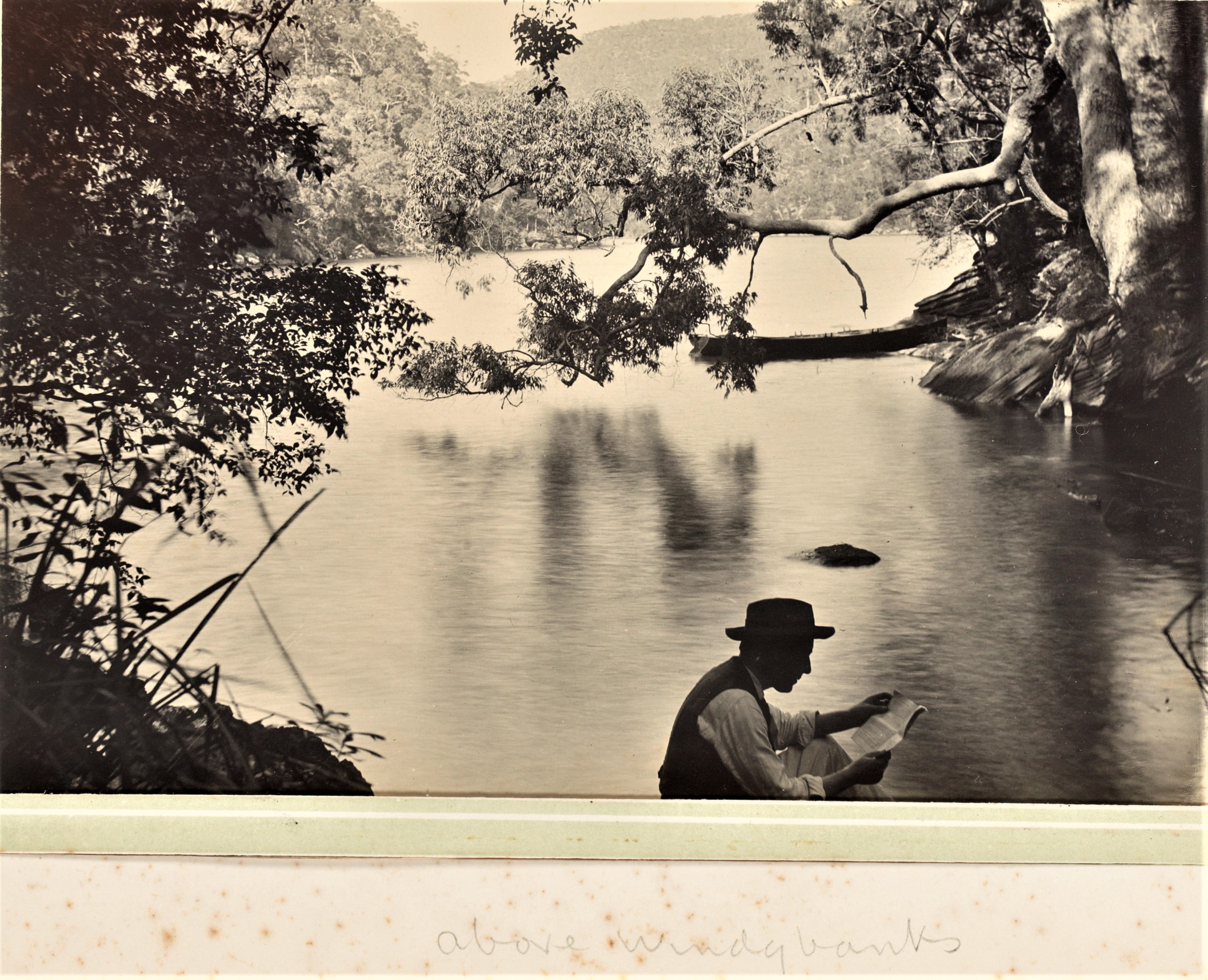
10. Above Windybanks - - Item: c051620016
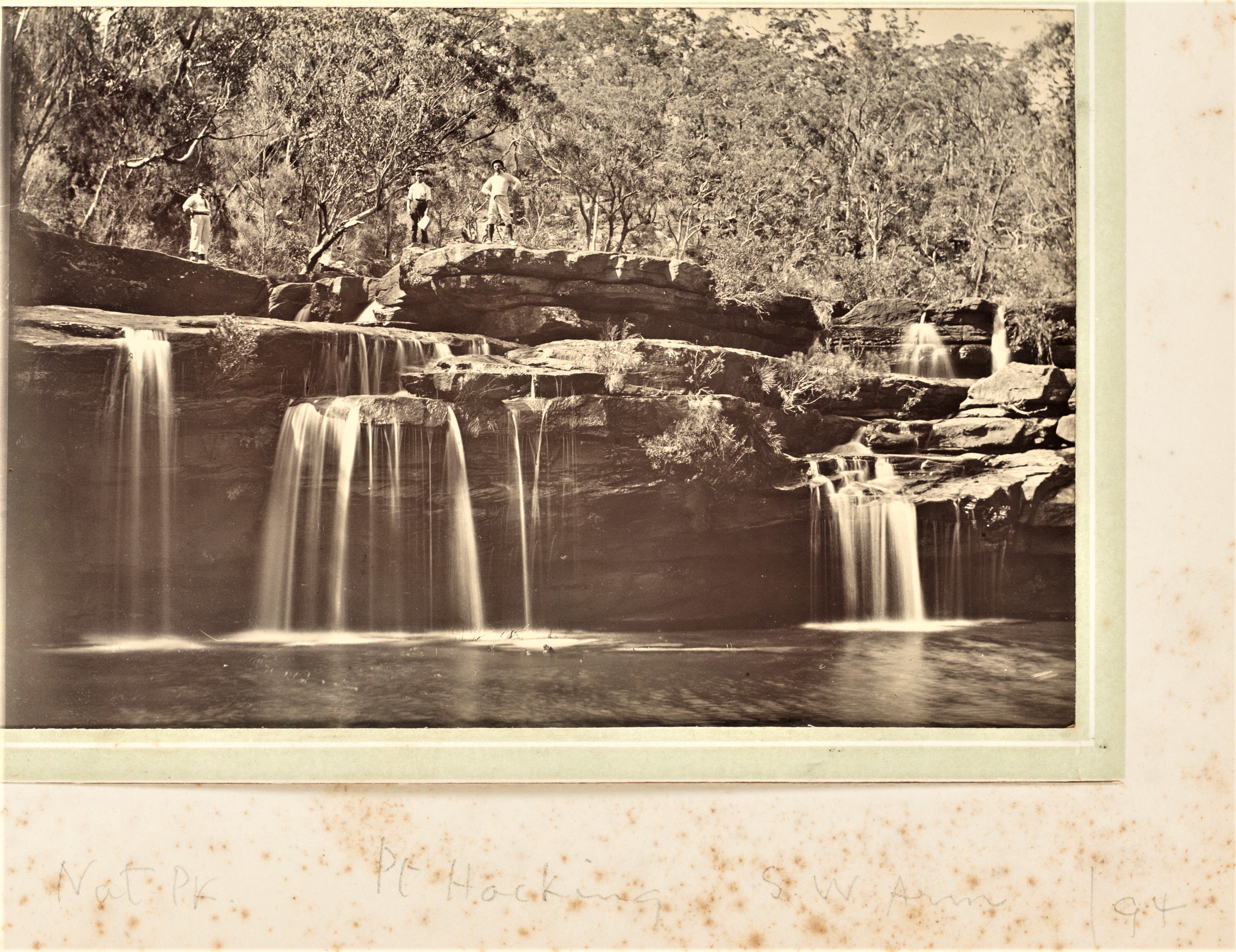
11. Nat. Pk. Pt Hocking S.W. Arm[?] '94 - Item: c051620017
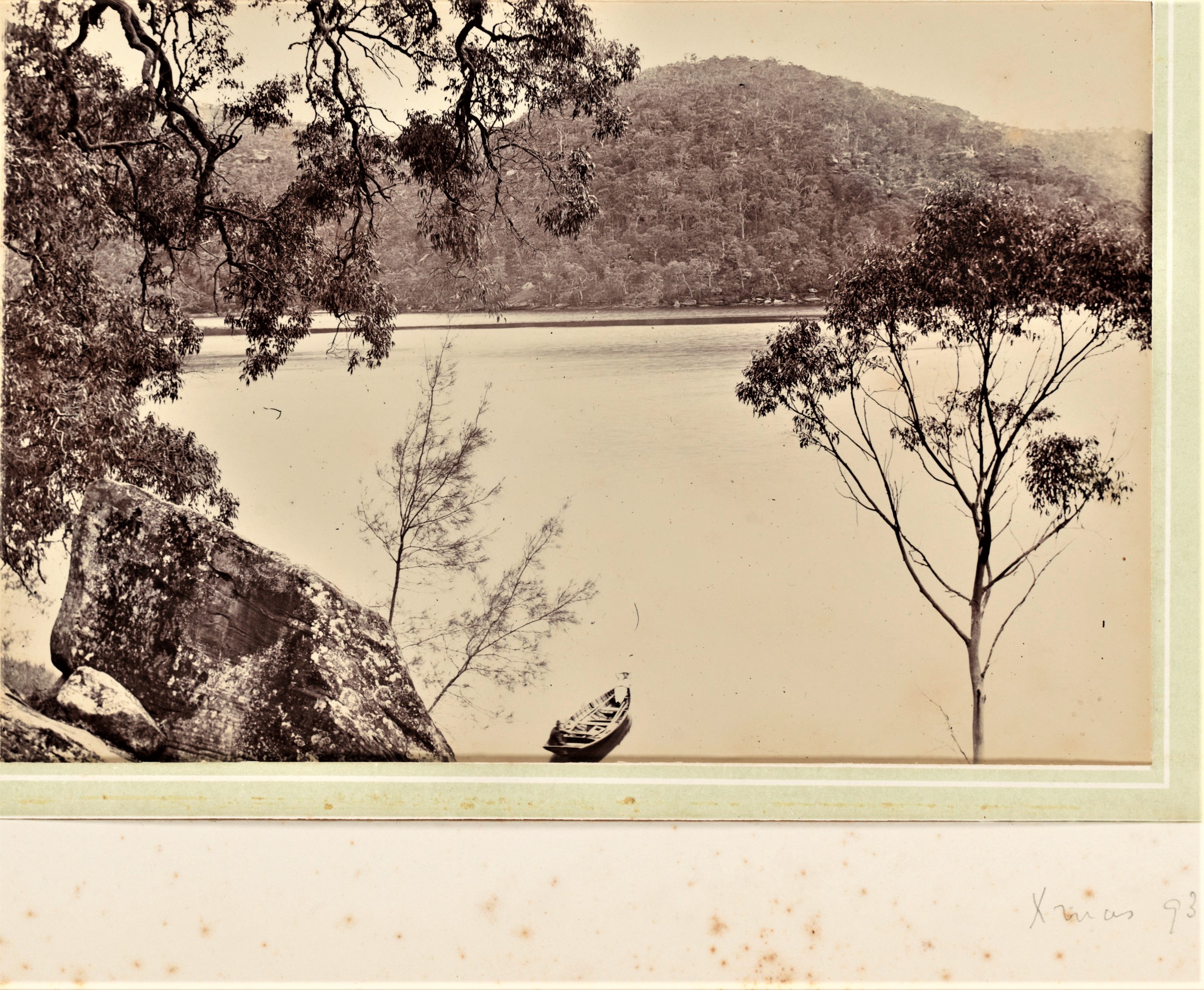
12. Xmas '93. [Two men reclining in rowing boat] - Item: c051620018
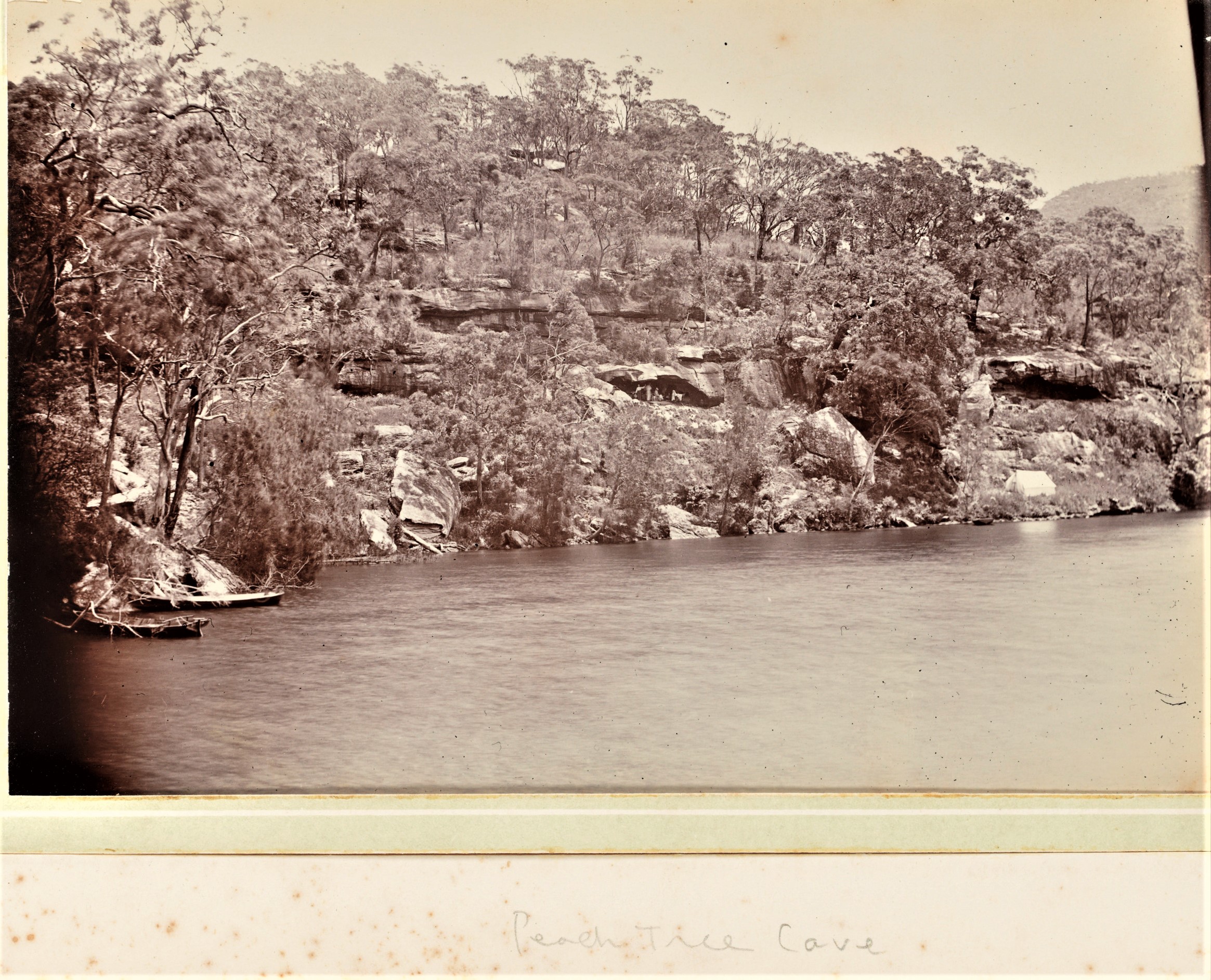
13. Peach Tree Cave - Item: c051620019
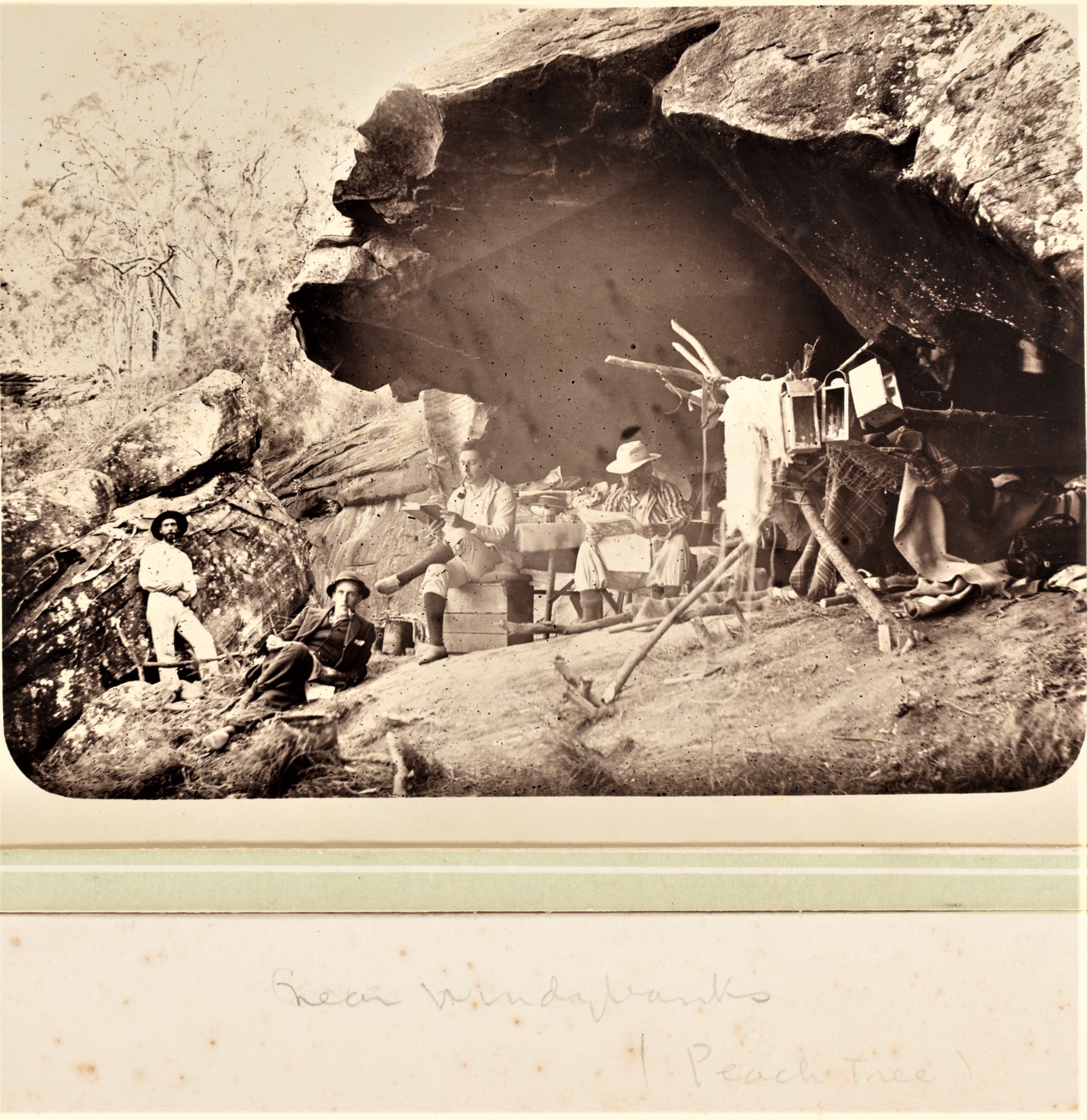
14. Near Windybanks (Peach Tree [Cave]) - Item: c051620020
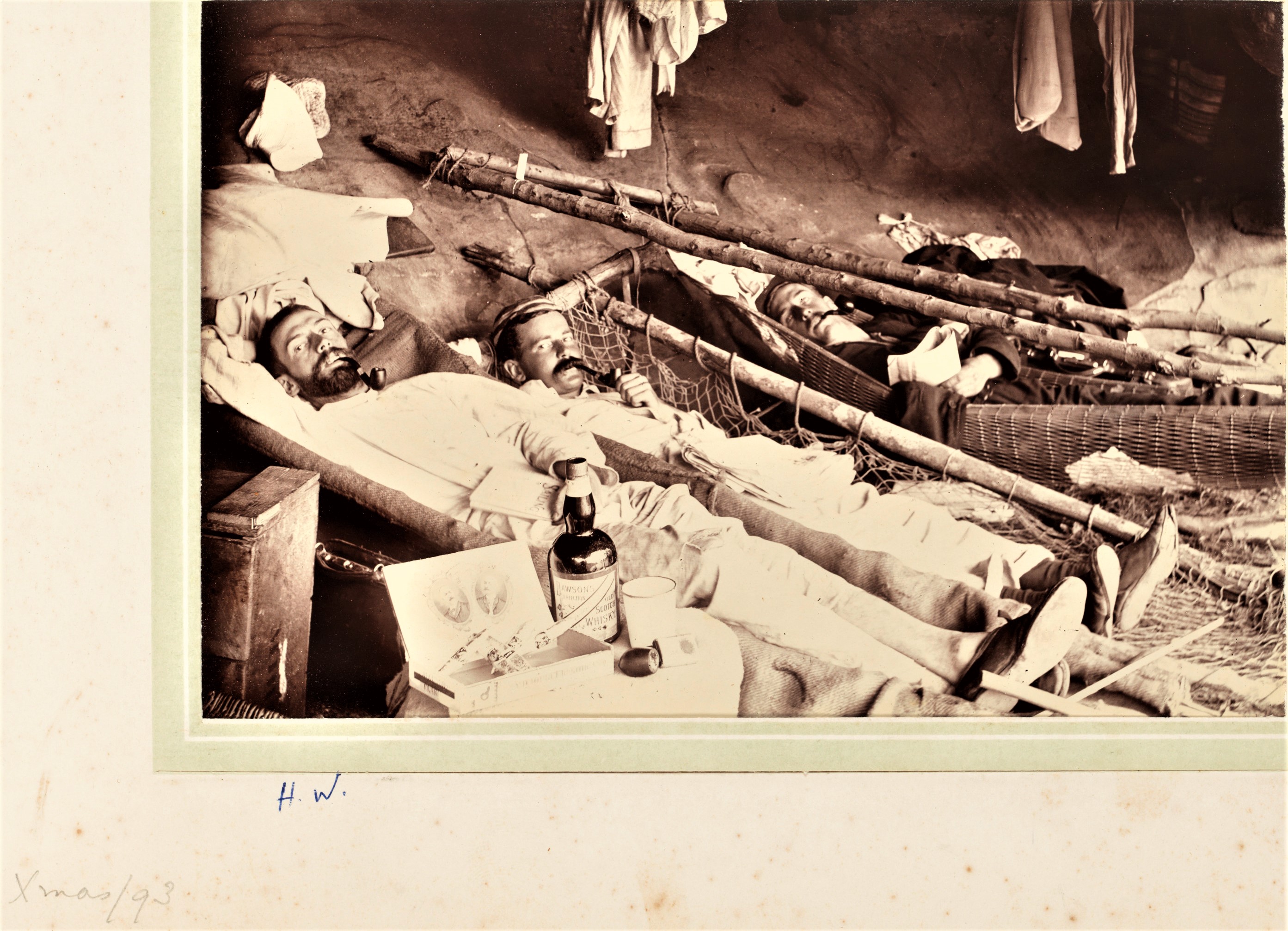
15. Xmas '93. H.W. [Harry Wolstenholme in cave lying in hammock smoking pipe with companions] - Item: c051620021
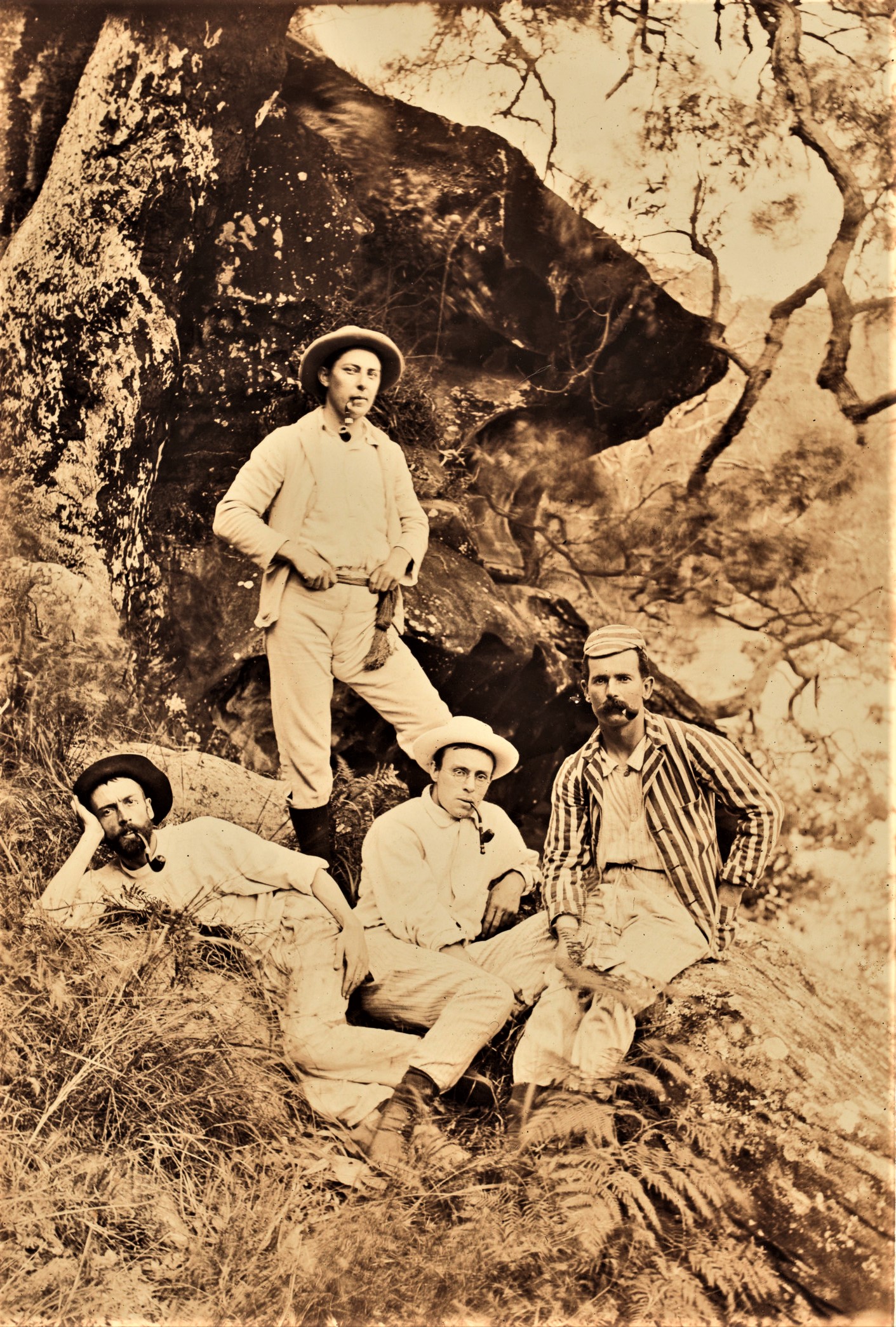
16. [Four men posing in bush, Harry Wolstenholme far left] - Item: c051620022

17. [Four men posing in bush, Harry Wolstenholme standing] - Item: c051620023
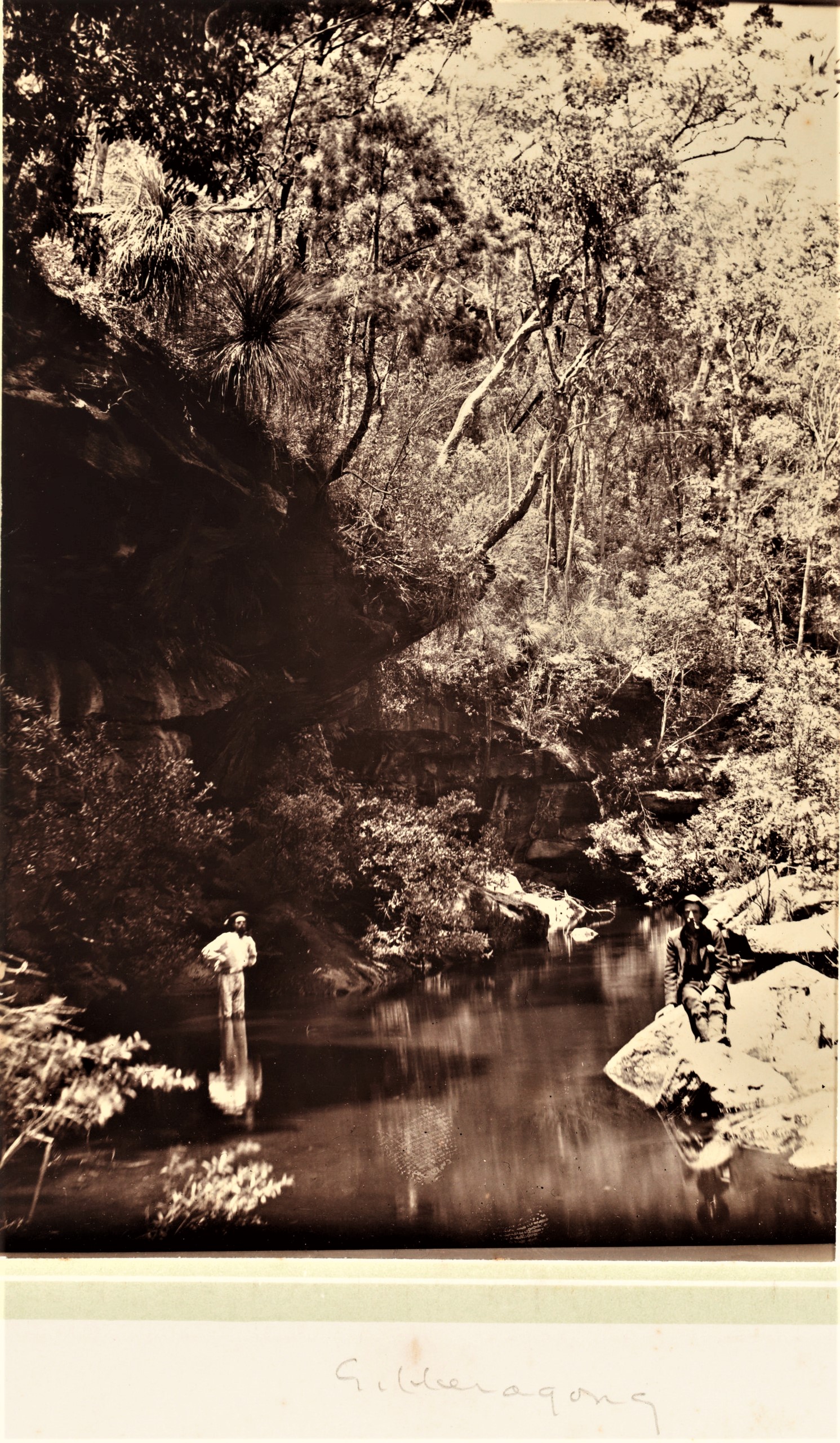
20. Gibberagong - Item: c051620026
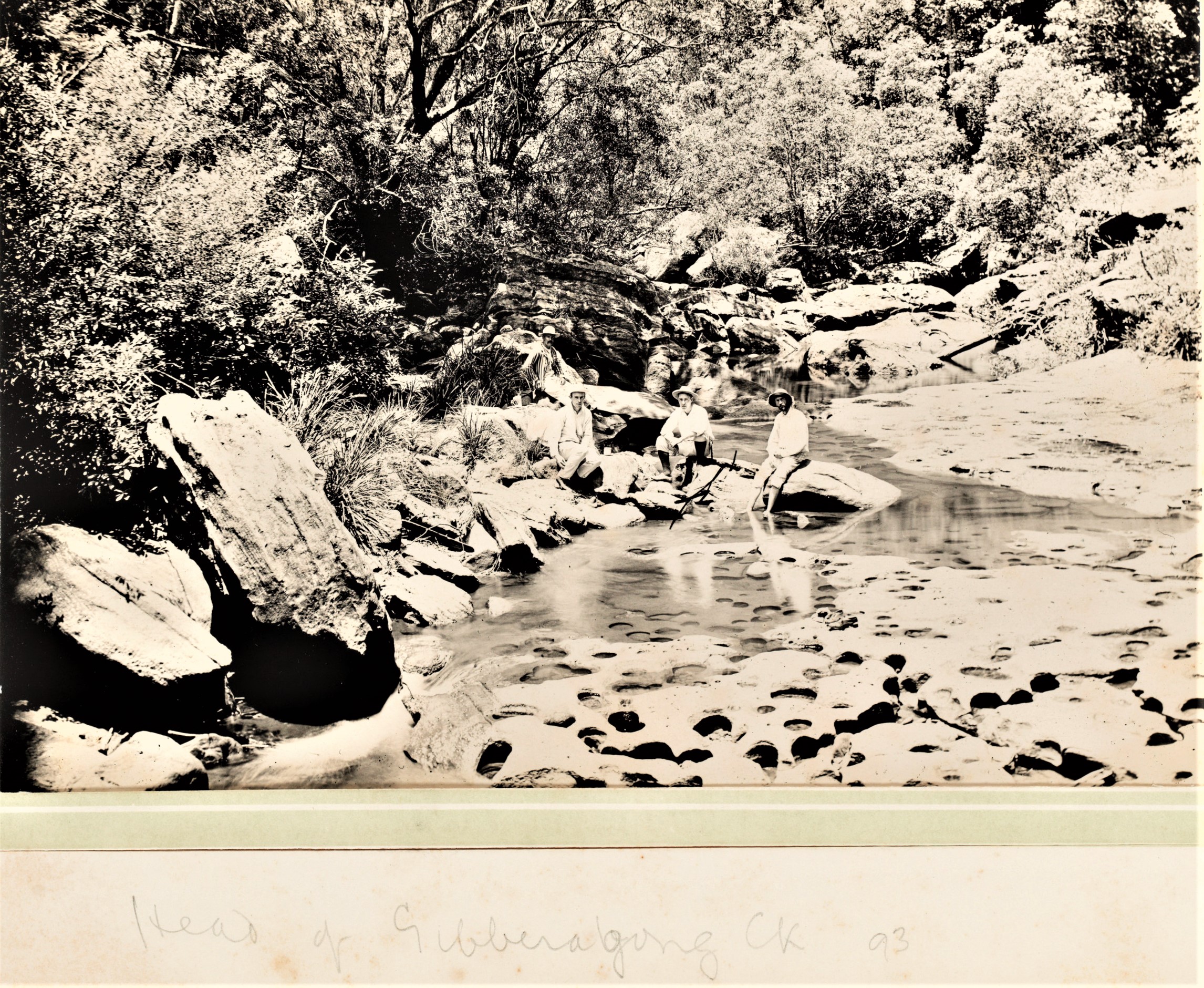
22. Gibberagong Ck 1893 [duplicate no.19] - Item: c051620028
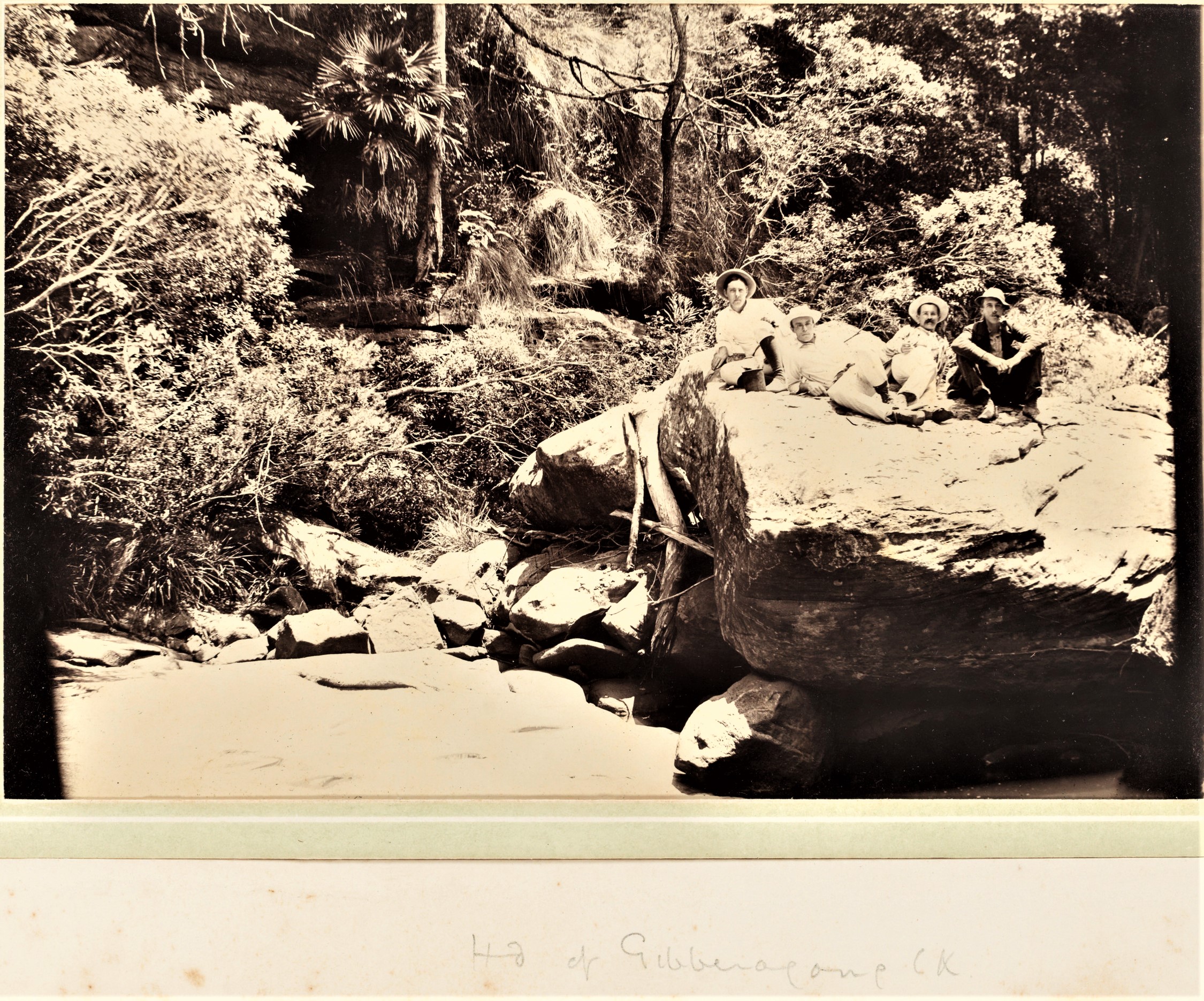
23. Head of Gibberagong Ck - Item: c051620031
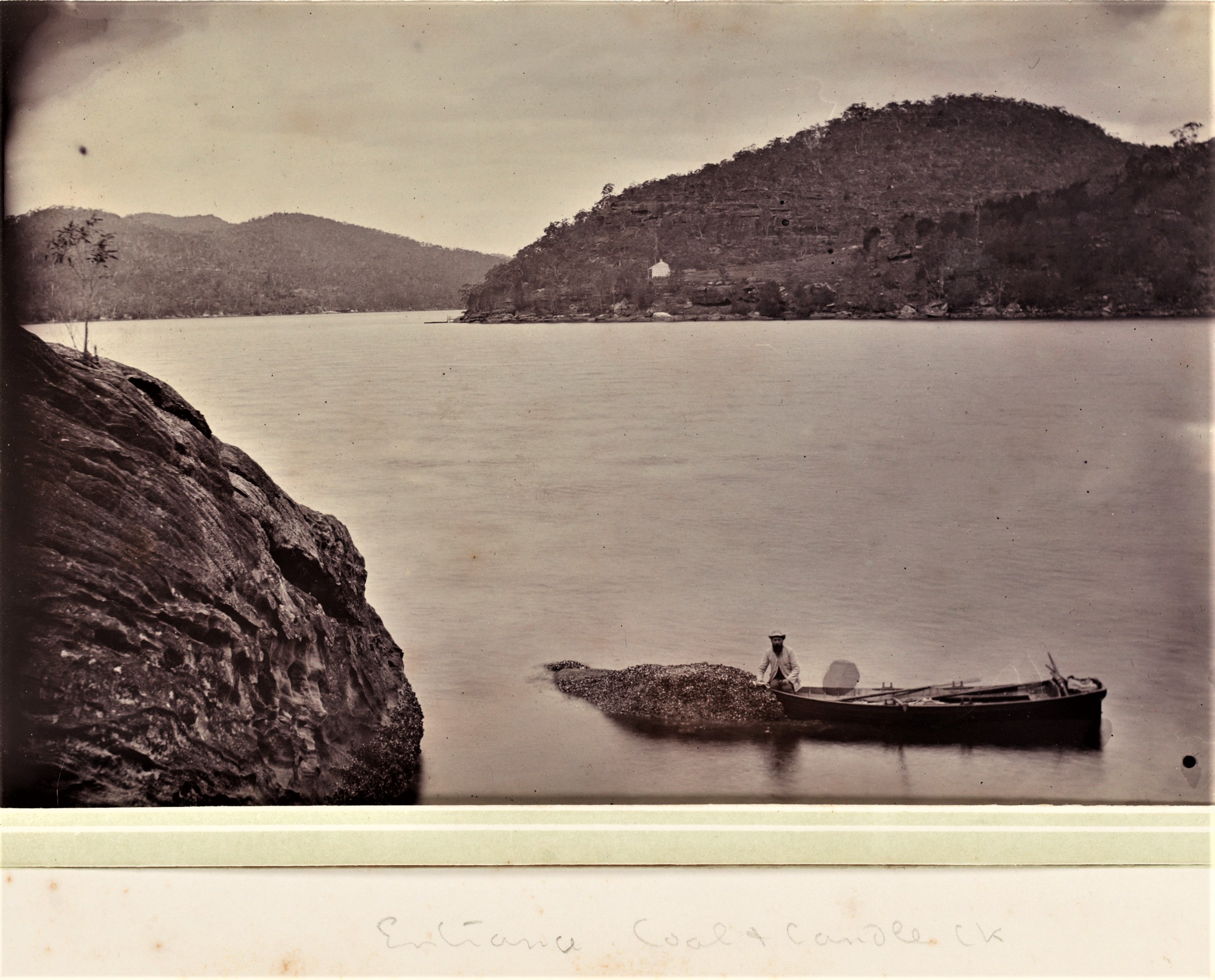
24. Entrance Coal and Candle Creek - Item: c051620032
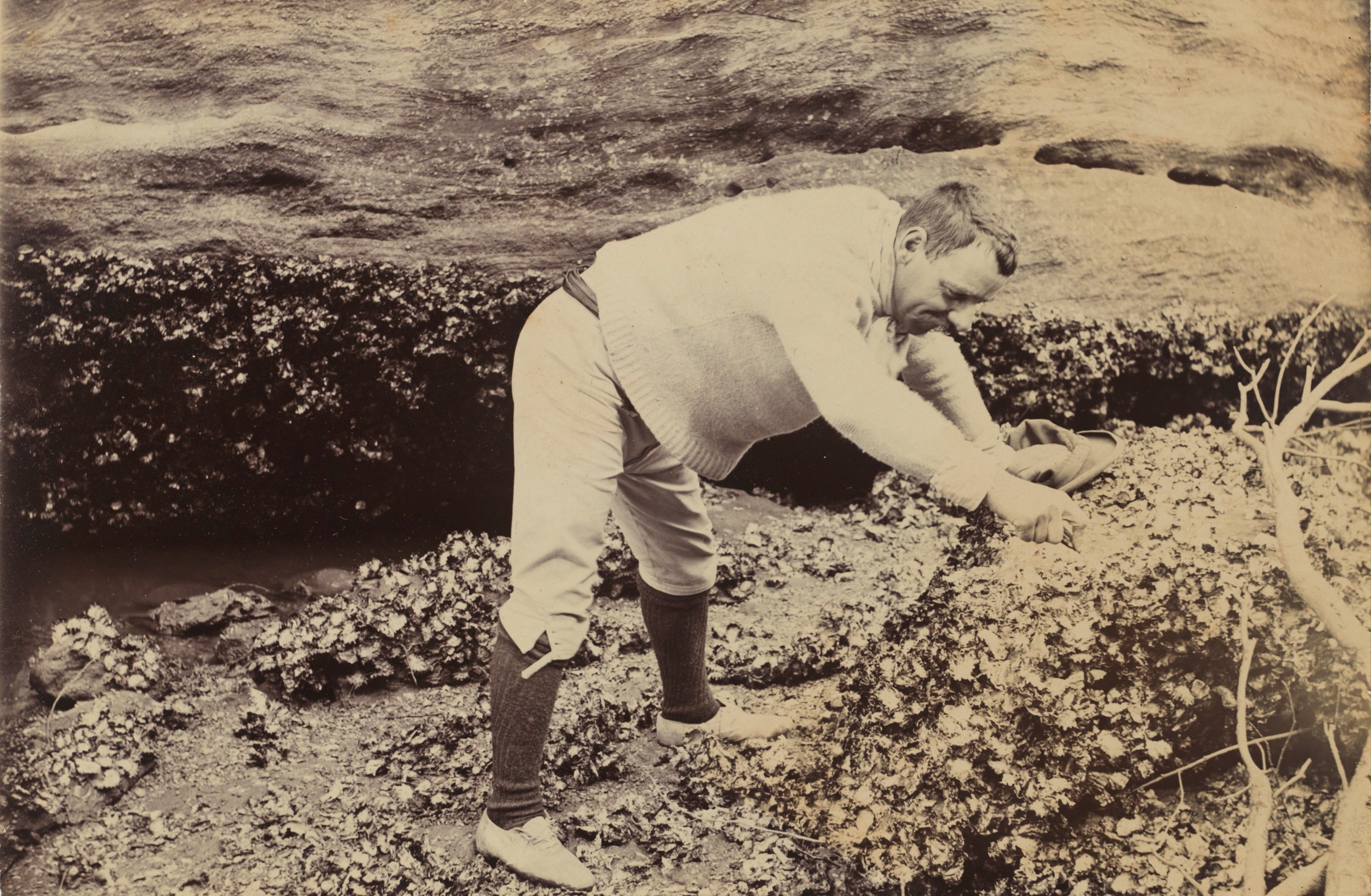
25. [Man prising at rock covered in oysters] - Item: c051620033
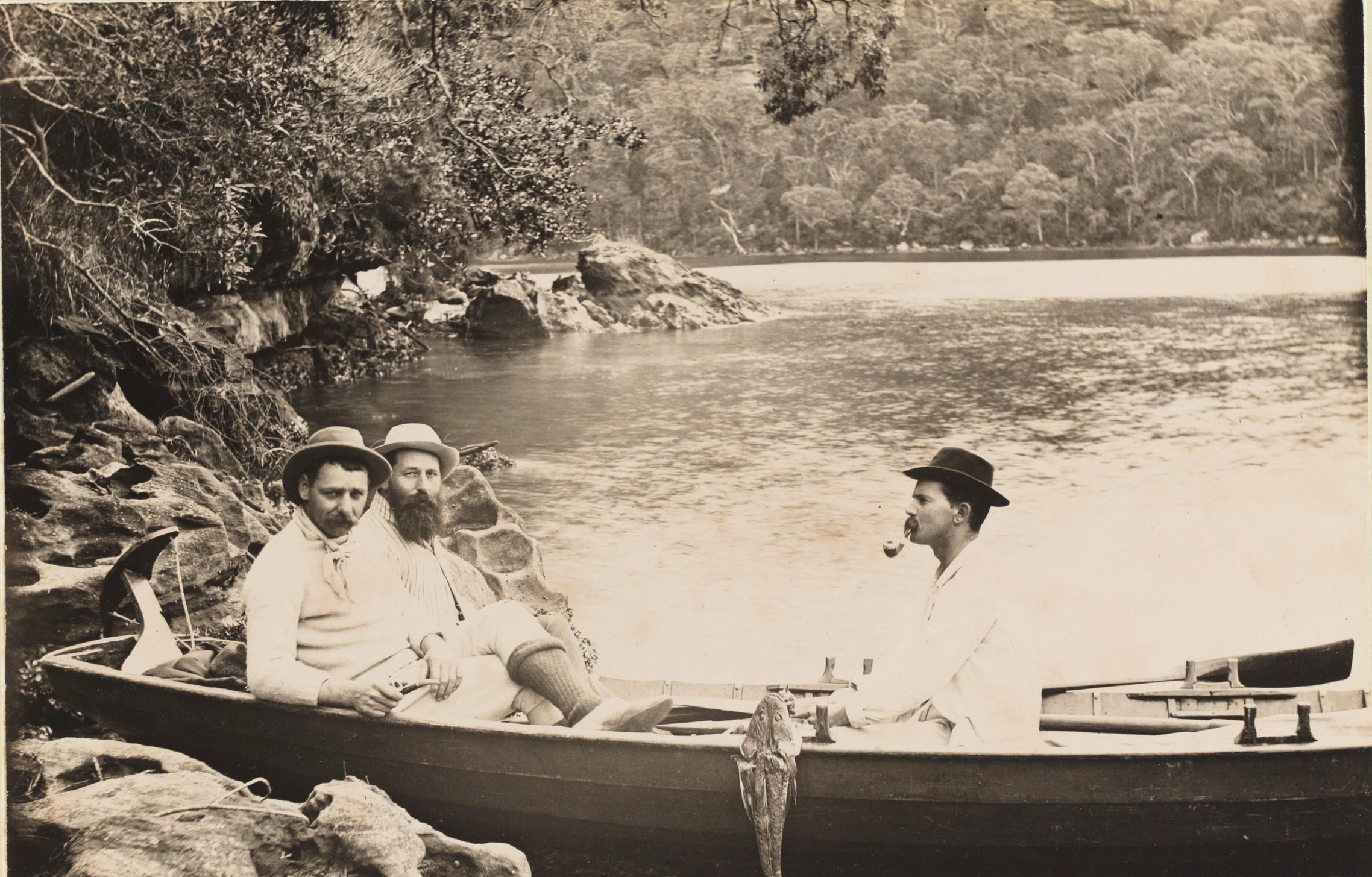
26. [Three men in boat, with flathead] - Item: c051620034
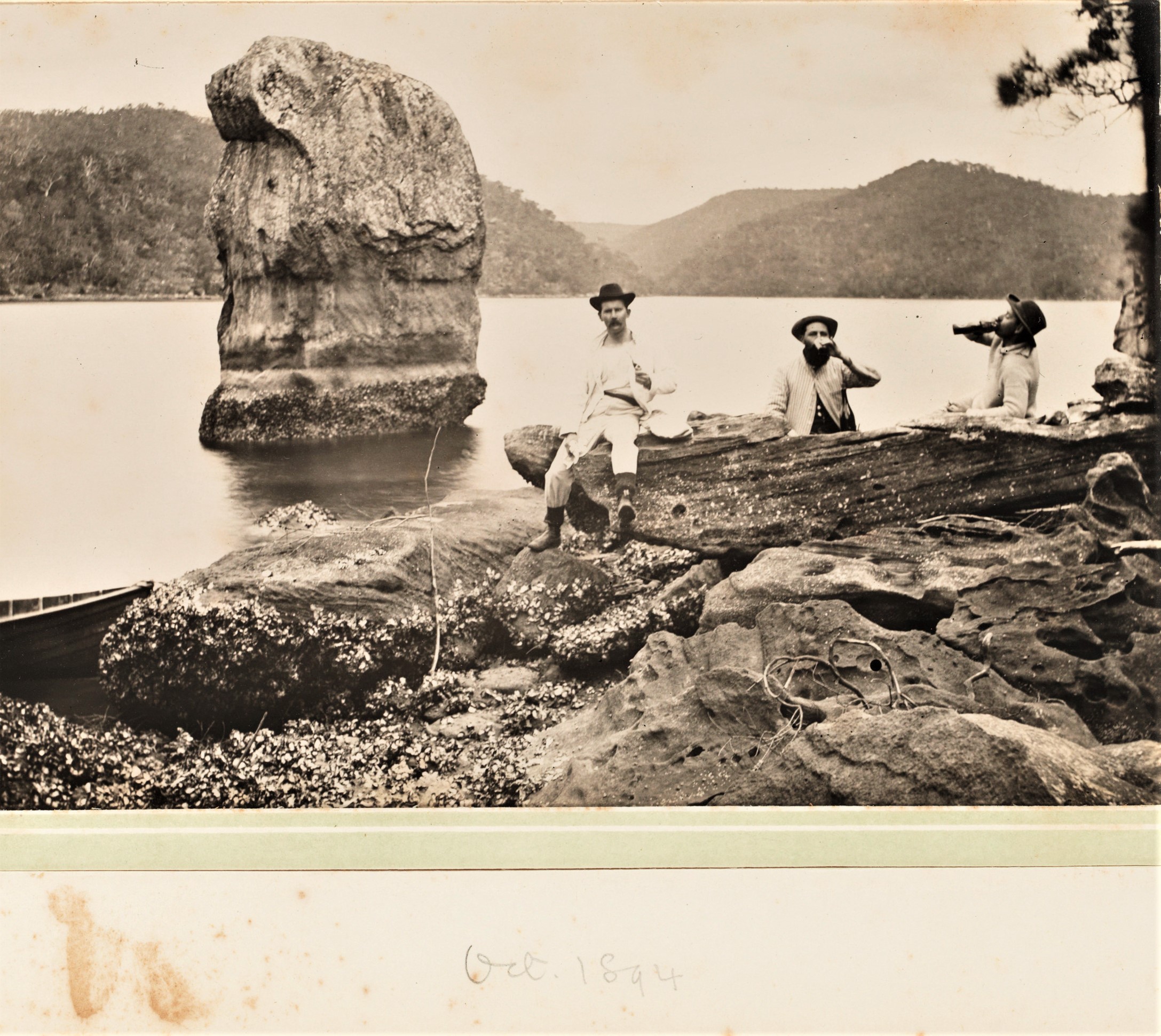
27. Oct. 1894 [men drinking on rocks, at oyster bed, near The Looking Glass Rock] - Item: c051620035
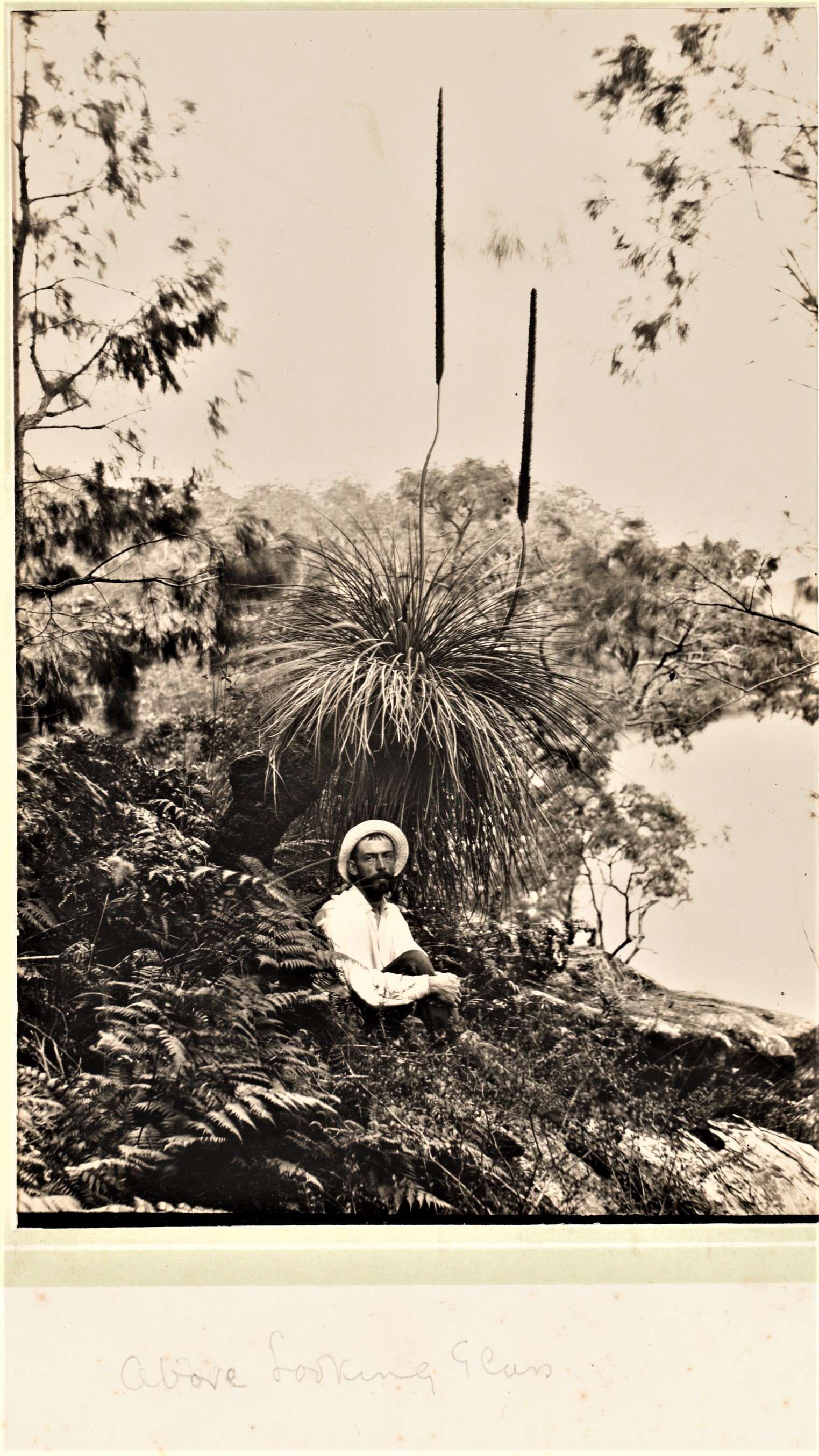
28. Above Looking Glass [Bay. Harry Wolstenholme with xanthorrhoea] - Item: c051620036
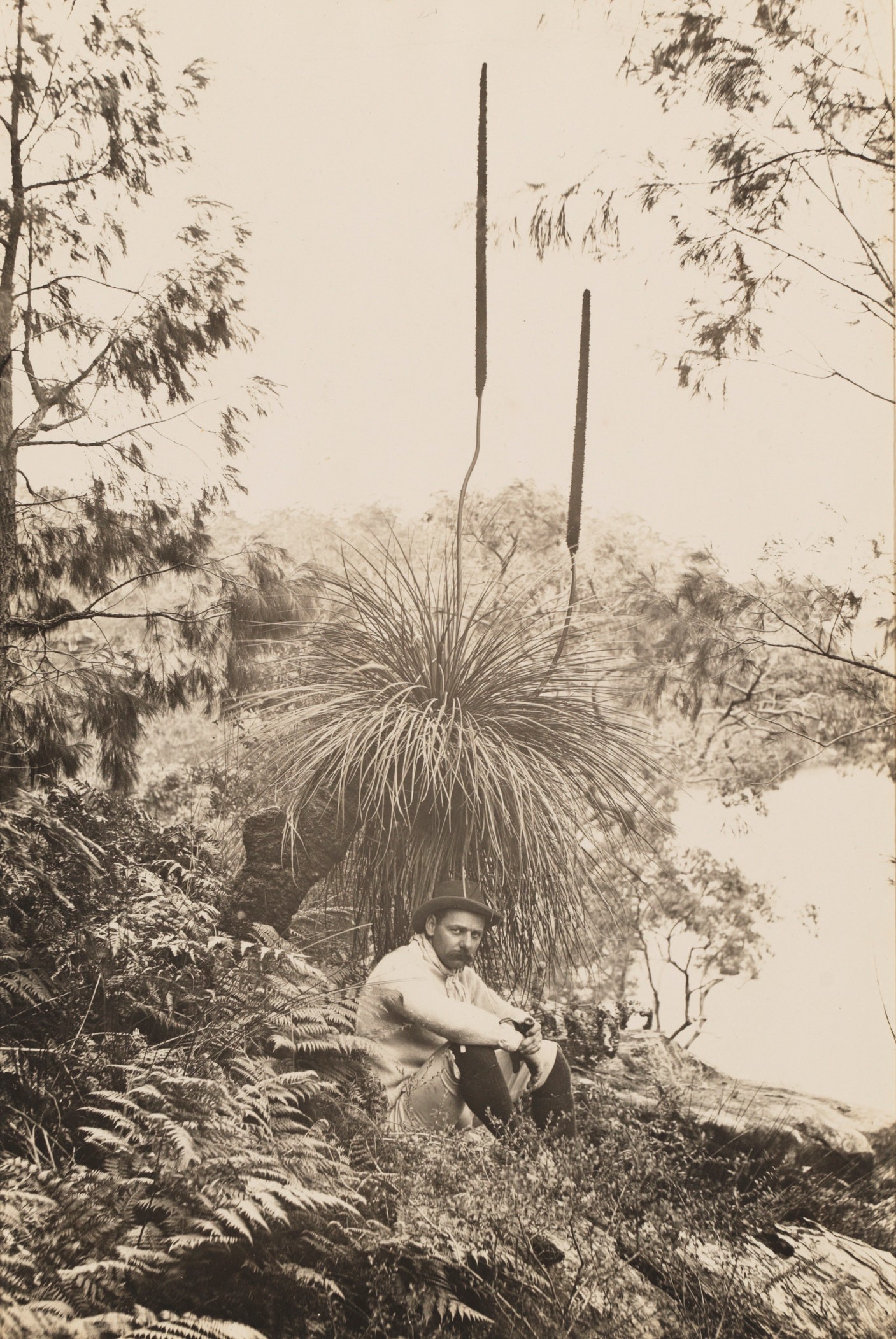
29. [Man, sitting by xanthorrhoea, Looking Glass Bay] - Item: c051620037
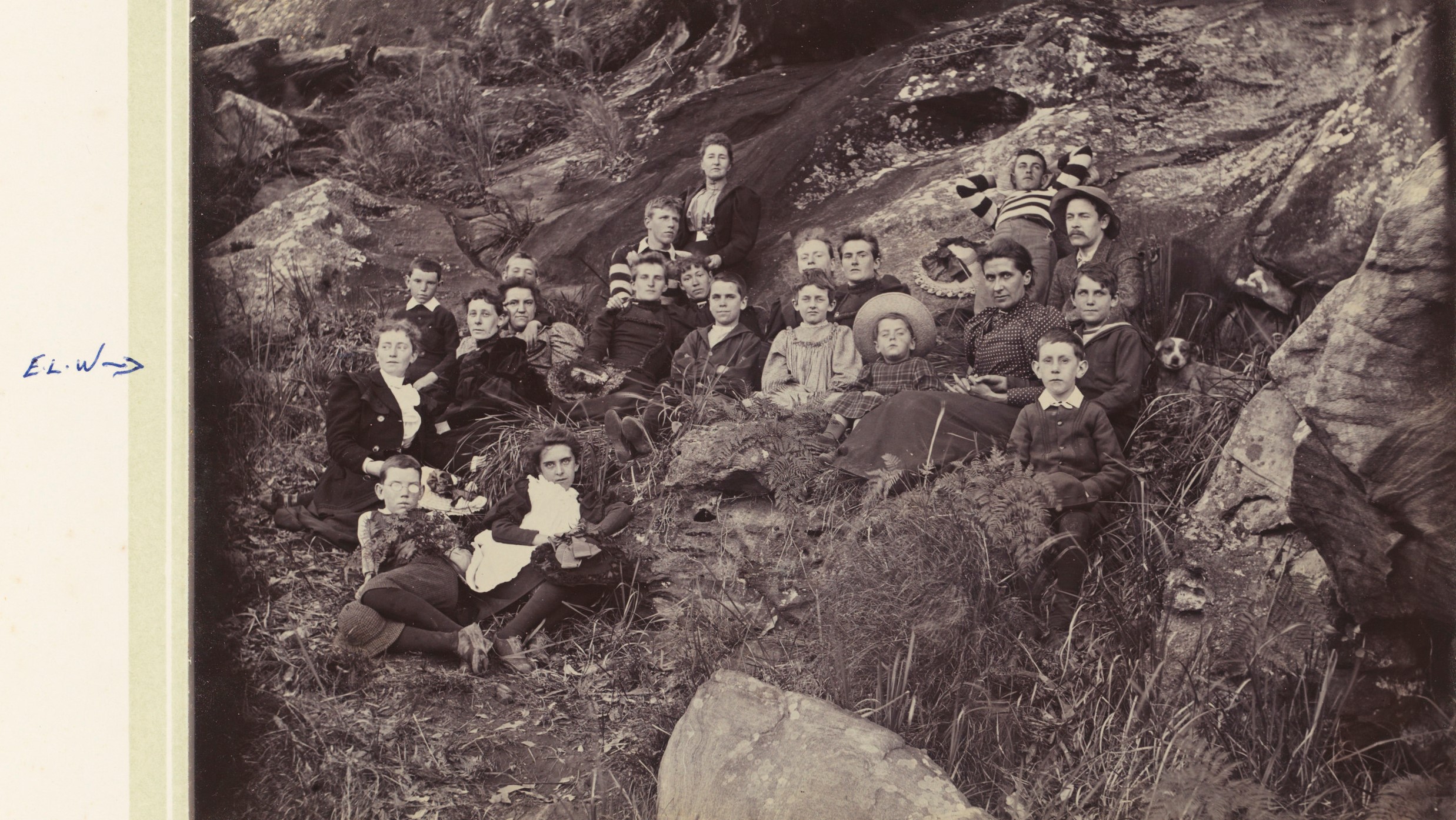
30. E.L.W. - Item: c051620039
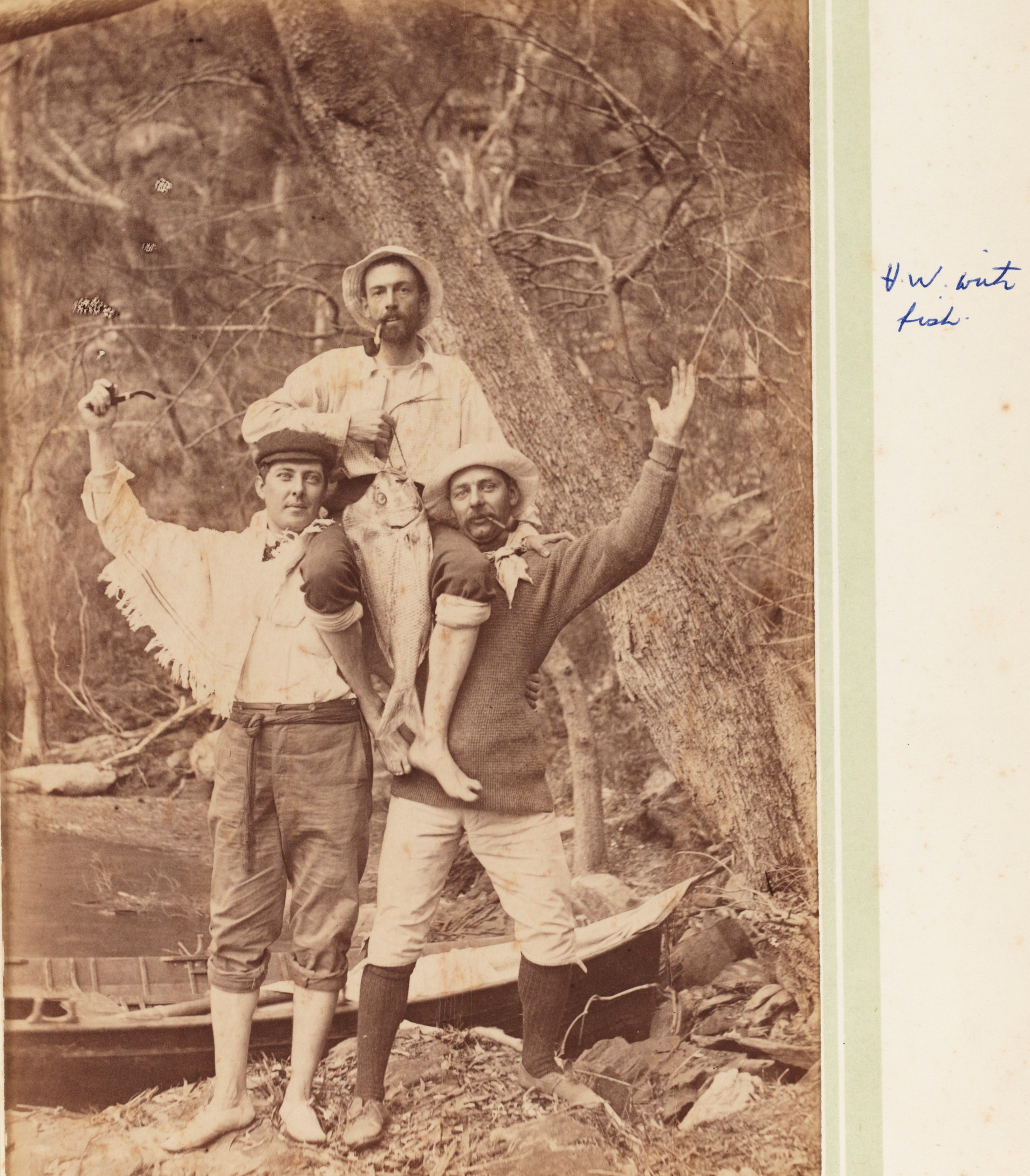
31. H.W. [Harry Wolstenholme] with fish - Item: c051620040
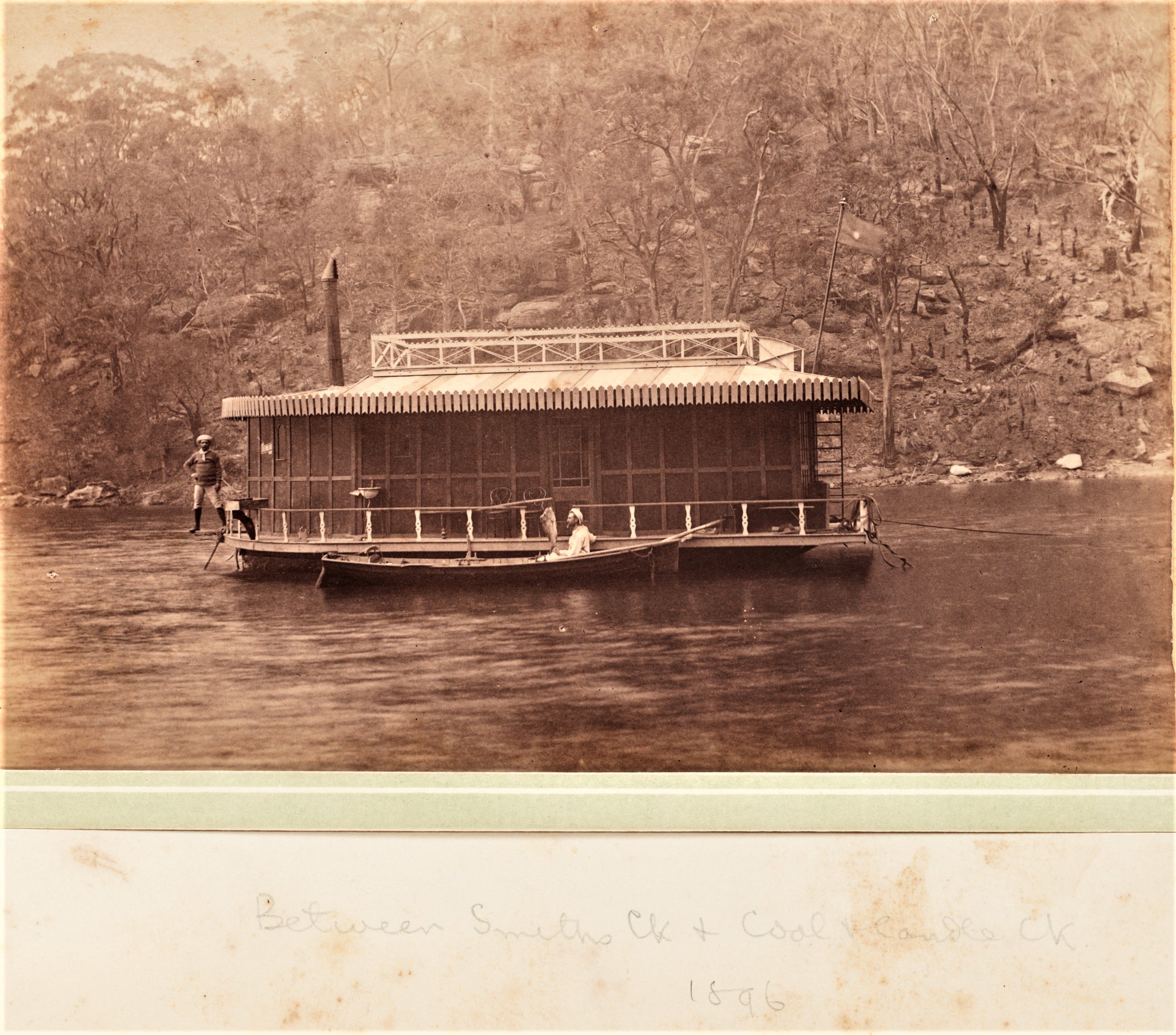
32. Between Smiths Ck and Coal and Candle Ck 1896 - Item: c051620041
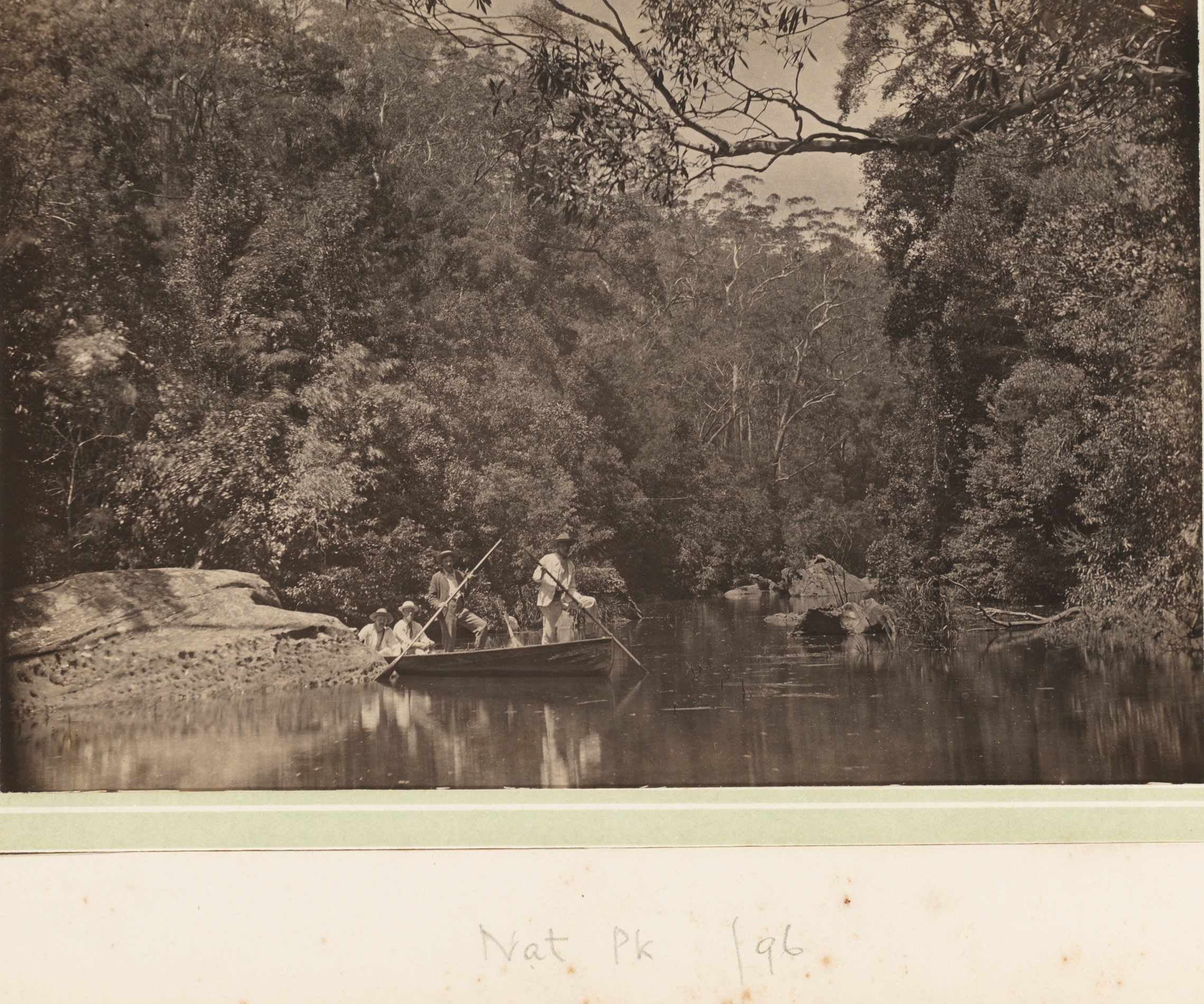
33. Nat. Pk '96 - Item: c051620042
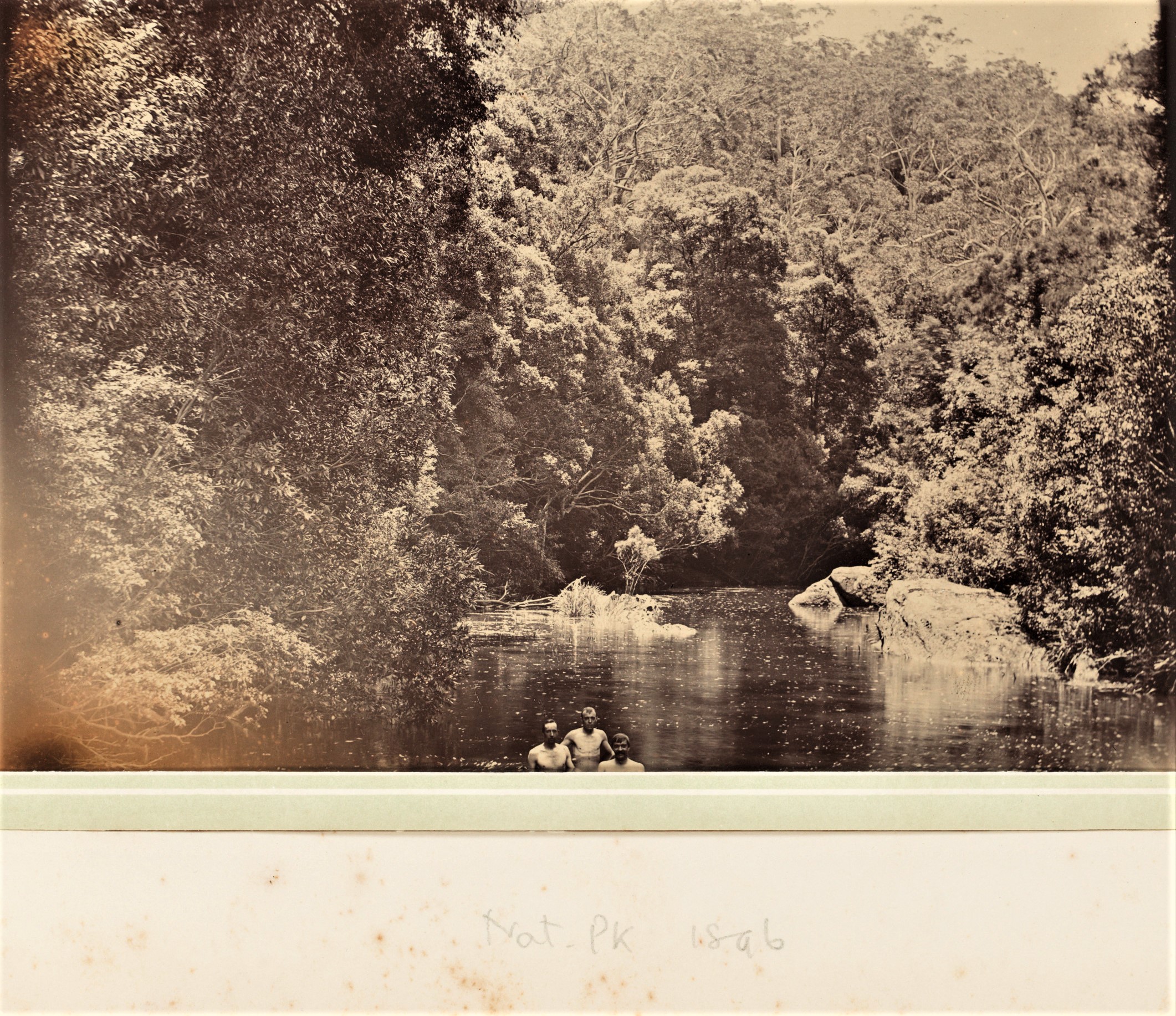
34. Nat. Pk 1896 [three men swimming in river] - Item: c051620043
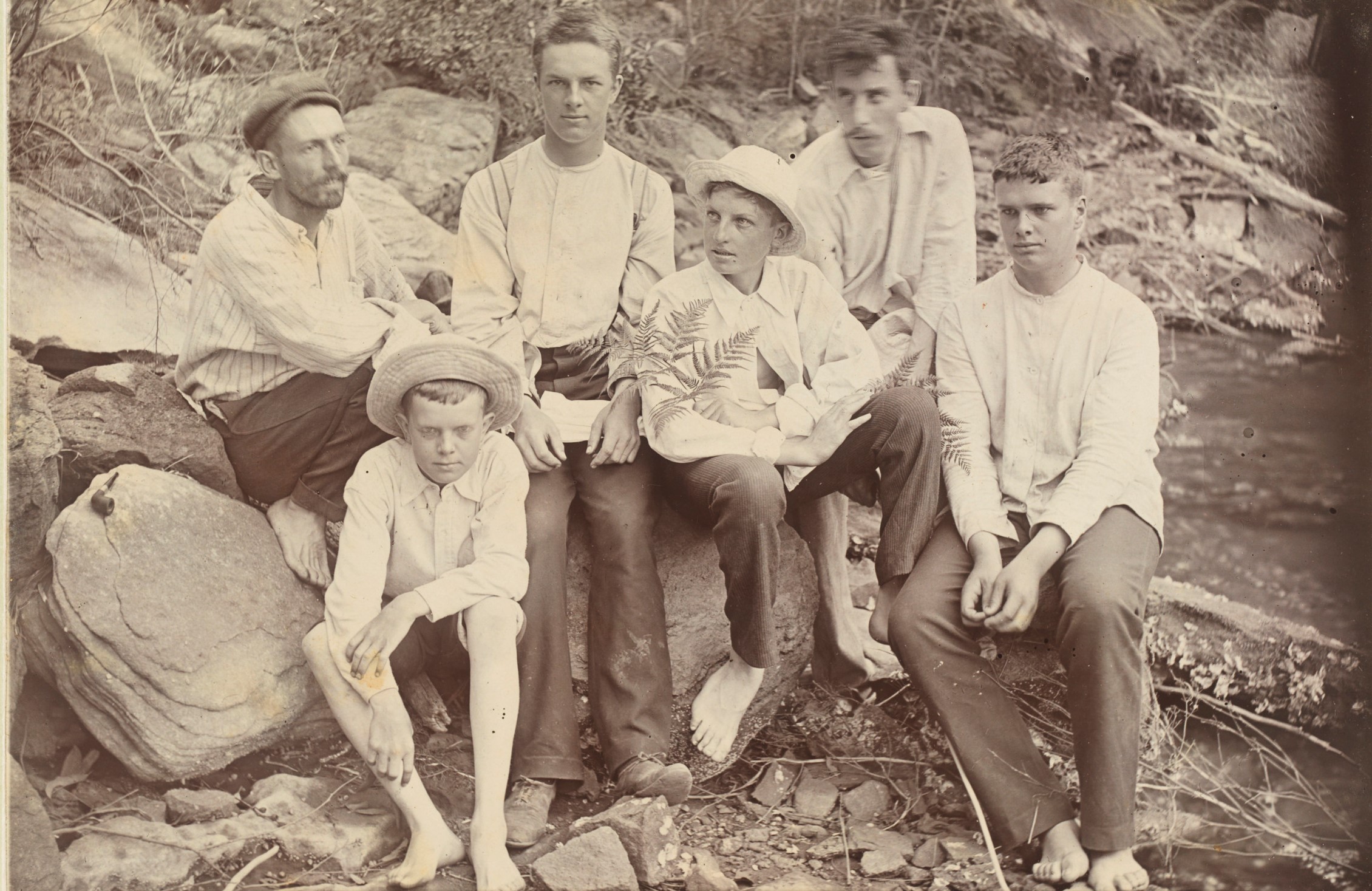
35. [Three men and four boys sitting on rock posing for photograph] - Item: c051620044
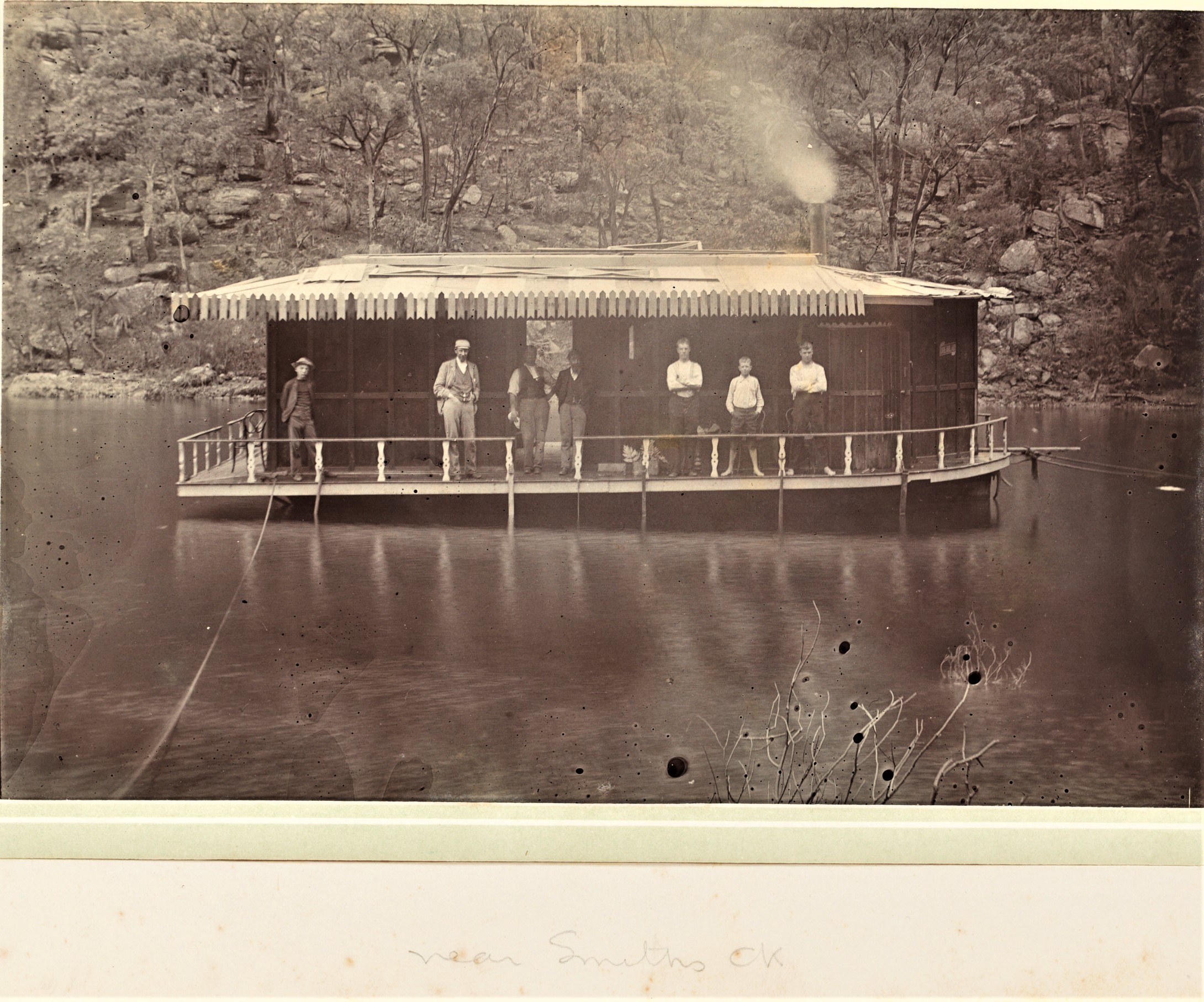
36. Near Smiths Creek [men standing on deck of houseboat] - Item: c051620045
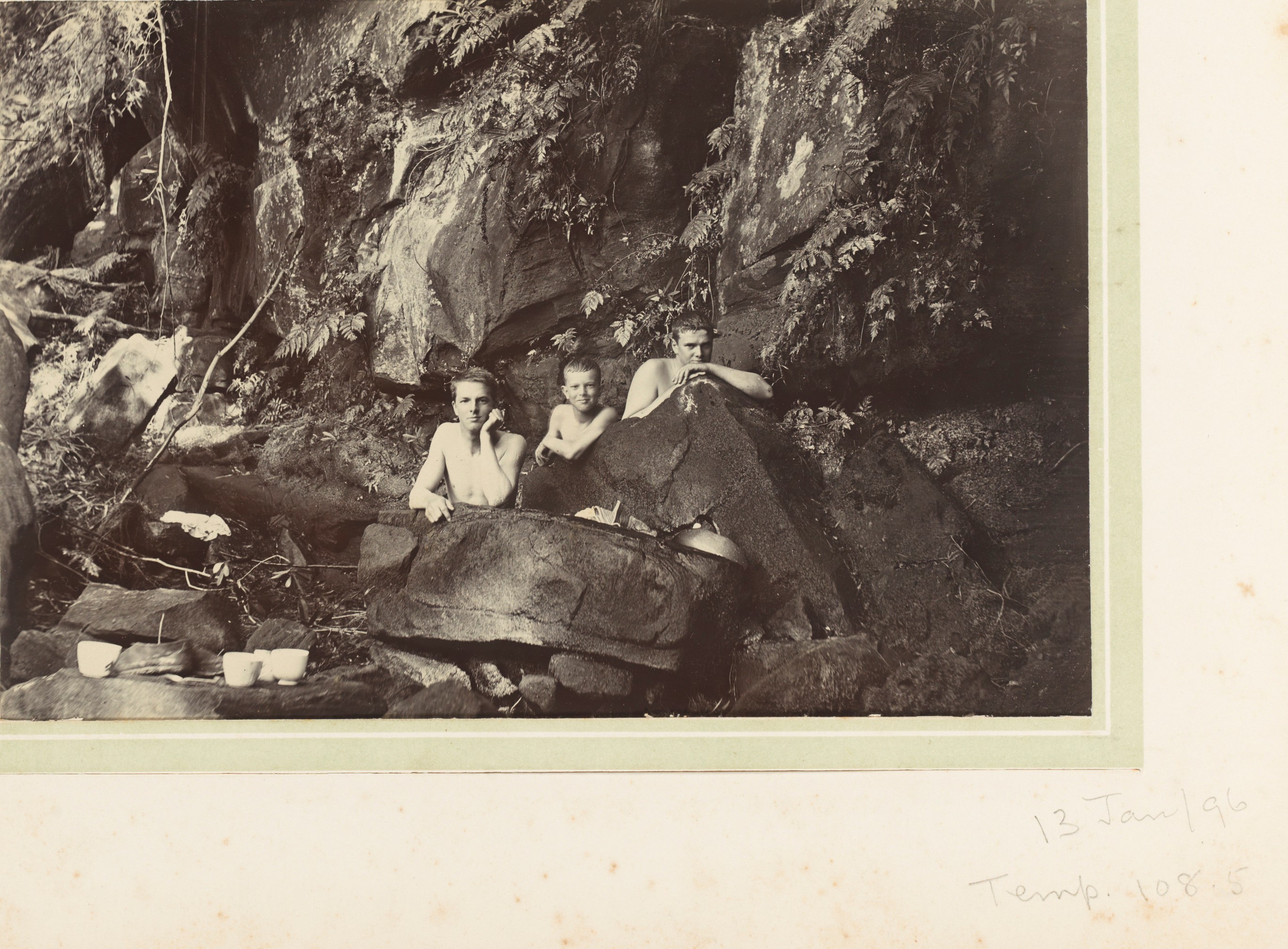
37. 13 Jan. '96. Temp 108.5 [boys swimming] - Item: c051620046
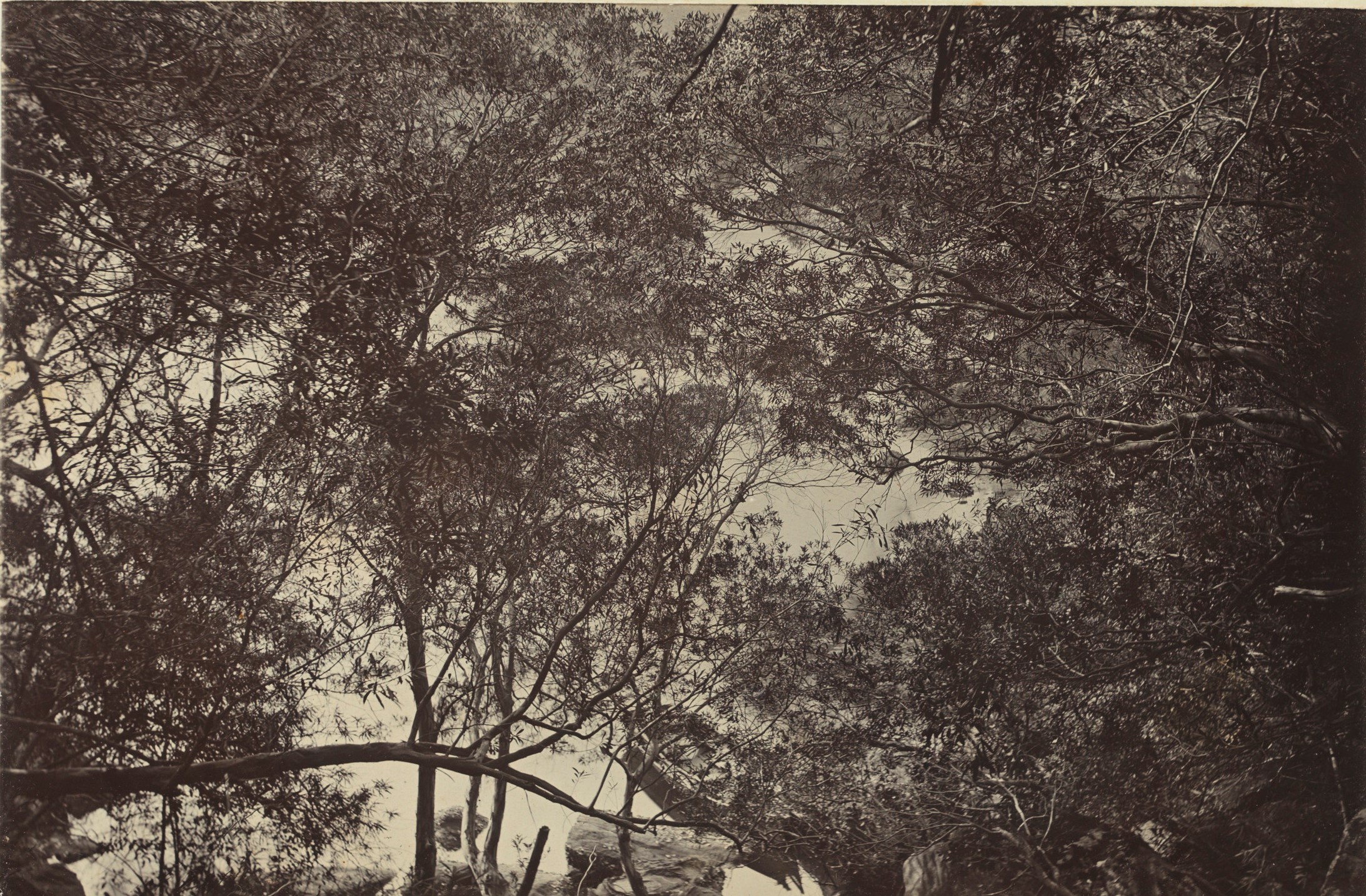
38. [Worm's-eye view of foliage] - Item: c051620047
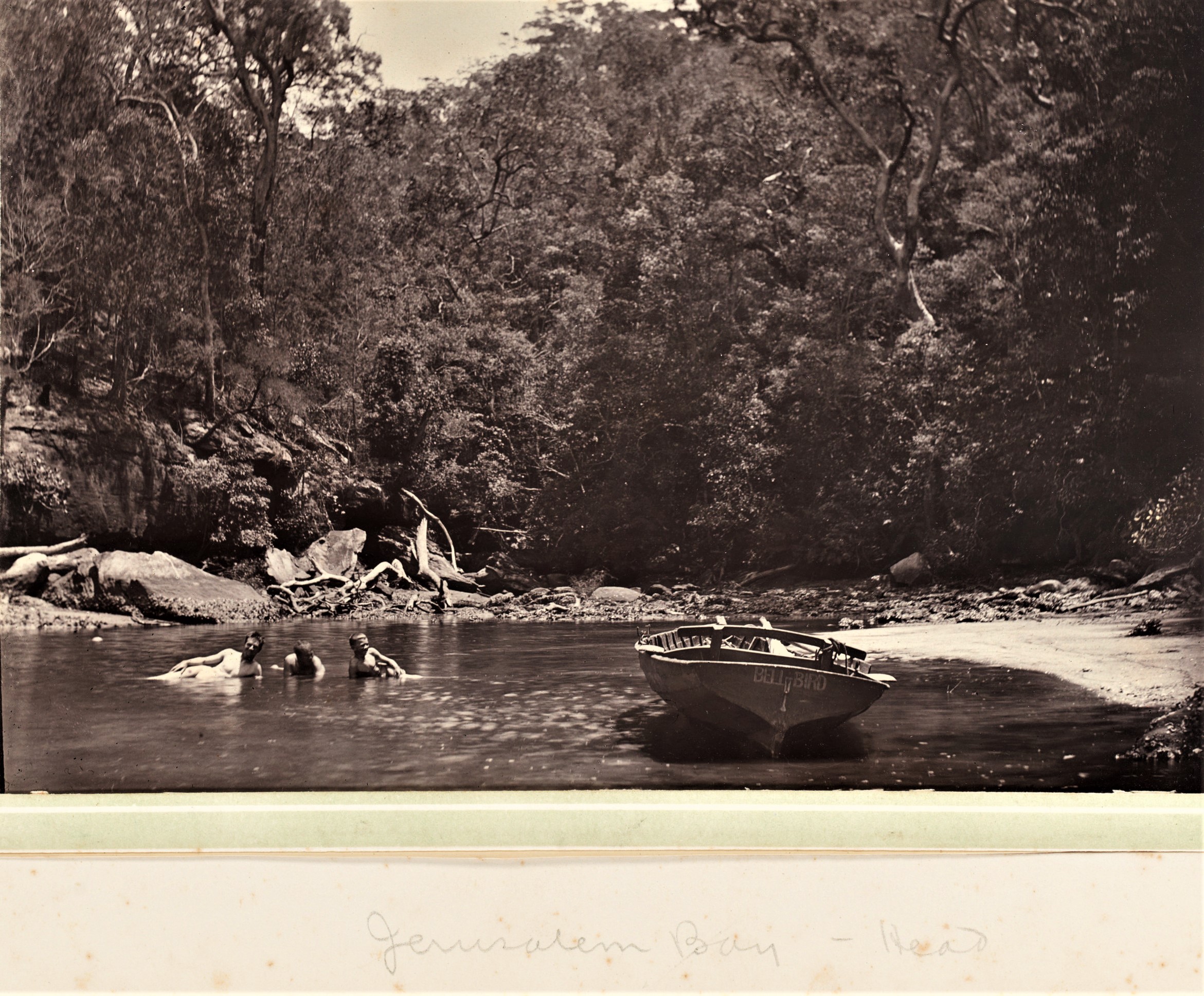
39. Jerusalem Bay - head [man and two boys bathing, with boat 'Bellbird'] - Item: c051620048
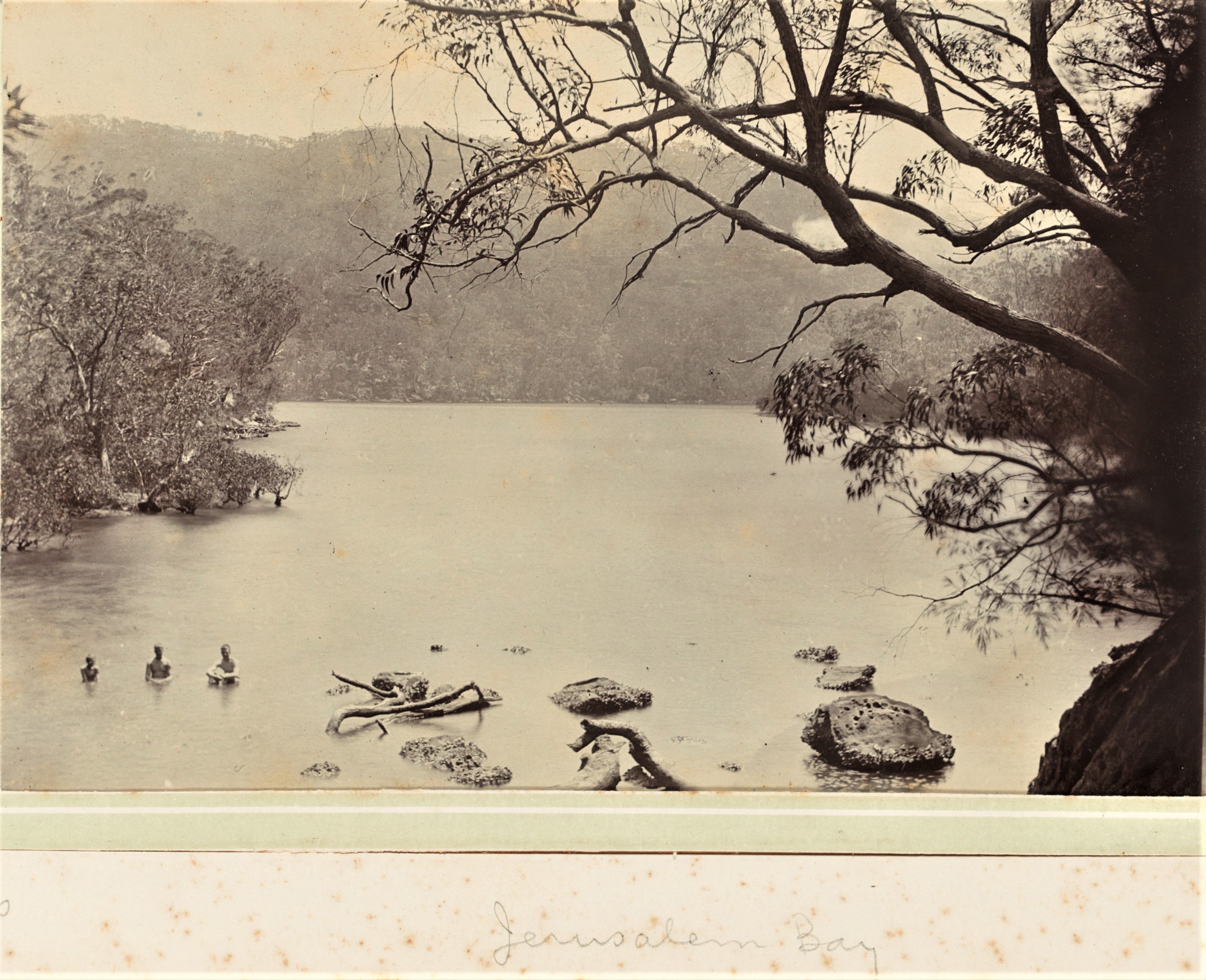
40. Jan '96 Jerusalem Bay - Item: c051620049
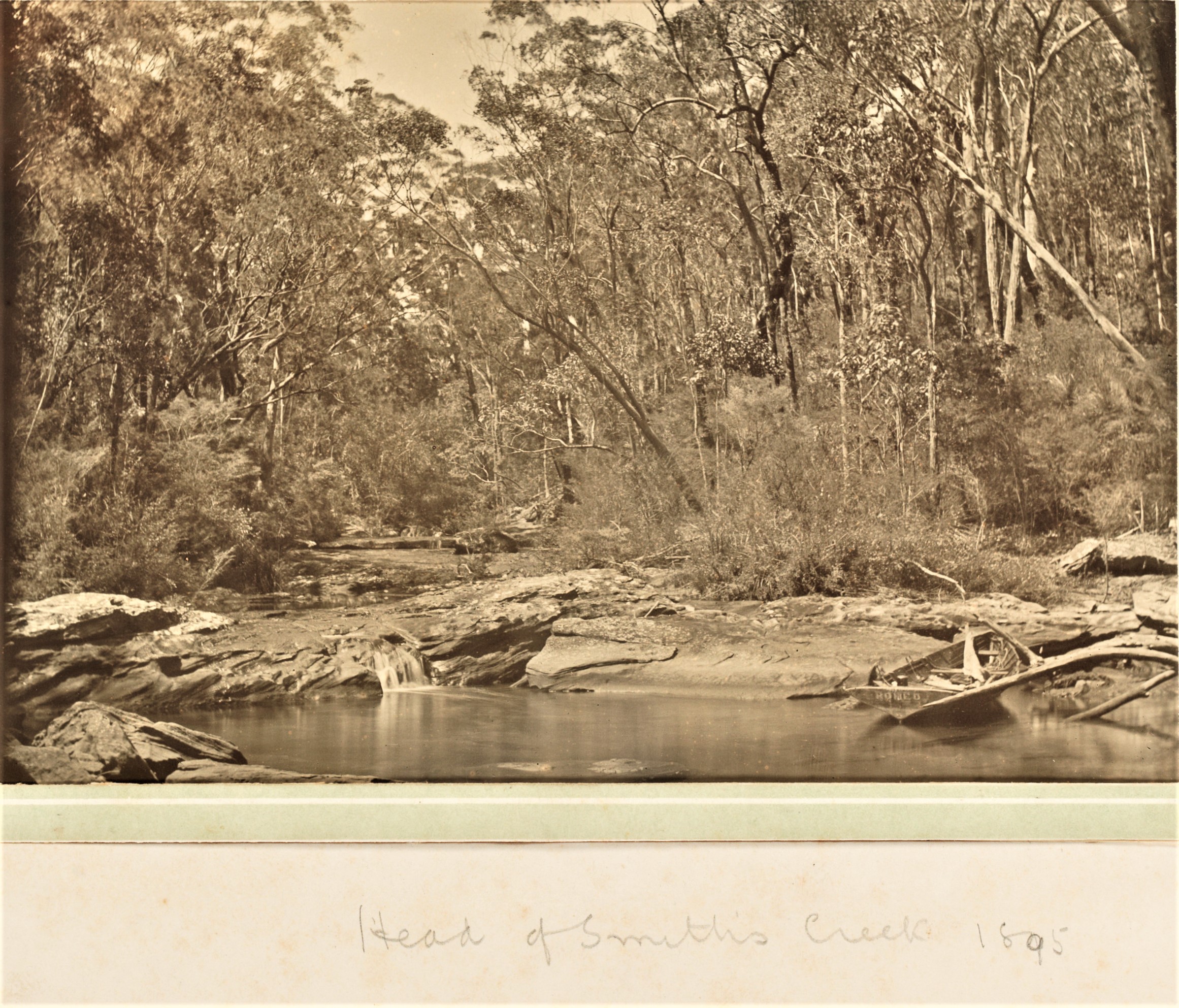
41. Head of Smiths Creek 1895 - Item: c051620050
COWAN CREEK. The beautiful Cowan Creek is full of picnic, house-boat, and camping parties. The many caves along the river have been great attractions When the Government fixes up those caves with floors fireplaces and c. , they will be a great boon to holidaymakers. COWAN CREEK. (1898, December 27). The Sydney Morning Herald (NSW : 1842 - 1954), p. 5. Retrieved from http://nla.gov.au/nla.news-article14192488
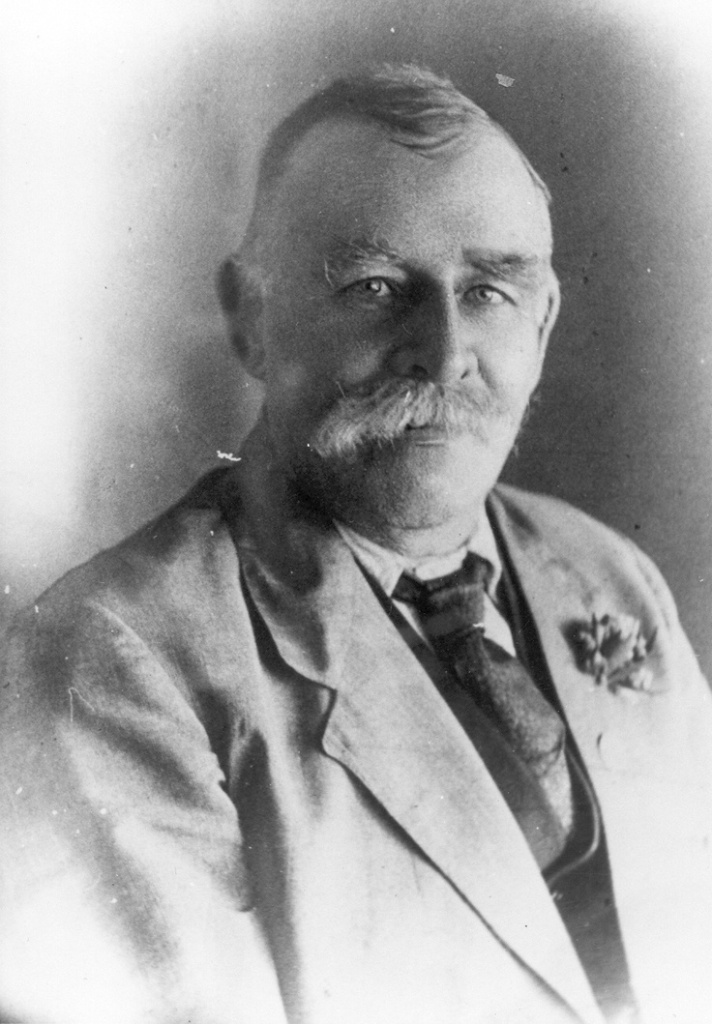 E. WINDYBANK, PIONEER OF COWAN
E. WINDYBANK, PIONEER OF COWAN
Died last week at Patonga Beach, the pioneer of what is stupidly called Cowan Creek. The word 'creek’ suggests to most of us a small water-course, across which one might throw a biscuit, whereas, it is m reality a series of very beautiful sounds,. 50 to 60 feet deep, with no shoals or sandbanks. Each sound is girt about with everlasting hills, wooded to the water's edge. The Windybanks have now numerous cottages and houseboats, but 45 years ago, Windybank built his first boat, carrying the timber on his back across the mountains. He amused himself, between his rowing to Hawkesbury on a raft, buying old steamers and dismantling them —even to the boilers, unaided — by writing doggerel verse, and painting pictures —hung on the line of his own Royal Academy. A houseboat and a motor launch on the Cowan Sounds provide an ideal holiday — four miles from Broken Bay, five from Hawkesbury, and three from Bobbin Head. E. WINDYBANK, PIONEER OF COWAN. (1928, February 19).Sunday Times (Sydney, NSW : 1895 - 1930), p. 47. Retrieved from http://nla.gov.au/nla.news-article122807989
FISHING NOTES (By 'GLAUCUS.')
I HAVE just had an interesting stay at Cowan Creek on one of the houseboats in that popular resort, Mr. S. Baldock having kindly placed his neat little boat at my disposal. Ned Windybank also assisted to make the trip a pleasant one with his kindly hospitality, so while the city folk were wondering what kind of winter was coming on top of the coastal gales, I was putting In a quiet, healthful stay in the sheltered creek. It is strange that so few people know anything about life on a houseboat. It is such a free and easy life that it should specially appeal to Australians. It is far preferable to camping in a tent, and one can safely take children on to the roomy boats. Mr. Baldock's house on the water is at Coal and Candle Bay, near one of the best grounds for schnapper in the whole of the deep water of Cowan. It has been well planned and constructed, and is very suitable for a small party of half a dozen men. It represents a good many hours of labor by a busy man In his spare time, and when completely finished will be as comfortable a temporary home as one could wish for. It is small, but then it has not been built for a large crowd, and the men who use it are all fond of fishing, and really only require the place for the night. Ned Windybank's fine Fairyland is near, and there is a plentiful supply of water in the creek a hundred yards away. I only succeeded in raising one of the Cowan schnapper, a five pounder, that provided a tasty meal for the family, but there were plenty of small fish in the place. A large skate was the first fish to be grilled. The flaps of a twelve pounder made two excellent meals. The leather-Jackets are very plentiful and are of all colors. They are as razor toothed as ever. The skate tasted like tender lobster, and was a decided success. FISHING NOTES. (1903, June 3). Referee (Sydney, NSW : 1886 - 1939), p. 6. Retrieved from http://nla.gov.au/nla.news-article120664475
The following reports hall from Eastway's: —Mr. Bennett and family have secured the house-boat Dreamland at Cowan Creek for a few -weeks. Mr. Bennett reports 'the fish biting well- near Looking-glass Rock. Jewfish, flathead, large red and black bream keep thefamily well supplied In fish.' Mr. Bennett hails from Turramurra. Mr. Arthur Dunn (of Cowles.and Dunn) is just back from a trip to Terrigal. Mr. Dunn, out with his friend, Mr. Joe Painter, secured a fine lot of large flathead and squid. Mr. Dunn says that a lot of fish are being caught at Terrigal. Mr. Thorpe, of Strathfield, with a friend from the same suburb, journeyed to Woy Woy on Thursday, and put themselves in the hands of Walter Stewart. The large fisherman's basket of choice fish they brought back with them was worthy of Woy Woy s balmiest days. FISHING NOTES. (1906, February 17). Evening News (Sydney, NSW : 1869 - 1931), p. 3. Retrieved from http://nla.gov.au/nla.news-article114229225
IN KURING-GAI CHASE. ITS MANY ATTRACTIONS. FACILITIES FOR EXCURSIONISTS.
So numerous and diversified are the pleasure resorts which on every side of the metropolis allure those in quest of relaxation that it is not possible to place them in their order of merit. They are all comparatively close to the great centre of population, easy and cheap of access, they are all beautiful, and in their wonderful combination of sea and river and mountain range they above all are natural, with a nature that has not been defaced. Their distinctive character is perhaps that they cover areas which invite no settlement, the soil for the most part is hungry and unsuitable for any culture; the timber is stunted and gnarled. One of the finest of these areas and one with the greatest of possibilities is undeniably Kuring-gai Chase. On the precincts of the metropolis its 33,000 rugged acres embrace all the gems of a National Park. Cut up by Cowan Creek, Pittwater, and other estuaries from Broken Bay, it has a water frontage of something over 60miles, while through its rolling tract there are numberless little streams, some tidal, others fresh, which nurture fern and palm in sheltered gullies, and break with miniature falls the reigning silence. Boating, fishing, driving, and walking are at the choice of the visitor, while over the whole area the scenery though not on a scale of grandeur, charms with its quiet but varied beauty. For years its offerings to the public were neglected on account of its inaccessibility, but now, thanks to the trust, which holds from the Government the power of control, that bar has been removed, and little remains to check the popularity of this truely magnificent reserve.
But although the trustees have sought to open up to the people the attractions of the Chase they have set a higher mission. From the inception of their office they have, ably led by the managing trustee, Mr. E. Du Faur, aimed above all at the fullest preservation of natural flora and at the establishment of an area over which marsupials and other Australian fauna might roam and breed in safety. Such a task is met with the greatest difficulty , but when it is considered with what ruthless strides both these characteristics of Australian nature are being destroyed, the merit of the endeavour must be everywhere acknowledged. And if the management succeeds in preserving for future generations the great area lying practically on the borders of the city's 10-mile boundary, with its original wealth of waratah, Christmas bush, ferns, rock lilies, and somany other of our distinctive native botanic specimens, while at the same time establishing an animal reserve its success will be pre-eminent. To accomplish this end the trustees, while anxious to cater for the public, lay no hands on the natural features of Kuring-gai Chase. Its network of waterways make such a course possible, and practically all that nature providing this garden of pleasure left undone was its connection with the city. A few miles of road was the missing link, and when this is adequately provided there will be nothing in the way of the area, while proving a resort to thousands, remaining in the fullest possession of all the beauties it em-braced when the blacks roamed over its acres.
It was in 1892 that Mr. Du Faur officially brought under the notice of Mr. Copeland, then Minster for Lands, the claims of the waters of Cowan Creek and adjacent lands to dedication as a national park for North Sydney. Two years later the Minister adopted the suggestion, and the area, embracing nearly 50 square miles, was placed under the control of trustees, with Mr. Copeland as presi-dent and Mr. Du Faur as manager. The trusteesthen began the work, which has ever since been in progress, of facilitating access to parts of the domain which lay within reasonable distance of the city. There are many points from which the waterway of the Chase can be reached by land, chief of which are Berowra, Turramurra, Hornsby, Colah, and Wahroonga. At present the best of these is the Turramurra approach leading to Bobbin Head, at the junction of Gibberagong Creek and Cowan Creek, and it is to this that most attention has been paid by the trustees. Driving from Turramurra railway station the Chase is entered after proceeding for nearly four miles. Thence the trustees have cleared a couple of miles of good road along the ridge that terminates in Bobbin Head.
On Saturday morning a number of officials from the Newcastle and Hunter River Steamship Company proceeded to the locality with a view to inspecting sites on the upper reaches of Cowan Creek suitable for mooring pleasure steamers and offering facilities to excursionists. The party, which included Mr. F. J. Thomas, general manager, Mr. W. N. Cuthbertson, traffic superintendent, Captain Walker, and Mr. B. Webster, the company's fore-man shipwright, were conducted by Mr. Du Faur, and accompanied by a "Herald" representative. From the top of Bobbin Head the first peep is obtained of Cowan Creek as it gleams in the sunlight some 600ft almost directly beneath. Where the descent begins the distance from the top to the water's edge is but 41 chains, and glancing down one would say unhesitatingly that it was foolhardiness to attempt it in a vehicle. However, down we went, and for a good part of the way at a trot. The passage is truly a triumph in zigzag road making, and Mr. Du Faur, who was his own engineer, contractor, and overseer, carrying on the work from time to time as funds permitted, maybe justly proud of it. Throughout the grade is easy and regular, although naturally progress is slow as the journey lengthens out into a mile and a half. A good brake is the one essential, and in allaying our apprehension on that score the managing trustees had a graphic story to tell of a motor car which attempted the descent.
The road is a succession of cuttings and stone formations, and at the base a causeway has been constructed by rolling down boulders into the creek and building up with stone blasted from the face of the cliff. One then sees the aim of the trustees in endeavouring to make a round road trip from Turramurra to Hornsby or vice versa, most of which would be through the Chase, and allow, in a day's excursion, of spending a few hours on the reaches of Cowan or tributary creeks. Already a causeway has been thrown over a great part of Foley's Bay, at the entrance to Gibberagong Creek, while on the opposite side is a continuation of the road as it winds up from the water round Gibberagong Point and along the south side of Apple Tree Bay that section of the work, which is now being carried on by a number of the unemployed, joins the Hornsby-road at Colah. The distance from Turramurra to Hornsby is about 15 miles, and the trustees anticipate that when the road is completed there will be sufficient inducement to get a regular service of conveyance established.
Embarking on an oil launch, which forms part of the limited property of the trust, the party proceeded down Cowan Creek for about a mile and a half to a point on the western shore, where Mr. Thomas and his officers inspected a landing site. After returning to lunch on the trustees' houseboat, Kuring-gai, in Kuriug-gai Bay, the party again took to the launch, and ran down for several miles, when there was excellent opportunity of viewing the beauties of the Chase. The application of the word creek to the expanse of Cowan's waters is anything but happy, and it is but necessary to state that a vessel of 600 tons has been up to Foley's Bay to indicate its dimensions. Streaming down its winding course one seems always landlocked in charming little bays from which the rough sandstone timber-covered ranges rise precipitous to a height of some 500ft or 600ft. As the launch puffs on the mass of timber ahead slowly unfolds and reveals another scintillating pool resembling in the main the one we have left, yet possessing a distinctive, charm of natural arrangement and of light and shade quite its own. Here and there tributaries go out, and one gets a peep of the rolling ranges of the Chase which though of little altitude are wrapped in a half of mountain blue. Wildflowers, not yet in full display, glance through the sterner growth, and here and there a profusion of wild clematis graces an unpretentious treetop. We went on past Smith's Creek and Coal and Candle Creek, the former navigable to steamers of considerable draught for two miles, and the latter for a mile further, then past Jerusalem Bay, equally navigable for a mile or so, to the Newcastle and Hunter River Company's jetty at Shark Point. On the return trip the party touched at "Windybank's" in Waratah Bay, which is reached via Berowra and where, as at Bobbin Head, numbers of rowing boats are available to the excursionist. The remarkable feature of Cowan Creek and the other waters of the Chase is the depth of water existing right up to the banks. And despite the abrupt rise from the edge there are many flat rocks and other spots where picnic parties can effect an easy landing.
Kuring-gai Chase has been fortunate in falling under the management of such an energetic and able managing trustee as Mr. E. Du Faur, who is perhaps better known in his connection with the National Art Gallery. Mr. Faur resides on the borders of the Chase at Turramuna, and for the past seven years he has devoted the greater part of his time to facilitating access to the great reserve and in furthering the object for which it was established. A commendable feature in connection with the work has been the determination to make the very most of the limited funds available. With a subsidy of only £1000 and a small income from a few cottages on the Chase at Pittwater the trustees have to do all maintenance work on the roads and paths, run and keep in order an oil launch at Cowan and another at Pittwater, the houseboat, and a few pulling boats. Out of that, too, come the wages for a launch engineer at Cowan and at Pittwater, with a substitute man at each place who fills in time on the roads and paths, and a man engaged in similar work at Colah. It is urged that such an allowance is already insufficient, and that if the Government carries out a proposal to reduce it nothing will re-main but the closing up of at least one of the central establishments. With a grant of £1000 for Cowan and £500 for Pittwater each place could be well maintained, and with careful management there might be a slight balance with which to keep moving the system of facilitating approach. Various little schemes, such as the construction of dams and the conservation of fresh water, which it carried in pipes to Bobbin Head and other points, have been effected without the aid of skilled labour, and there are many indications that economy is closely observed.
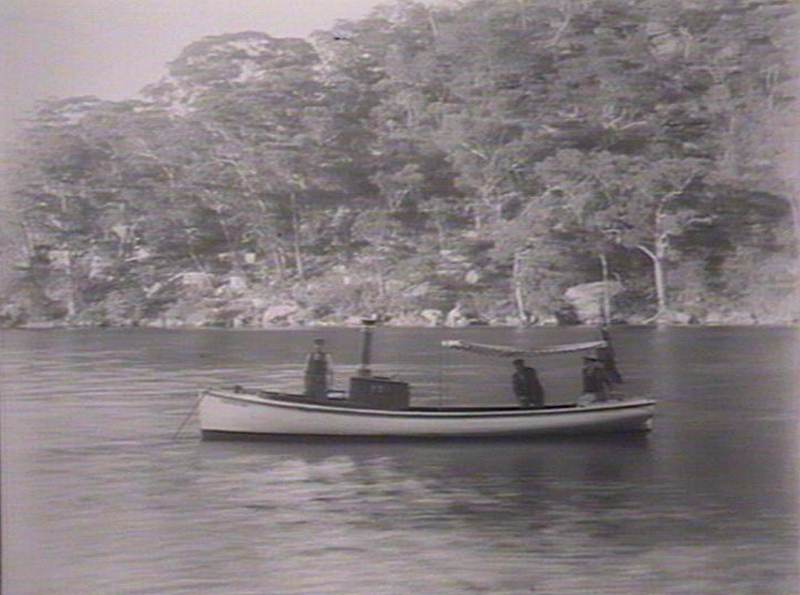
Trustees oil launch, Kuring-gai Bay, 1899. Image No.: d1_08775 and d1_08776, courtesy State Library of NSW
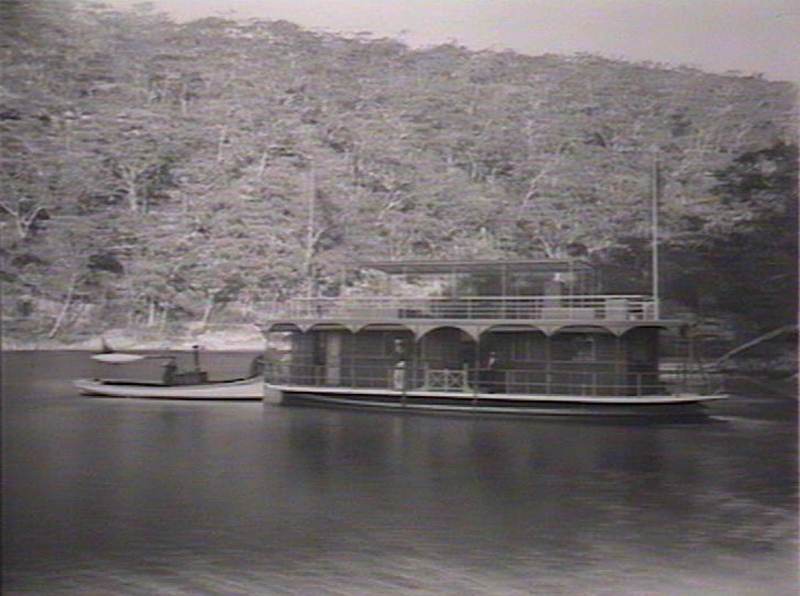
Another work which is being pushed forward is that of forming walking paths which skirt the edge of the different watercourses. Their cost of making is comparatively slight, and they enable the excursionist to wander over miles of otherwise inaccessible virgin tracts, and to enjoy delightful gems of scenery. Already several of these paths have been completed, but many more are needed. It is pointed out that a small expenditure in this direction would connect Coal and Candle Creek on the Cowan side with McCarr's Creek at Pittwater, or Refuge Bay with the Basin, and thus make these points within easy walking distance.
The work of protecting the flora is one of difficulty, and could be much assisted by the judicious construction of a little fencing so as to mark the points of egress from the Chase. In their endeavours to establish a native animal reserve the trustees meet with equal trouble, and point out that by the erection of a line of fencing from Duffy's wharf to the head of Smith's Creek some five or six thousand acres could be made absolutely secure for that purpose. Generally speaking it appears that a small expenditure would place Kuring-gai Chase in a fairway to accomplish all the aims for which it was intended. IN KURING-GAI CHASE. (1902, September 22). The Sydney Morning Herald (NSW : 1842 - 1954), p. 5. Retrieved from http://nla.gov.au/nla.news-article14506310
Nests And Eggs Of Australian Birds, Including The Geographical Distribution Of The Species And Popular Observations Thereon
by Archibald James Campbell (1901) - I'sephotus parrots